User Manual_ NM8PB99100(rev01)
User Guide
2
3
Please Read Before Proceeding
THE BATTERY IS NOT CHARGED WHEN YOU TAKE
IT OUT OF THE BOX.
DO NOT REMOVE THE BATTERY PACK WHEN THE
DEVICE IS CHARGING.
YOUR WARRANTY IS INVALIDATED IF YOU
DISASSEMBLE OR ATTEMPT TO DISASSEMBLE
THE DEVICE.
PRIVACY RESTRICTIONS
Some countries require full disclosure of
recorded telephone conversations, and stipulate
that you must inform the person with whom
you are speaking that the conversation is being
recorded. Always obey the relevant laws and
regulations of your country when using the
recording feature of your phone.
INTELLECTUAL PROPERTY RIGHT
INFORMATION
Copyright © 2009 HTC Corporation. All Rights
Reserved.
Copyright © 2009 Google Inc. Used with
permission.
HTC, hTC, and any and all HTC logos are the
trademarks and/or service marks of HTC
Corporation.
Google, the stylized Google logo, Android, and
the stylized Android logo are trademarks of
Google Inc.
4
Licensed by QUALCOMM Incorporated under
one or more of the following patents:
4,901,307 5,490,165 5,056,109 5,504,773
5,101,501 5,778,338
5,506,865 5,109,390 5,511,073 5,228,054
5,535,239 5,710,784
5,267,261 5,544,196 5,267,262 5,568,483
5,337,338 5,659,569
5,600,754 5,414,796 5,657,420 5,416,797
All other company, product and service names
mentioned herein are trademarks, registered
trademarks or service marks of their respective
owners.
HTC and Google shall not be liable for technical
or editorial errors or omissions contained herein,
nor for incidental or consequential damages
resulting from furnishing this material. The
information is provided “as is” without warranty
of any kind and is subject to change without
notice. HTC and Google also reserves the right to
revise the content of this document at any time
without prior notice.
No part of this document may be reproduced
or transmitted in any form or by any
means, electronic or mechanical, including
photocopying, recording or storing in a retrieval
system, or translated into any language in any
form without prior written permission of HTC
and Google.
5
Important Health Information and Safety
Precautions
When using this product, the safety precautions
below must be taken to avoid possible legal
liabilities and damages.
Retain and follow all product safety and
operating instructions. Observe all warnings in
the operating instructions on the product.
To reduce the risk of bodily injury, electric shock,
fire, and damage to the equipment, observe the
following precautions.
ELECTRICAL SAFETY
This product is intended for use when supplied
with power from the designated battery
or power supply unit. Other usage may be
dangerous and will invalidate any approval given
to this product.
SAFETY PRECAUTIONS FOR PROPER
GROUNDING INSTALLATION
CAUTION: Connecting to an improperly
grounded equipment can result in an electric
shock to your device.
This product equipped with a USB Cable for
connecting with desktop or notebook computer.
Be sure your computer is properly grounded
(earthed) before connecting this product to the
computer. The power supply cord of a desktop
or notebook computer has an equipment-
grounding conductor and a grounding plug. The
6
plug must be plugged into an appropriate outlet
which is properly installed and grounded in
accordance with all local codes and ordinances.
SAFETY PRECAUTIONS FOR POWER SUPPLY
UNIT
Use the correct external power source
A product should be operated only from
the type of power source indicated on the
electrical ratings label. If you are not sure of
the type of power source required, consult
your authorized service provider or local power
company. For a product that operates from
battery power or other sources, refer to the
operating instructions that are included with
the product.
This product should be operated only with the
following designated power supply unit(s):
AC Adapter
Phihong, Models PSAA05X-050 and PSC05R-
050
Handle battery packs carefully
This product contains a Li-ion battery. There
is a risk of fire and burns if the battery pack is
handled improperly. Do not attempt to open or
service the battery pack. Do not disassemble,
crush, puncture, short external contacts or
circuits, dispose of in fire or water, or expose a
battery pack to temperatures higher than 60˚C
(140˚F).
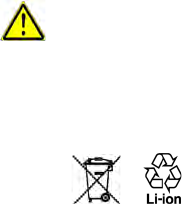
7
WARNING: Danger of explosion if battery
is incorrectly replaced. To reduce risk of
fire or burns, do not disassemble, crush,
puncture, short external contacts, expose to
temperature above 60° C (140° F), or dispose
of in fire or water. Replace only with specified
batteries. Recycle or dispose of used batteries
according to the local regulations or reference
guide supplied with your product.
Note:
This product should be operated only with the
following designated Battery Pack(s).
HTC, Model BB99100
Take extra precautions
Keep the battery or device dry and away from
water or any liquid as it may cause a short
circuit.
Keep metal objects away so they don’t come in
contact with the battery or its connectors as it
may lead to short circuit during operation.
The phone should be only connected to
products that bear the USB-IF logo or have
completed the USB-IF compliance program.
Do not use a battery that appears damaged,
deformed, or discolored, or the one that has
any rust on its casing, overheats, or emits a
foul odor.
8
Always keep the battery out of the reach of
babies and small children, to avoid swallowing
of the battery. Consult the doctor immediately
if the battery is swallowed.
If the battery leaks:
Do not allow the leaking fluid to come in
contact with skin or clothing. If already in
contact, flush the affected area immediately
with clean water and seek medical advice.
Do not allow the leaking fluid to come in
contact with eyes. If already in contact, DO
NOT rub; rinse with clean water immediately
and seek medical advice.
Take extra precautions to keep a leaking
battery away from fire as there is a danger of
ignition or explosion.

9
SAFETY PRECAUTIONS FOR DIRECT SUNLIGHT
Keep this product away from excessive moisture
and extreme temperatures. Do not leave the
product or its battery inside a vehicle or in places
where the temperature may exceed 60°C (140°F),
such as on a car dashboard, window sill, or
behind a glass that is exposed to direct sunlight
or strong ultraviolet light for extended periods of
time. This may damage the product, overheat the
battery, or pose a risk to the vehicle.
PREVENTION OF HEARING LOSS
CAUTION: Permanent hearing loss may
occur if earphones or headphones are used
at high volume for prolonged periods of
time.
NOTE: For France, Earphone (listed below) for
this device have been tested to comply with
the Sound Pressure Level requirement laid
down in the applicable NF EN 50332-1:2000
and/or NF EN 50332-2:2003 standards as
required by French Article L. 5232-1.
Earphone, manufactured by HTC, Model RC
E151.
SAFETY IN AIRCRAFT
Due to the possible interference caused by this
product to an aircraft’s navigation system and
its communications network, using this device’s
phone function on board an airplane is against
the law in most countries. If you want to use this
device when on board an aircraft, remember
10
to turn off your phone by switching to Airplane
Mode.
ENVIRONMENT RESTRICTIONS
Do not use this product in gas stations, fuel
depots, chemical plants or where blasting
operations are in progress, or in potentially
explosive atmospheres such as fuelling areas,
fuel storehouses, below deck on boats, chemical
plants, fuel or chemical transfer or storage
facilities, and areas where the air contains
chemicals or particles, such as grain, dust, or
metal powders. Please be aware that sparks
in such areas could cause an explosion or fire
resulting in bodily injury or even death.
EXPLOSIVE ATMOSPHERES
When in any area with a potentially explosive
atmosphere or where flammable materials exist,
the product should be turned off and the user
should obey all signs and instructions. Sparks
in such areas could cause an explosion or fire
resulting in bodily injury or even death. Users are
advised not to use the equipment at refueling
points such as service or gas stations, and are
reminded of the need to observe restrictions
on the use of radio equipment in fuel depots,
chemical plants, or where blasting operations are
in progress. Areas with a potentially explosive
atmosphere are often, but not always, clearly
marked. These include fueling areas, below deck
on boats, fuel or chemical transfer or storage
11
facilities, and areas where the air contains
chemicals or particles, such as grain, dust, or
metal powders.
ROAD SAFETY
Vehicle drivers in motion are not permitted
to use telephony services with handheld
devices, except in the case of emergency. In
some countries, using hands-free devices as an
alternative is allowed.
SAFETY PRECAUTIONS FOR RF EXPOSURE
Avoid using your phone near metal structures
(for example, the steel frame of a building).
Avoid using your phone near strong
electromagnetic sources, such as microwave
ovens, sound speakers, TV and radio.
Use only original manufacturer-approved
accessories, or accessories that do not contain
any metal.
Use of non-original manufacturer-approved
accessories may violate your local RF exposure
guidelines and should be avoided.
INTERFERENCE WITH MEDICAL EQUIPMENT
FUNCTIONS
This product may cause medical equipment to
malfunction. The use of this device is forbidden
in most hospitals and medical clinics.
If you use any other personal medical device,
12
consult the manufacturer of your device to
determine if they are adequately shielded from
external RF energy. Your physician may be able
to assist you in obtaining this information.
Turn your phone OFF in health care facilities
when any regulations posted in these areas
instruct you to do so. Hospitals or health care
facilities may be using equipment that could be
sensitive to external RF energy.
HEARING AIDS
Some digital wireless phones may interfere
with some hearing aids. In the event of such
interference, you may want to consult your
service provider, or call the customer service line
to discuss alternatives.
NONIONIZING RADIATION
Your device has an internal antenna. This product
should be operated in its normal-use position
to ensure the radiative performance and safety
of the interference. As with other mobile radio
transmitting equipment, users are advised that
for satisfactory operation of the equipment and
for the safety of personnel, it is recommended
that no part of the human body be allowed to
come too close to the antenna during operation
of the equipment.
Use only the supplied integral antenna. Use of
unauthorized or modified antennas may impair
call quality and damage the phone, causing loss
of performance and SAR levels exceeding the
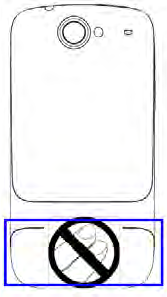
13
recommended limits as well as result in non-
compliance with local regulatory requirements
in your country.
To assure optimal phone performance and
ensure human exposure to RF energy is within
the guidelines set forth in the relevant standards,
always use your device only in its normal-use
position. Contact with the antenna area may
impair call quality and cause your device to
operate at a higher power level than needed.
Avoiding contact with the antenna area when
the phone is IN USE optimizes the antenna
performance and the battery life.
14
General Precautions
Avoid applying excessive pressure to the
device
Do not apply excessive pressure on the screen
and the device to prevent damaging them and
remove the device from your pants’ pocket
before sitting down. It is also recommended
that you store the device in a protective case
and only use your finger when interacting with
the touch screen. Cracked display screens due
to improper handling are not covered by the
warranty.
Device getting warm after prolonged use
When using your device for prolonged periods
of time, such as when you’re talking on the
phone, charging the battery or browsing the
web, the device may become warm. In most
cases, this condition is normal and therefore
should not be interpreted as a problem with
the device.
Heed service markings
Except as explained elsewhere in the
Operating or Service documentation, do not
service any product yourself. Service needed
on components inside the device should be
done by an authorized service technician or
provider.
Damage requiring service
Unplug the product from the electrical outlet
and refer servicing to an authorized service
technician or provider under the following
conditions:
Liquid has been spilled or an object has
15
fallen onto the product.
The product has been exposed to rain or
water.
The product has been dropped or damaged.
There are noticeable signs of overheating.
The product does not operate normally
when you follow the operating instructions.
Avoid hot areas
The product should be placed away from heat
sources such as radiators, heat registers, stoves,
or other products (including amplifiers) that
produce heat.
Avoid wet areas
Never use the product in a wet location.
Avoid using your device after a dramatic
change in temperature
When you move your device between
environments with very different temperature
and/or humidity ranges, condensation
may form on or within the device. To avoid
damaging the device, allow sufficient time for
the moisture to evaporate before using the
device.
NOTICE:
When taking the device from low-temperature
conditions into a warmer environment or from
high-temperature conditions into a cooler
environment, allow the device to acclimate to
room temperature before turning on power.
Avoid pushing objects into product
Never push objects of any kind into cabinet
16
slots or other openings in the product. Slots
and openings are provided for ventilation.
These openings must not be blocked or
covered.
Mounting accessories
Do not use the product on an unstable table,
cart, stand, tripod, or bracket. Any mounting of
the product should follow the manufacturer’s
instructions, and should use a mounting
accessory recommended by the manufacturer.
Avoid unstable mounting
Do not place the product with an unstable
base.
Use product with approved equipment
This product should be used only with
personal computers and options identified as
suitable for use with your equipment.
Adjust the volume
Turn down the volume before using
headphones or other audio devices.
Cleaning
Unplug the product from the wall outlet before
cleaning. Do not use liquid cleaners or aerosol
cleaners. Use a damp cloth for cleaning, but
NEVER use water to clean the LCD screen.
17
Regulatory Notices
Regulatory Agency Identifications
For regulatory identification purposes, your
product is assigned a model number of
PB99100
.
To ensure continued reliable and safe operation
of your device, use only the accessories listed
below with your PB99100.
The Battery Pack has been assigned a model
number of BB99100.
Note This product is intended for use with a
certified Class 2Limited Power Source, rated
5 Volts DC, maximum 1 Amp power supply
unit.
European Union Notice
Products with CE marking comply with the
R&TTE Directive (99/5/EC), the EMC Directive
(2004/108/EC), and the Low Voltage Directive
(2006/95/EC) issued by the Commission of the
European Community.
Compliance with these directives implies
conformity to the following European Norms
(in parentheses are the equivalent international
standards).
EN 60950-1 (IEC 60950-1) Safety of Information
Technology Equipment.
ETSI EN 301 511 Global system for mobile
communications (GSM); Harmonized EN for
mobile stations in the GSM 900 and GSM 1800
bands, covering essential requirements of article
3.2of the R&TTE directive (1995/5/EC).
18
ETSI EN 301 908-1 & -2 Electromagnetic
compatibility and Radio spectrum Matters
(ERM); Base Stations (BS), Repeaters and User
Equipment (UE) for IMT-2000 Third Generation
cellular networks; Part 1: Harmonized EN for IMT-
2000, introduction and common requirements,
covering essential requirements of article 3.2of
the R&TTE Directive.
ETSI EN 300 328 Electromagnetic compatibility
and Radio spectrum Matters (ERM); Wideband
Transmission systems; data transmission
equipment operating in the 2.4 GHz ISM
band and using spread spectrum modulation
techniques ;Harmonized EN covering essential
requirements under Article 3(2) of the R&TTE
Directive
EN 300 440-2 Electromagnetic compatibility
and Radio spectrum Matters (ERM); Short
range devices; Radio equipment to be used in
the 1 GHz to 40 GHz frequency range; Part 2:
Harmonized EN under Article 3(2) of the R&TTE
Directive.
EN 301 489-1 Electromagnetic compatibility and
Radio spectrum Matters (ERM); Electromagnetic
Compatibility (EMC) standard for radio
equipment and services; Part 1: Common
technical requirements
EN 301 489-3 Electromagnetic compatibility and
Radio spectrum Matters (ERM); ElectroMagnetic
Compatibility (EMC) standard for radio
equipment and services; Part 3: Specific
conditions for Short-Range Devices(SRD)
operating on frequencies between 9 kHz and
19
40 GHz.
EN 301 489-7 Electromagnetic compatibility and
Radio spectrum Matters (ERM); Electromagnetic
Compatibility (EMC) standard for radio
equipment and services; Part 7: Specific
conditions for mobile and portable radio and
ancillary equipment of digital cellular radio
telecommunications systems (GSM and DCS).
EN 301 489-17 Electromagnetic compatibility
and Radio spectrum Matters (ERM);
Electromagnetic Compatibility (EMC) standard
for radio equipment and services; Part 17:
Specific conditions for 2.4 GHz wideband
transmission systems.
EN 301 489-24 Electromagnetic compatibility
and Radio spectrum Matters (ERM);
Electromagnetic Compatibility (EMC) standard
for radio equipment and services; Part 24:
Specific conditions for IMT-2000 CDMA direct
spread (UTRA) for mobile and portable (UE) radio
and ancillary equipment
EN 55022 Information technology equipment;
Radio disturbance characteristics; Limits and
methods of measurement
EN 55024 Information technology equipment;
Immunity characteristics; Limits and methods of
measurement
EN 50360 Product standard to demonstrate
the compliance of mobile phones with the
basic restrictions related to human exposure to
electromagnetic fields(300 MHz ~ 3GHz).
EN 62311 Assessment of electronic and
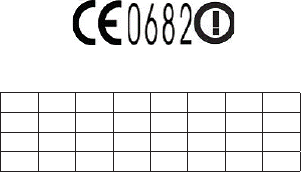
20
electrical equipment related to human exposure
restrictions for electromagnetic fields (0 Hz - 300
GHz).
EN 62209-1/ 62209-2 Human exposure to
radio frequency fields from hand-held and
body-mounted wireless communication
devices - Human models, instrumentation, and
procedures; Part 1: Procedure to determine
the specific absorption rate (SAR) for hand-
held devices used in close proximity to the ear
(frequency range of 300 MHz to 3GHz) ; Part 2:
Procedure to determine the Specific Absorption
Rate (SAR) in the head and body for 30 MHz to 6
GHz Handheld and Body-Mounted Devices used
in close proximity to the Body.
This equipment may be operated in:
AT BE BG CH CY CZ DE DK
EE ES FI FR GB GR HU IE
IT IS LI LT LU LV MT NL
NO PL PT RO SE SI SK TR
International Commission on Non-Ionizing
Radiation Protection (ICNIRP) 1996
21
Federal Communications Commission Notice
This device complies with part 15 of the FCC
Rules. Operation is subject to the following two
conditions: (1) This device may not cause harmful
interference, and (2) this device must accept any
interference received, including interference that
may cause undesired operation.
This equipment has been tested and found to
comply with the limits for a Class B digital device,
pursuant to Part 15 of the FCC Rules. These limits
are designed to provide reasonable protection
against harmful interference in a residential
installation.
This equipment generates, uses, and can radiate
radio frequency energy and, if not installed
and used in accordance with Appendix 247 the
instructions, may cause harmful interference
to radio communications. However, there is
no guarantee that interference will not occur
in a particular installation. If this equipment
does cause harmful interference to radio or
TV reception, which can be determined by
turning the equipment on and off, the user is
encouraged to try to correct the interference by
one or more of the following measures:
Reorient or relocate the receiving antenna.
Increase the separation between the
equipment and receiver.
Connect the equipment into an outlet on a
circuit different from that to which the receiver
is connected.
22
Consult the dealer or an experienced radio or
television technician for help.
Modifications
The FCC requires the user to be notified that any
changes or modifications made to the device
that are not expressly approved by High Tech
Computer Corporation may void the user’s
authority to operate the equipment.
FCC Hearing-Aid Compatibility (HAC)
Regulations for Wireless Devices
On July 10, 2003, the U.S. Federal
Communications Commission (FCC) Report
and Order in WT Docket 01-309 modified the
exception of wireless phones under the Hearing
Aid Compatibility Act of 1988 (HAC Act) to
require digital wireless phones be compatible
with hearing-aids. The intent of the HAC Act is to
ensure reasonable access to telecommunications
services for persons with hearing disabilities.
While some wireless phones are used near some
hearing devices (hearing aids and cochlear
implants), users may detect a buzzing, humming,
or whining noise. Some hearing devices are
more immune than others to this interference
noise, and phones also vary in the amount of
interference they generate.
The wireless telephone industry has developed
a rating system for wireless phones, to assist
hearing device users find phones that may be
compatible with their hearing devices. Not all
phones have been rated. Phones that are rated

23
have the rating on their box or a label located
on the box.
The ratings are not guarantees. Results will vary
depending on the user’s hearing device and
hearing loss. If your hearing device happens to
be vulnerable to interference, you may not be
able to use a rated phone successfully. Trying out
the phone with your hearing device is the best
way to evaluate it for your personal needs.
M-Ratings: Phones rated M3 or M4 meet FCC
requirements and are likely to generate less
interference to hearing devices than phones that
are not labeled. M4 is the better/higher of the
two ratings. PB99100 is rated M4.
Hearing devices may also be rated. Your
hearing device manufacturer or hearing health
professional may help you find this rating. Higher
ratings mean that the hearing device is relatively
immune to interference noise. The hearing aid
and wireless phone rating values are then added
together. A sum of 5 is considered acceptable for
normal use. A sum of 6 is considered for better
use. A sum of 8 is considered for best use.
In the above example, if a hearing aid meets the
M2 level rating and the wireless phone meets the
M3 level rating, the sum of the two values equal
M5. This should provide the hearing aid user with
“normal usage” while using their hearing aid with
24
the particular wireless phone. “Normal usage” in
this context is defined as a signal quality that is
acceptable for normal operation.
The M mark is intended to be synonymous
with the U mark. The T mark is intended to be
synonymous with the UT mark. The M and T
marks are recommended by the Alliance for
Telecommunications Industries Solutions (ATIS).
The U and UT marks are referenced in Section
20.19 of the FCC Rules. The HAC rating and
measurement procedure are described in the
American National Standards Institute (ANSI)
C63.19 standard.
Safety Precautions for RF Exposure
Use only original manufacturer-approved
accessories, or accessories that do not contain
any metal.
Use of non-original manufacturer-approved
accessories may violate your local RF exposure
guidelines and should be avoided.
Exposure to Radio Frequency (RF) Signals
Your device contains a radio transmitter and
receiver. The radiated output power is far below
the international radio frequency exposure
limits. These limits are part of comprehensive
guidelines and establish permitted levels of
RF energy for the general population. The
guidelines are based on the safety standards
previously set by international standards bodies:
American National Standards Institute (ANSI)
IEEE. C95.1-1992
25
National Council on Radiation Protection and
Measurement (NCRP).Report 86. 1986
International Commission on Non-Ionizing
Radiation Protection (ICNIRP) 1996
Ministry of Health (Canada), Safety Code 6. The
standards include a substantial safety margin
designed to assure the safety of all persons,
regardless of age and health.
The exposure standard for wireless mobile
phones employs a unit of measurement known
as the Specific Absorption Rate, or SAR. The
standard incorporates a substantial margin of
safety to give additional protection for the public
and to account for any variations in usage.
As with other mobile radio transmitting
equipment, users are advised that for satisfactory
operation of the equipment and for the safety of
personnel, it is recommended that no part of the
human body be allowed to come too close to the
antenna during operation of the equipment.
Your device has an internal antenna. Use only the
supplied integral antenna. Use of unauthorized
or modified antennas may impair call quality and
damage the phone, causing loss of performance
and SAR levels exceeding the recommended
limits as well as result in non-compliance with
local regulatory requirements in your country.
To assure optimal phone performance and
ensure human exposure to RF energy is within
the guidelines set forth in the relevant standards;
always use your device only in its normal-use
position. Do not touch or hold the antenna area
26
unnecessarily when placing or receiving a phone
call. Contact with the antenna area may impair
call quality and cause your device to operate
at a higher power level than needed. Avoiding
contact with the antenna area when the phone is
IN USE optimizes the antenna performance and
the battery life.
Tests for SAR are conducted using standard
operating positions specified by the FCC with the
phone transmitting at its highest certified power
level in all tested frequency bands. Although
the SAR is determined at the highest certified
power level, the actual SAR level of the phone
while operation can be well below the maximum
value. This is because the phone is designed to
operate at multiple power levels so as to use
only the power required to reach the network.
In general, the closer you are to a wireless base
station antenna, the lower the power output.
Before a phone model is available for sale to the
public, it must be tested and certified to the FCC
that it does not exceed the limit established by
the government-adopted requirement for safe
exposure. The tests are performed in positions
and locations (for example, at the ear and
worn on the body) as required by the FCC for
each model. (Bodyworn measurements may
differ among phone models, depending upon
available accessories and FCC requirements). For
body worn operation, to maintain compliance
with FCC RF exposure guidelines, use only
original manufacturer approved accessories.
When carrying the phone while it is on, use
the specific original manufacturer supplied or
27
approved carrying case, holster, or other body-
worn accessory.
Body-worn measurements were tested for typical
body-worn operations with the back of the
device kept 1.5 cm from the body.
SAR Information
0.823 w/kg @10g (Head)
1.53 w/kg @10g (Body)
0.867 w/kg @1g (Head)
1.39w/kg @1g (Body)
Telecommunications & Internet Association
(TIA) Safety Information
Pacemakers The Health Industry Manufacturers
Association recommends that a minimum
separation of six inches be maintained between
a handheld wireless phone and a pacemaker to
avoid potential interference with the pacemaker.
These recommendations are consistent with the
independent research by and recommendations
of Wireless Technology Research. Persons with
pacemakers:
Should ALWAYS keep the phone more than six
inches from their pacemaker when the phone
is turned ON.
Should not carry the phone in a breast pocket.
Should use the ear opposite the pacemaker to
minimize the potential for interference. If you
have any reason to suspect that interference is
28
taking place, turn the phone OFF immediately.
Hearing Aids Some digital wireless phones may
interfere with some hearing aids. In the event of
such interference, you may want to consult your
service provider, or call the customer service line
to discuss alternatives.
Other Medical Devices If you use any
other personal medical device, consult the
manufacturer of your device to determine if
they are adequately shielded from external RF
energy. Your physician may be able to assist you
in obtaining this information.
Turn the phone OFF in health care facilities when
any regulations posted in these areas instruct
you to do so. Hospitals or health care facilities
may be using equipment that could be sensitive
to external RF energy.
WEEE Notice
The Directive on Waste Electrical and Electronic
Equipment (WEEE), which entered into force as
European law on 13th February 2003, resulted
in a major change in the treatment of electrical
equipment at end-of-life.
The purpose of this Directive is, as a first priority,
the prevention of WEEE, and in addition, to
promote the reuse, recycling and other forms of
recovery of such wastes so as to reduce disposal.

29
The WEEE logo (shown at the left) on the product
or on its box indicates that this product must
not be disposed of or dumped with your other
household waste. You are liable to dispose of all
your electronic or electrical waste equipment
by relocating over to the specified collection
point for recycling of such hazardous waste.
Isolated collection and proper recovery of your
electronic and electrical waste equipment
at the time of disposal will allow us to help
conserving natural resources. Moreover, proper
recycling of the electronic and electrical waste
equipment will ensure safety of human health
and environment. For more information about
electronic and electrical waste equipment
disposal, recovery, and collection points,
please contact your local city center, household
waste disposal service, shop from where you
purchased the equipment, or manufacturer of
the equipment.
RoHS Compliance
This product is in compliance with Directive
2002/95/EC of the European Parliament and of
the Council of 27 January 2003, on the restriction
of the use of certain hazardous substances in
electrical and electronic equipment (RoHS) and
its amendments.

2
AUG-2.0.0-100 Android User’s Guide
Legal
Copyright © 2009 Google Inc. Used with permission.
Google, the stylized Google logo, Android, the stylized Android logo, Android
Market, the stylized Android Market logo, Gmail, Google Apps, Google Calendar,
Google Checkout, Google Earth, Google Latitude, Google Maps, Google Talk,
Picasa, and YouTube are trademarks of Google Inc. All other company and product
names may be trademarks of the companies with which they are associated.

3
AUG-2.0.0-100 Android User’s Guide
Contents
Contents 3
About this guide 17
Your phone and accessories 19
What’s in the box 20
Getting to know your phone 21
Installing the battery, SIM, and SD card 22
Turning the phone on and off 23
To turn on the phone 23
To turn off the phone 23
Android basics 25
In this section 25
Launching Android the first time 26
Your Google Account 26
Additional accounts 27
Google services 27
Getting to know the Home screen 29
To waken the phone 29
To return to the Home screen 30
To view other parts of the Home screen 30
Using the touchscreen 31
Using the trackball 32
To use the trackball 32
Using the phone’s buttons 33
Using the onscreen keyboard 35
To enter text 36
To enter numbers, symbols, and other characters 36
To change the keyboard orientation 37
Editing text 38
To edit text 38
To select text 38
To cut or copy text 39
To paste text 39

Contents 4
AUG-2.0.0-100 Android User’s Guide
Opening and switching applications 40
To open and close the Applications tab 40
To open an application 41
To switch to a recently used application 41
Working with menus 42
Options menus 42
Context menus 42
Monitoring your phone’s status 44
Status icons 44
Notification icons 45
Managing notifications 46
To open the Notifications panel 46
To respond to a notification 47
To clear all notifications 47
To close the Notifications panel 47
Searching your phone and the web 48
To search your phone and the web by entering text 48
To search the web by speaking 50
Locking your screen 51
To lock your screen 51
Customizing the Home screen 52
To add an item to the Home screen 52
To move an item on the Home screen 52
To remove an item from the Home screen 53
To change the Home screen wallpaper 53
To rename a folder 53
Connecting quickly with your contacts 54
Optimizing battery life 55
To extend the life of your battery 55
To check the battery charge level 55
To monitor and control what uses the battery 55
Connecting to networks and devices 57
In this section 57
Connecting to mobile networks 58
To check which provider’s network you’re using 58
To disable data when roaming 58
To limit your data connection to 2G networks 59
To edit or create a new access point 59

Contents 5
AUG-2.0.0-100 Android User’s Guide
Connecting to Wi-Fi networks 60
To turn Wi-Fi on and connect to a Wi-Fi network 61
To receive notifications when open networks are in range 61
To add a Wi-Fi network 61
To forget a Wi-Fi network 62
Connecting to Bluetooth devices 63
To turn Bluetooth on or off 63
To change your phone’s Bluetooth name 63
To pair your phone with a Bluetooth device 64
To connect to a Bluetooth device 64
To configure which features of a Bluetooth device you want to use 65
To disconnect from a Bluetooth device 65
To unpair a Bluetooth device 65
Connecting to a computer via USB 66
To connect your phone to a computer via USB 66
To disconnect your phone from the computer 66
To safely remove the SD card from your phone 66
To format an SD card 67
Connecting to virtual private networks 68
Working with secure certificates 68
To add a VPN 68
To connect to a VPN 69
To disconnect from a VPN 69
Placing and receiving calls 71
In this section 71
Placing and ending calls 72
To open Phone 72
To place a call by dialing 72
To end a call 73
To quickly redial the last number you called 73
To disable phone calls (airplane mode) 73
Answering or rejecting calls 75
To answer a call 75
To reject a call 75
Working with the Call log 76
To open the Call log 76
To quickly dial a number in the Call log 76
To add an entry’s number to your Contacts 77
To take other actions on a Call log entry 77
To clear the Call log 77

Contents 6
AUG-2.0.0-100 Android User’s Guide
Calling your contacts 78
To call a contact 78
To call a favorite contact 78
Listening to your voicemail 79
To listen to your voicemail 79
Dialing by voice 80
To place a call by speaking 80
Options during a call 81
To place a call on hold 81
To mute the microphone during a call 82
To turn the speakerphone on or off 83
To switch between a Bluetooth headset and the phone 83
Managing multiple calls 84
To switch between current calls 84
To set up a conference call 84
To end a conference call and disconnect all callers 85
Contacts 87
In this section 87
Opening your contacts 88
To open your contacts 88
To open a list of your favorite contacts 89
To view details about a contact 89
Adding contacts 90
To add a new contact 90
Importing, exporting, and sharing contacts 91
To import contacts from your SIM card 91
To import contacts from your SD card 91
To export contacts to your SD card 92
To share a contact 92
Adding a contact to your favorites 93
To add a contact to your favorites 93
To remove a contact from your favorites list 93
Searching for a contact 94
To search for a contact 94
Editing contact details 95
To edit contact details 95
To change a contact’s default phone number 95
To divert all of a contact’s calls to your voicemail 96
To set a ringtone for a contact 96
To delete a contact 97

Contents 7
AUG-2.0.0-100 Android User’s Guide
Communicating with your contacts 98
To connect using Quick Contact for Android 98
To communicate with a contact 99
To call a contact’s default number 99
To send a text or multimedia message to a contact’s default number 99
Changing which contacts are displayed 100
To set whether contacts without phone numbers are displayed 100
To set which groups of contacts to display 100
Joining contacts 102
To join contacts 102
Separating contact information 103
To separate contact information 103
Accounts 105
In this section 105
Adding and removing accounts 106
To add an account 106
To remove an account 108
Configuring account sync and display options 110
To configure general sync settings 110
To sync information manually 111
To change an account’s sync settings 112
Gmail 113
In this section 113
Gmail is different 114
Opening Gmail and your Inbox 115
To open Gmail 115
To open your Inbox when Gmail is running 116
To switch Accounts 116
Reading your messages 117
To read a message 117
To reread a message 118
Composing and sending a message 119
To compose and send a message 119
Replying to or forwarding a message 120
To reply to or forward a message 120
Working with conversations in batches 121
Labeling a conversation 122
To label a conversation 122
To label a batch of conversations at once 122
To change a conversation’s labels 122

Contents 8
AUG-2.0.0-100 Android User’s Guide
Starring a message 123
To star a message 123
To unstar a message 123
To unstar all messages in a conversation 123
Viewing conversations by label 124
Reporting spam 125
To report a conversation as spam 125
Searching for messages 126
Archiving conversations 127
Synchronizing your messages 128
To select which conversations to synchronize 128
To set how many days of conversations to synchronize 129
Appending a signature to your messages 130
Changing Gmail settings 131
General Settings 131
Notification settings 131
Calendar 133
In this section 133
Viewing your calendar and events 134
To open your calendar 134
To change your calendar view 135
Working in Agenda view 136
To switch to Agenda view 136
To learn more about events in Agenda view 136
Working in Day view 137
To switch to Day view 137
To learn more about events in Day view 137
To add an event in Day view 137
Working in Week view 138
To switch to Week view 138
To learn more about events in Week view 138
To add an event in Week view 138
Working in Month view 139
To switch to Month view 139
To view more information about events in Month view 139
Viewing an event’s details 140
To view information about an event 140
Creating an event 141
To create an event 141
Editing or deleting an event 142
To edit an event 142
To delete an event 142

Contents 9
AUG-2.0.0-100 Android User’s Guide
Setting a reminder for an event 143
To set a reminder for an event 143
To delete an event reminder 143
Responding to an event reminder 144
To respond to an event reminder 144
Displaying and synchronizing calendars 145
To show or hide calendars 145
To set which calenders are synchronized on your phone 145
Changing Calendar settings 146
Google Talk 147
In this section 147
Signing in and opening your Friends list 148
To open Google Talk and sign in 148
To return to your Friends list 148
To sign out of Google Talk 149
Chatting with friends 150
To chat with a friend 150
To accept an invitation to chat 150
To switch between active chats 151
To invite a friend to join a group chat 151
To chat on or off the record 151
To end a chat 151
Changing and monitoring online status 153
To change your online status 153
To change your status message 153
To change your picture 154
Managing your Friends list 155
To add a friend to your Friends list 155
To view and accept an invitation to become a friend 155
To view a list of pending invitations to friends 155
To view all friends or only those most popular with you 155
To pin a friend 156
To block a friend 156
Changing Google Talk settings 157
To configure notifications for new Google Talk messages 157
To show or hide the mobile indicator to friends 157
To set whether you sign into Google Talk automatically 157
Email 159
In this section 159

Contents 10
AUG-2.0.0-100 Android User’s Guide
Opening Email and reading your messages 160
To open Email 160
To open the Accounts screen 160
To open an account’s mailboxes screen 161
To read a message 162
Responding to a message 163
To reply to or forward a message 163
To mark a message as unread 163
To delete a message 163
Composing and sending email 164
To compose and send a message 164
Adding and editing email accounts 165
To add an email account 165
To change an account’s settings 165
To delete an email account 166
Changing email account settings 167
Messaging 169
In this section 169
Opening Messaging 170
To open Messaging 170
To delete a message thread from the Messaging window 170
Exchanging messages 171
To send a text message 171
To create and send a multimedia message 173
To respond to messages you receive 173
To view details about a message 174
Changing Messaging settings 175
Storage settings 175
Text message (SMS) settings 175
Multimedia message (MMS) settings 175
Notification settings 176
Browser 177
In this section 177
Opening Browser 178
To open Browser 178
To go to a webpage 179
To refresh the current page 179
To stop opening a page 179
To get more information about the current page 179
To set your home page 179

Contents 11
AUG-2.0.0-100 Android User’s Guide
Navigating within a webpage 181
To scroll a webpage 181
To zoom in or out on a webpage 181
To quickly zoom into a section of a webpage 181
To find text on a webpage 182
Navigating among webpages 183
To open a link 183
To go back and forward among the pages you’ve opened 183
To view your Browser history 183
To view your most frequently visited pages 184
To follow shortcuts for links, phone numbers, and addresses 184
Working with multiple Browser windows 185
To open a new Browser windows 185
To switch Browser windows 185
To close a Browser window 186
Downloading files 187
To allow installing applications from the web or email 187
To download a file 187
To cancel a download 187
To view the files you’ve downloaded 187
Working with bookmarks 188
To bookmark a webpage 188
To open a bookmark 188
To edit a bookmark 188
To share a bookmark 189
To add a bookmark shortcut to the Home screen 189
To delete a bookmark 189
Changing Browser settings 190
Page content settings 190
Privacy settings 191
Security settings 192
Advanced settings 192
Maps 193
In this section 193
Opening Maps and viewing your location 194
To use location services with Maps 194
To open Maps and find your location 194
To move the map 195
To zoom in and out of a map 195
To get an address and additional information for a location 195
To clear the map 196

Contents 12
AUG-2.0.0-100 Android User’s Guide
Changing map layers 197
To view map, satellite, or traffic layers 197
To open Street View for a location 198
To navigate in Street View 199
Searching for locations and places 200
To search for a location 200
Getting directions 201
To get directions 201
Finding your friends with Google Latitude 202
To join Latitude 202
To open Latitude 202
To invite friends to share their locations 202
To respond to an invitation 203
To view your friends’ locations 203
To connect with and manage connections with your friends 203
To control what you share 204
Camera 205
In this section 205
Opening Camera and taking pictures 206
To open Camera 206
To take a picture 206
To take pictures with digital zoom 207
To shoot a video 208
Reviewing your pictures 209
To review your pictures 209
Reviewing your videos 210
To review your videos 210
Changing Camera settings 211
To change Camera settings 211
Camera settings 211
Scene modes 212
Camcorder settings 213
Gallery 215
In this section 215
Opening Gallery and viewing your albums 216
To open Gallery and view your albums 216

Contents 13
AUG-2.0.0-100 Android User’s Guide
Working with pictures 218
To view and browse pictures 218
To watch a slideshow of your pictures 218
To rotate a picture 218
To crop a picture 219
To use a picture as a contact icon or as Home screen wallpaper 219
To get details about a picture 219
To view the location of a picture in Google Maps 220
To share a picture by sending it to friends 220
To share a picture by uploading it to Picasa 220
To delete a picture 220
Working with videos 221
To play videos 221
To share a picture by sending it to friends 221
To share videos on YouTube 222
To delete a video 222
Changing Gallery settings 223
General settings 223
Slideshow settings 223
YouTube 225
In this section 225
Opening YouTube and watching videos 226
To open YouTube 226
To watch and interact with YouTube videos 226
To search for videos 227
To share your videos on YouTube 227
Music 229
In this section 229
Transferring music files to your phone 230
To copy music files onto the phone’s SD card 230
Opening Music and working with your library 231
To open Music and view your music library 231
To search for music in your library 232
To delete a song from the SD card 232
Playing music 233
To play music 233
To control playback 234
To control playback volume 234
To play all your tracks in a shuffle 234
To use a song as a ringtone 234

Contents 14
AUG-2.0.0-100 Android User’s Guide
Working with playlists 236
To create a playlist 236
To add a song to a playlist 236
To rearrange songs in a playlist 236
To remove a song from a playlist 237
To rename or delete a playlist 237
To create playlists on your computer 237
Alarm Clock 239
In this section 239
Setting an Alarm 240
To set an alarm 240
Customizing Alarm Clock 242
To change the face of the alarm clock 242
To hide the alarm clock face entirely 242
To play alarms even when the phone is in Silent mode 242
Calculator 243
In this section 243
Using the Calculator 244
To open and use the Calculator 244
To access your history of operations 244
Market 245
In this section 245
Opening Android Market and finding applications 246
To open Android Market 246
To get help with Android Market 246
To browse for applications 246
To open a screen with details about an application 247
To search for applications 248
To return to the Android Market home screen 248
Downloading and installing applications 249
To download and install an application 249
To create a Google Checkout account 250
Managing your downloads 251
To view your downloaded applications 251
To uninstall an application 251
To request a refund for an application 251
To set whether you’re notified about updated applications 252
To rate an application 252
To flag inappropriate applications 252

Contents 15
AUG-2.0.0-100 Android User’s Guide
Settings 255
In this section 255
Opening Settings 256
To open Settings 256
Wireless & networks 257
Wireless controls screen 257
Wi-Fi settings screen 257
Advanced Wi-Fi settings screen 258
Bluetooth settings screen 258
VPN settings screen 258
Mobile networks settings screen 259
Call settings 260
Call settings screen 260
Additional settings 260
Fixed Dialing Numbers screen 260
Sound & display settings 262
Sound & display settings screen 262
Location & security settings 264
Applications settings 266
Applications settings screen 266
Application info screen 266
Development screen 267
Accounts & sync settings 268
Accounts & sync settings screen 268
Auto-sync 268
Manage accounts 268
Account screen 268
Privacy settings 269
SD card & phone storage settings 270
SD card & phone storage screen 270
Search settings 271
Search settings screen 271
Language & keyboard settings 272
Language & keyboard screen 272
Android keyboard settings screen 272
Device keyboard settings screen 273
Accessibility settings 274
Text-to-speech settings 275
Text-to-speech settings screen 275
Date & time settings 276
About phone 277
About phone screen 277

17
AUG-2.0.0-100 Android User’s Guide
About this guide
This guide describes your phone handset, its components and accessories, and how
to use release 2.0 of the Android™ mobile technology platform system and
applications.
GYour handset, its parts, preparing it for use, and the accessories that come with
it are described in “Your phone and accessories” on page 19.
GStarting Android the first time, signing into your Google Account, and perform-
ing basic Android tasks, including using Google™ search and Google search by
voice to find information on your phone and on the web, is described in
“Android basics” on page 25.
GConfiguring how your phone connects to mobile and Wi-Fi networks, Bluetooth
devices, and to a computer is described in “Connecting to networks and
devices” on page 57.
GUsing your phone to place, receive, and manage multiple calls is described in
“Placing and receiving calls” on page 71.
GOrganizing and finding contact information for the people you know is described
in “Contacts” on page 87.
GAdding and synchronizing different email and other accounts is described in
“Accounts” on page 105.
GSending and receiving messages using Gmail™ webmail service is described in
“Gmail” on page 113.
GViewing and creating events on your calendar and synchronizing them with the
Google Calendar™ calendaring service on the web is described in “Calendar”
on page 133.
GCommunicating with friends using the Google Talk™ instant messaging service
is described in “Google Talk” on page 147.
GConfiguring your phone so you can send and receive email via a conventional
email service is described in “Email” on page 159.
GExchanging text and multimedia messages with other phones is described in
“Messaging” on page 169.
GBrowsing the web on your phone is described in “Browser” on page 177.

About this guide 18
AUG-2.0.0-100 Android User’s Guide
GNavigating the world with street and satellite data from the Google Earth™
mapping service, getting directions, finding your location, sharing your location
with friends using Google Latitude™ user location service, and the many other
features available on your phone in the Google Maps™ mapping service are
described in “Maps” on page 193.
GTaking and previewing photos and videos is described in “Camera” on page 205.
GViewing, sharing, and uploading your photos to the Picasa™ photo organizing
software service and the YouTube™ user-generated content website is
described in “Gallery” on page 215.
GViewing YouTube videos is described in “YouTube” on page 225.
GListening to music is described in “Music” on page 229.
GSetting one or more alarms is described in “Alarm Clock” on page 239.
GCalculating the solution to simple and more complex math problems is
described in “Calculator” on page 243.
GFinding new applications on Android Market™ downloadable applications ser-
vice, purchasing paid applications with Google Checkout™ payment and billing
service, and installing them is described in “Market” on page 245.
GOpening the settings application and its many tools for configuring and custom-
izing your phone is described in “Settings” on page 255.
GDetails about your phone and its features are listed in “Specifications” on
page 279.

19
AUG-2.0.0-100 Android User’s Guide
Your phone and accessories
<<This chapter to be completed by phone manufacturer / carrier.>>

Your phone and accessories 20
AUG-2.0.0-100 Android User’s Guide
What’s in the box

Your phone and accessories 21
AUG-2.0.0-100 Android User’s Guide
Getting to know your phone

Your phone and accessories 22
AUG-2.0.0-100 Android User’s Guide
Installing the battery, SIM, and SD card

Your phone and accessories 23
AUG-2.0.0-100 Android User’s Guide
Turning the phone on and off
To turn on the phone
SPress the END-CALL / POWER button.
The first time you turn on the phone, you’re welcomed to Android and
prompted to sign in to your Google Account (see “Launching Android the first
time” on page 26).
When you turn on the phone, you may be prompted to enter a personal
identification number (PIN) for your SIM card, if it’s configured to require one.
If you entered the wrong PIN three times, the SIM card will be blocked and you
will not be able to use your phone. If this happens, you can unblock it with a
PUK (PIN Unblocking Key) obtained from your wireless service provider.
To turn off the phone
1Press and hold the END-CALL / POWER button until the menu opens.
2Touch Power off in the menu.
3Touch OK when asked to confirm that you want to turn off the phone.
For more about working with the touchscreen and menus, see “Android basics”
on page 25.

Your phone and accessories 24
AUG-2.0.0-100 Android User’s Guide

25
AUG-2.0.0-100 Android User’s Guide
Android basics
When you first turn on your phone, you have the opportunity to
learn more about it and to sign into your Google Account. Then its a
good idea to become familiar with the basics of your phone and how
to use it: the Home screen, the touchscreen and keys, applications,
search, and so on.
In this section
“Launching Android the first time” on page 26
“Getting to know the Home screen” on page 29
“Using the touchscreen” on page 31
“Using the trackball” on page 32
“Using the phone’s buttons” on page 33
“Using the onscreen keyboard” on page 35
“Editing text” on page 38
“Opening and switching applications” on page 40
“Working with menus” on page 42
“Monitoring your phone’s status” on page 44
“Managing notifications” on page 46
“Searching your phone and the web” on page 48
“Locking your screen” on page 51
“Customizing the Home screen” on page 52
“Connecting quickly with your contacts” on page 54
“Optimizing battery life” on page 55

Android basics 26
AUG-2.0.0-100 Android User’s Guide
Launching Android the first time
The first time you power on your phone (after setting it up, as described in “Your
phone and accessories” on page 19), you’re prompted to touch the Android logo
and to start using your phone. Then you’re offered a chance to learn about your
phone, you’re prompted to create or to sign into your Google Account, and you’re
asked to make some initial decisions about how you want to use Android and
Google features.
Your Google Account
You must sign into a Google Account to use Gmail, Google Talk, Google Calendar,
and other Google applications; to download applications from Android Market; to
back up your settings to Google servers; and to take advantage of other Google
services on your phone.
If you don’t have a Google Account, you’re prompted to create one.
If you have an enterprise Gmail account through your company or other
organization, your IT department may have special instructions on how to sign into
that account.
When you sign in, your contacts, Gmail messages, Calendar events, and other
information from these applications and services on the web are synchronized with
your phone.
<<cut for most deployments>>If you don’t sign into a Google Account during
setup, you will be prompted to sign in or to create a Google Account the first time
you start an application (such as Gmail or Android Market) that requires one.
When you sign in, you’re guided to enter your username and password in a pair of
text fields, using the onscreen keyboard. For information on navigating the
touchscreen and entering text, see “Using the touchscreen” on page 31 and “Using
the onscreen keyboard” on page 35.
<<Version for phone with physical keyboard: When you sign in, you’re guided to
open your keyboard so you can enter your username and password in a pair of text
fields. For more information, see <<x-ref to section on physical keyboard>>.>>
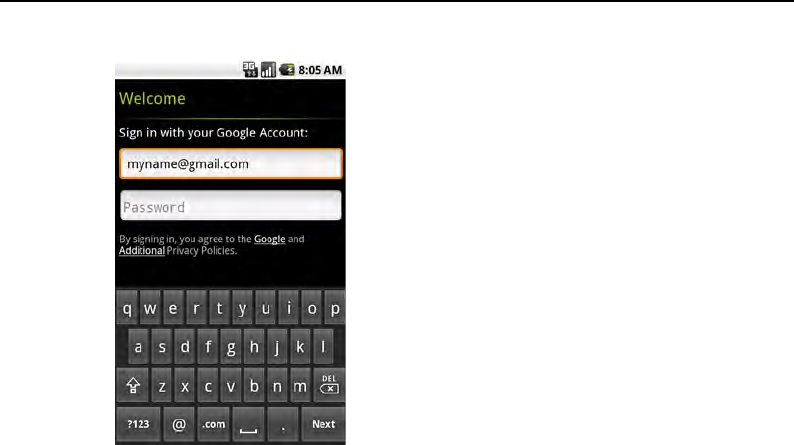
Android basics 27
AUG-2.0.0-100 Android User’s Guide
If you have a Google Account but have forgotten your password, you must reset it
before you can sign in. Use a web browser to visit http://www.google.com, click Sign
In, click “Can’t access your account?” in the sign-in box, and then follow the
instructions for resetting your password.
Additional accounts
After setup, you can add additional Google and other kinds of accounts to your
phone, and sync some or all of their data, as described in “Accounts” on page 105.
However, only the first Google Account you sign into is backed up to Google
servers, and some applications that only work with a single account (such as
Calendar) sync and display data only from the first account you sign into.
Google services
One you sign in, you’re asked whether you want to take advantage of several
Google services.
Location You can choose whether to take advantage of Google’s location
service, which provides applications with your approximate location without using
GPS, and whether to use your location for Google search results and other Google
services. To change these settings later, see “Location & security settings” on
page 264 and “Privacy settings” on page 269.
Touch to open the onscreen
keyboard, to enter your Google
Account username.
Touch (or touch Next on the
keyboard) to enter your password.
When you’re done, press Done on
the keyboard (or press the phone’s
BACK key) to close the onscreen
keyboard, so you can touch the Sign
In button at the bottom of the
screen.
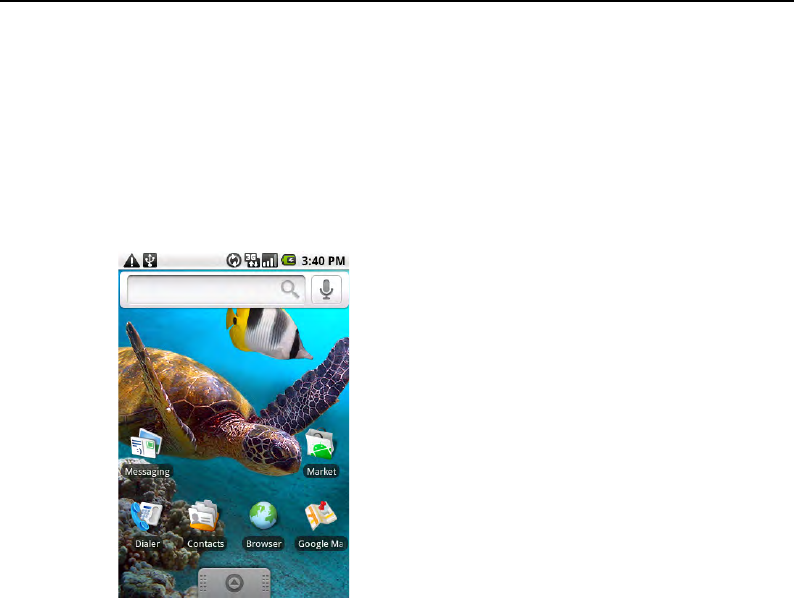
Android basics 29
AUG-2.0.0-100 Android User’s Guide
Getting to know the Home screen
Once you’ve signed in, the Home screen opens.
The Home screen is your starting point for all the features on your phone. It
displays application icons, widgets, shortcuts, and other features on top of its
wallpaper. You can customize the Home screen with different wallpaper and to
display the items you want (see “Customizing the Home screen” on page 52).
Along the top of the screen is the Status bar, which displays the time, information
about the status of your phone, and icons for notifications you’ve received. To learn
more, see “Monitoring your phone’s status” on page 44 and “Managing
notifications” on page 46.
You can touch the applications tab, at the bottom of the screen, to view all installed
applications. See “Opening and switching applications” on page 40.
To waken the phone
If you don’t use the phone for a while, the Home screen (or other screen you are
viewing) is replaced with the lock screen and then the screen darkens, to conserve
the battery.
The Status bar shows the time,
signal strength, battery status,
and other information. It also
displays notification icons.
Widgets are applications you can
use directly on the Home screen.
Touch an icon to open an
application, open a folder, and so
on.
Touch the applications tab to
open it and view icons for all
installed applications.
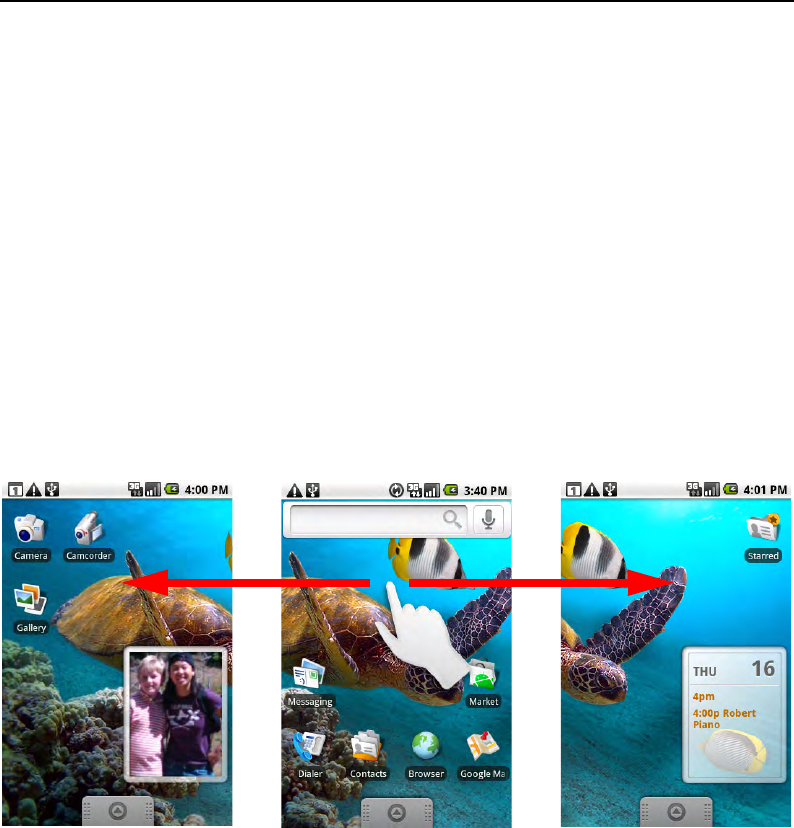
Android basics 30
AUG-2.0.0-100 Android User’s Guide
1Press the POWER button.
If you’ve locked your screen with a pattern, you must draw the unlock pattern
to unlock it. See “Locking your screen” on page 51.
Otherwise, the unsecure lock screen appears.
2Drag the lock icon to the right.
To return to the Home screen
SPress the HOME button at any time, in any application.
To view other parts of the Home screen
SSlide your finger left or right across the Home screen.
The left and right extensions to the Home screen provide more space for icons,
widgets, shortcuts, and other items. (For more on sliding, see “Using the
touchscreen” on page 31.)

Android basics 31
AUG-2.0.0-100 Android User’s Guide
Using the touchscreen
The main way to control Android features is by using your finger to directly
manipulate icons, buttons, menu items, the onscreen keyboard, and other items on
the touchscreen. You can also change the screen’s orientation.
To u ch When you want to act on items on the screen, such as application and
settings icons, and when you want to type letters and symbols using the onscreen
keyboard, or press onscreen buttons, you simply touch them with your finger.
To u c h & h o l d You touch & hold an item on screen by touching it and not lifting
your finger until an action occurs. For example, to open a menu for customizing the
Home screen, you touch an empty area on the Home screen until the menu opens;
then you lift your finger.
Drag Touch & hold an item for a moment and then without lifting your finger,
move your finger on the screen. Lift your finger when you reach the target position.
You drag items on the Home screen to reposition them (as described in
“Customizing the Home screen” on page 52 and you drag to open the Notifications
panel (as described in “Managing notifications” on page 46).
Swipe or slide To swipe or slide means to quickly move your finger across the
surface of the screen, without pausing when you first touch it (so you don’t drag an
item instead). For example, you slide the screen up or down to scroll a list; you
more quickly swipe across the screen to change the range of time visible in some
Calendar views.
Double-tap You double-tap, for example, by touching a section of a webpage
twice quickly in Browser, so the webpage zooms in and wraps the text in that
section to fit the width of the screen.
Rotate the screen On most screens, the orientation of the screen rotates
with the phone as you turn it from upright to sideways, and back again. (You can
turn this feature on or off as described in “Sound & display settings” on page 262.)
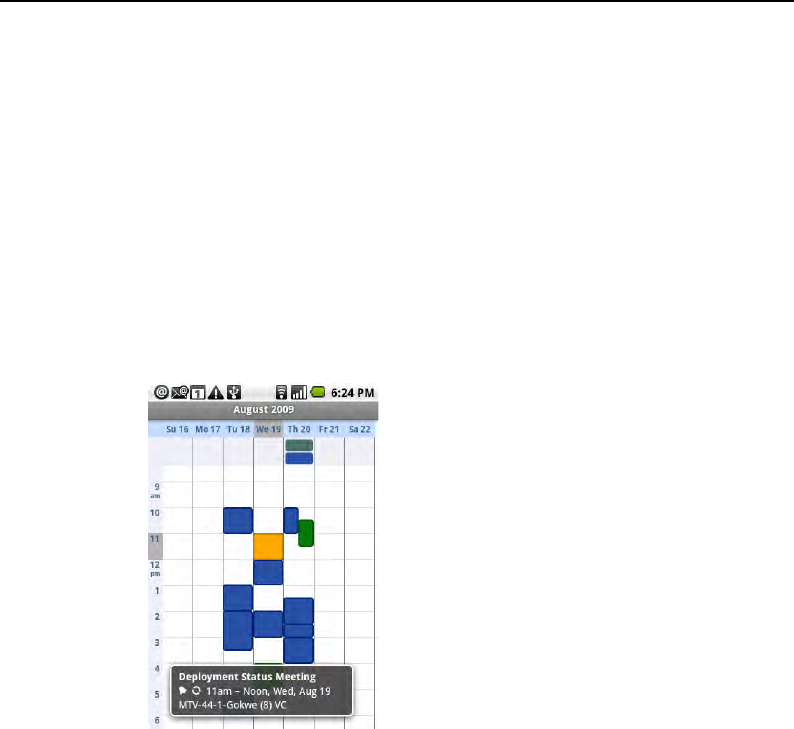
Android basics 32
AUG-2.0.0-100 Android User’s Guide
Using the trackball
<<This and other pages are easily searched for and modified for phones with a D-
Pad or other interface than a trackball.>>
Some actions, such as previewing or opening an event in a crowded calendar,
selecting a link or form field on a web page with many close elements, or selecting
where you want to edit text, are easier using the TRACKBALL than your finger.
To use the trackball
SRoll the TRACKBALL to select items on the screen.
The selected item is highlighted in orange.
SPressing the TRACKBALL is equivalent to touching the selected item with
your finger.
SPressing and holding the TRACKBALL is equivalent to touching & holding the
selected item with your finger.
Items you select with the
TRACKBALL are highlighted in
orange.

Android basics 33
AUG-2.0.0-100 Android User’s Guide
Using the phone’s buttons
The phone’s physical buttons offer a variety of functions and shortcuts. You can
change the default behavior of some of the actions in the following table with the
Settings application (see “Settings” on page 255).
<<Add icons and separate soft keys from hard; add Camera for phones with
Cameral hard keys.Delete CALL and other keys for some phones.>>
Button Press Press & hold
HOME Opens the Home screen. If you’re
viewing the left or right extended
Home screen, opens the central Home
screen.
Opens the recently used appli-
cations screen.
MENU Opens a menu with items that affect
the current screen or application.
Opens or closes the onscreen
keyboard. For phones with
physical keyboards, briefly
replaces the main menu’s labels
with the keyboard shortcuts.
BACK Opens the previous screen you were
working in. If the onscreen keyboard is
open, closes the keyboard.
Returns you to the application’s
main screen or to the Home
screen
SEARCH In most application, opens a search
box for the information in that applica-
tion. In other applications, opens
Quick Search Box. Press twice to open
Quick Search Box from any applica-
tion.
Opens Google search by voice.

Android basics 34
AUG-2.0.0-100 Android User’s Guide
CALL On most screens, opens the Phone
application.
Opens the voice dialer.
END-CALL /
POWER
When no call is in progress, turns off
the screen. When a call is in progress,
ends the call.
Opens a menu with options for
airplane mode, silent mode, and
for powering off the phone.
VOLUME UP /
DOWN
When no call is in progress, increases
or decreases the ringtone volume, or
sets the phone to vibrate instead of
ringing or to be silent. When a call is in
progress, increases or decreases the
call volume.
Quickly increases the ringtone
volume to maximum or silences
the phone.
Button Press Press & hold
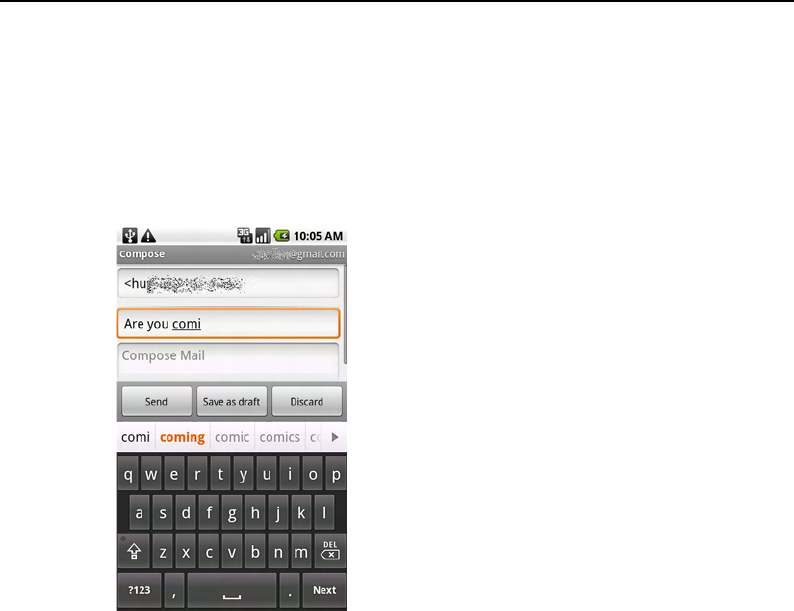
Android basics 35
AUG-2.0.0-100 Android User’s Guide
Using the onscreen keyboard
<<Mention hard keyboard for phones that have one.>>
You enter text using the onscreen keyboard. Some applications open the onscreen
keyboard automatically. In others, you touch a text field where you want to enter
text, to open the keyboard.
Press space or another
punctuation mark to enter the
red suggestion.
Touch a suggestion to enter it.
Touch & hold to add what
you’ve typed to the user
dictionary.
Touch once to capitalize the
next letter you type. Touch &
hold for all caps.
Touch to enter numbers or
symbols.

Android basics 36
AUG-2.0.0-100 Android User’s Guide
To enter text
1Touch a text field where you want to type
The onscreen keyboard opens.
For most text fields, the keyboard starts with letters displayed. Text fields for
phone numbers or other special purposes may display numbers and symbols or
other custom keyboards, to make it easier to enter the required information.
You can also use the TRACKBALL to select a text field and then press the
TRACKBALL to open the onscreen keyboard.
2Start typing, by touching the keys on the keyboard.
The characters you’ve entered appear in a strip above the keyboard, with
suggestions for the word you are trying to type to the right. Press the left or
right arrows in the strip to view more suggestions.
3Press space or a punctuation character to enter the suggested word in red.
OR
Touch another suggested word to enter it.
OR
Touch & hold the leftmost word to add it to the dictionary.
You can view, edit, or delete the words you add to the dictionary. See “Language
& keyboard settings” on page 272.
4Use the Delete key to erase characters to the left of the cursor.
5When you’re done typing, press BACK to close the keyboard.
To enter numbers, symbols, and other characters
SPress the symbols key to switch to the numbers and symbols keyboard. Press
the Alt key to view additional symbols; press it again to switch back.
STouch & hold a vowel or the C, N, or S key to open a small window where you
can touch an accented vowel or other alternate letter.
STouch & hold the period ( . ) key to open a small window, with a set of common
symbol keys you can touch to enter.
STouch & hold almost any of the number and symbols keyboard keys to open a
window of additional symbols.

Android basics 37
AUG-2.0.0-100 Android User’s Guide
To change the keyboard orientation
STurn the phone sideways or upright.
The keyboard redraws to take best advantage of the new phone orientation.
Many people find the larger, horizontal onscreen keyboard easier to type on.
You can control whether the screen changes orientation automatically when you
turn the phone with the Settings application (see “Language & keyboard
settings” on page 272).

Android basics 38
AUG-2.0.0-100 Android User’s Guide
Editing text
You can edit the text you enter in text fields and use menu commands to cut, copy,
and paste text, within or across applications.
To edit text
1Touch the text field with the text you want to edit.
2Use the TRACKBALL to move the cursor to the location where you want to
add or delete text.
The cursor is a vertical bar that indicates where text you type or paste will be
inserted.
3Type, cut, paste, or delete text.
4Press the BACK key when you’re done typing, to close the keyboard.
You may also have a Next or Done button on the keyboard, depending on the
application and text filed you’re typing in.
To select text
1Touch the text field or other portion of the screen that contains the text you
want to select.
2Use the TRACKBALL to move the cursor to the beginning or end of the text
you want to select.
3Touch & hold the text field.
A menu opens with options for working with text.
4Touch Select text.
Or touch Select all to select all the text in the text field.
5Roll the TRACKBALL to select the text you want.
6Touch & hold the text field again to open a menu you can use to cut or copy
your selection, select all the text, or stop selecting text.

Android basics 39
AUG-2.0.0-100 Android User’s Guide
To cut or copy text
1Select the text you want to cut or copy.
2Touch & hold the selected text.
3Touch Cut or Copy in the menu that opens.
If you touch Cut, the selected text is removed from the text field. In either case,
the text is stored in a temporary area on the phone, so you can paste it into
another text field if you want.
To p a s te t e x t
1Copy the text you want to paste.
2Touch the text field where you want to paste the text.
You can paste text you copied from one application into a text field in any
application.
3Use the TRACKBALL to move the cursor to the location where you want to
paste the text.
4Touch & hold the text field where you want to paste the text and in the menu
that opens, touch Paste.
The text is inserted at the cursor. The text you pasted also remains in a
temporary area on the phone, so you can paste that same text in another
location if you want.
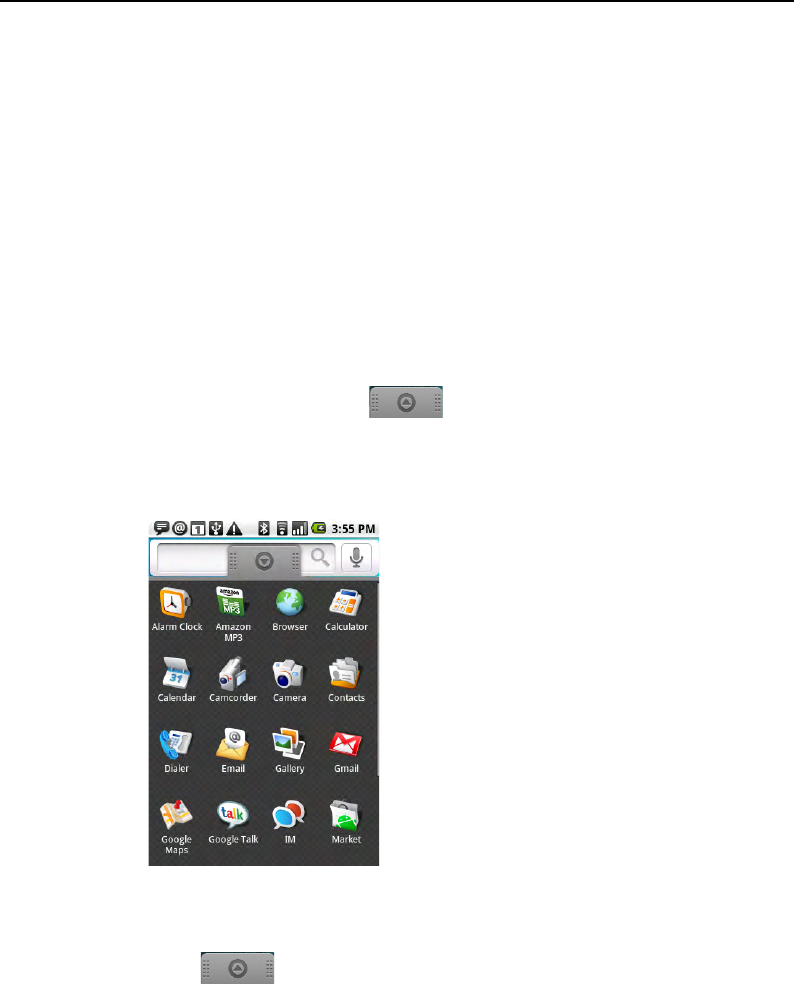
Android basics 40
AUG-2.0.0-100 Android User’s Guide
Opening and switching applications
The Applications tab, on the Home screen, holds icons for all the applications on
your phone, including any applications that you downloaded and installed from
Android Market or other sources.
When you open an application, its screens open, but the current application doesn’t
stop, it remains running: playing music, rendering a webpage, and so on. You can
quickly switch among your open applications, to work with several at once.
See “Market” on page 245 to learn how to discover and install additional
applications and games on your phone.
To open and close the Applications tab
SOn the Home screen, drag up from the bottom of Home screen.
You can also touch the Applications tab to open it.
If you have more applications than can fit on the tab in one view, you can scroll
to view more.
You can add an application icon to the Home screen by touching & holding it on
the Applications tab until it vibrates and then dragging it to a location on the
Home screen.
STouch at the top of the Applications tab to close it.
The Applications tab closes automatically if you touch an icon to open its
application or if you move an icon from the Applications tab to the Home
screen. But you can also use this method to close it manually.
Touch to close the Applications
tab
Touch an application to open it
Touch & hold an application icon
until it vibrates, then drag it to add
it the Home screen
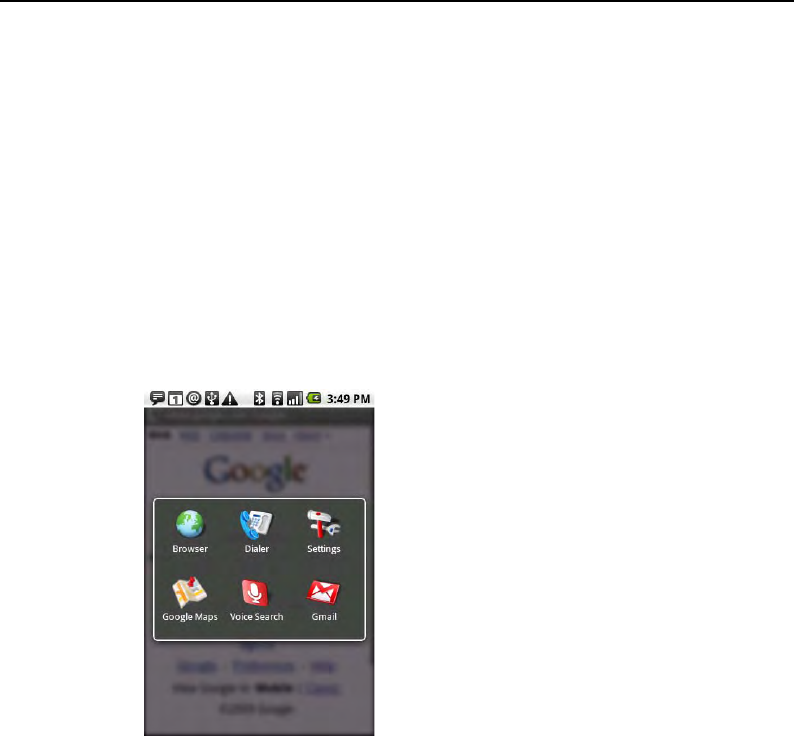
Android basics 41
AUG-2.0.0-100 Android User’s Guide
To open an application
STouch an application’s icon on the Home screen.
OR
STouch an application's icon on the Applications tab.
To switch to a recently used application
1Press and hold the HOME button.
A small window opens, with icons of applications you’ve used recently.
2Touch an icon to open its application.
Or press BACK to return to the current application.
Touch an icon to open an
application you’ve used
recently.
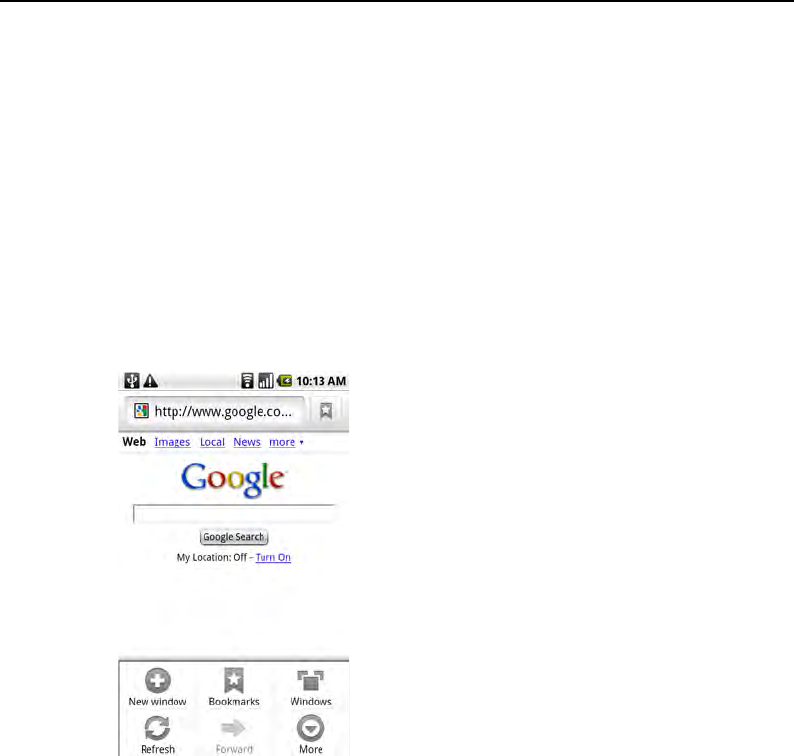
Android basics 42
AUG-2.0.0-100 Android User’s Guide
Working with menus
There are two kinds of Android menus: options menus and context menus.
Options menus
Options menus contain tools that apply to the activities of the current screen or
application, not to any specific item on the screen. You open options menus by
pressing the MENU button. Not all screens have options menus; if you press
MENU on a screen that has no options menu, nothing happens.
Some screens have more options menu items than can fit in the main menu: you
touch More to open a menu of additional items.
Context menus
Context menus contain tools that apply to a specific item on the screen. You open a
context menu by touching & holding an item on the screen. Not all items have
context menus; if you touch & hold an item that has no context menu, no menu
opens. You can also open a context menu for an item by selecting it with the
trackball and then pressing the TRACKBALL.
Options menus contain
items that apply to the
current screen or
application as a whole.
Touch to open a menu
of additional items.
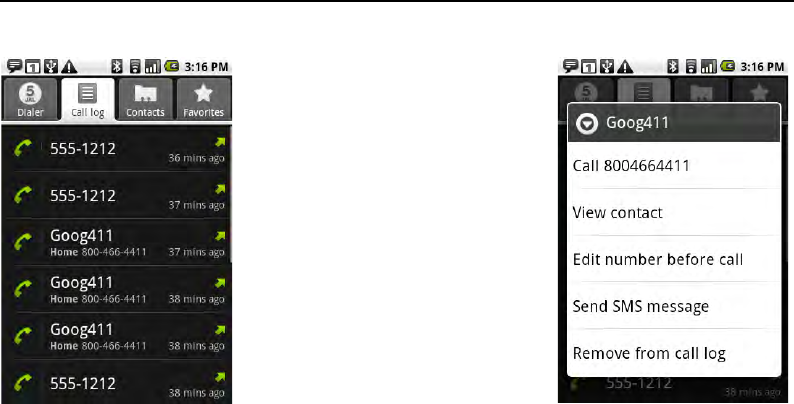
Android basics 43
AUG-2.0.0-100 Android User’s Guide
When you touch & hold some
items on screen, a context menu
opens.
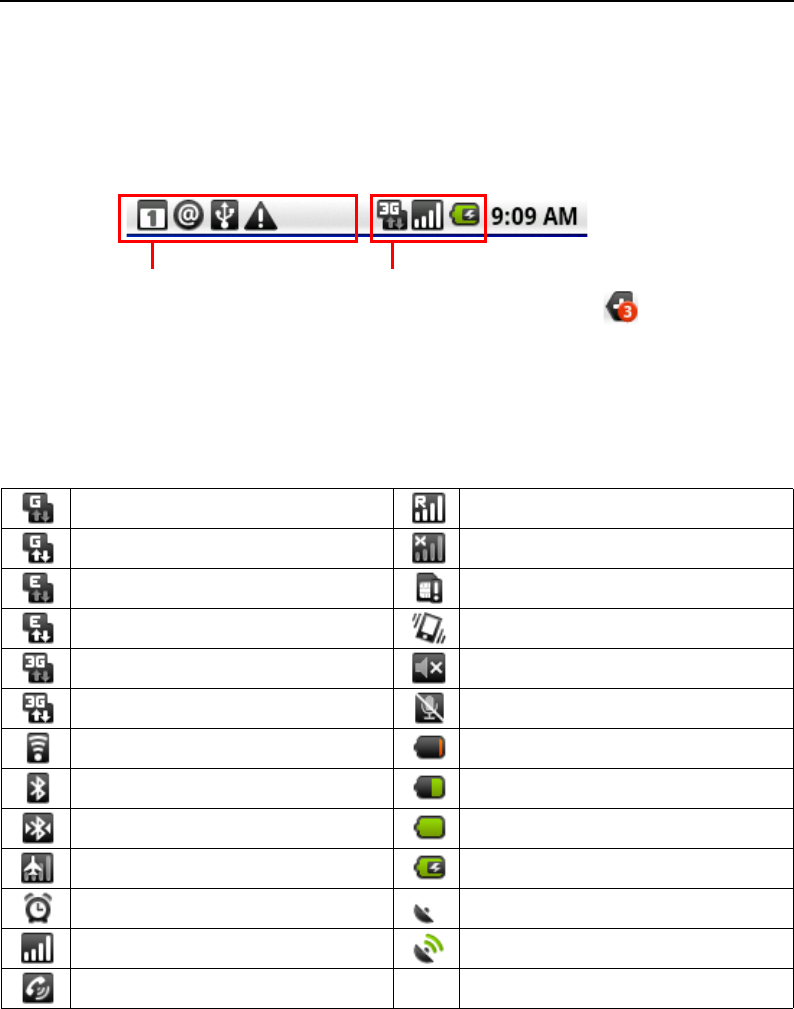
Android basics 44
AUG-2.0.0-100 Android User’s Guide
Monitoring your phone’s status
At the top of every screen is the status bar. It displays icons that indicate that you’ve
received notifications (on the left) and icons indicating the phone’s status (on the
right), along with the current time.
If you have more notifications than can fit in the status bar, prompts you to
open the Notifications panel to view them all (see “Managing notifications” on
page 46).
Status icons
The following icons indicate the status of your phone.<<Add 1x icon for CDMA>>
GPRS connected Roaming
GPRS in use No signal
EDGE connected No SIM card installed
EDGE in use Vibrate mode
3G connected Ringer is silenced
3G in use Phone microphone is mute
Connected to a Wi-Fi network Battery is very low
Bluetooth is on Battery is low
Connected to a Bluetooth device Battery is full
Airplane mode Battery is charging
Alarm is set GPS is on
Signal strength Receiving location data from GPS
Speakerphone on
Notification icons Status icons
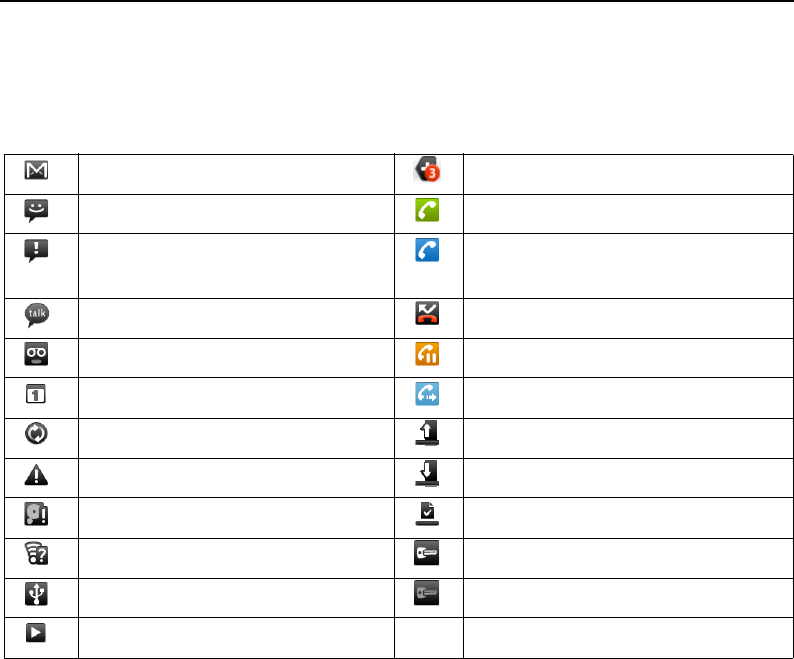
Android basics 45
AUG-2.0.0-100 Android User’s Guide
Notification icons
The following icons indicate that you’ve received a notification. See “Managing
notifications” on page 46 for information about responding to these notifications.
New Gmail message 3 more notifications not displayed
New text or multimedia message Call in progress
Problem with text or multimedia
message delivery
Call in progress using Bluetooth head-
set
New Google Talk message Missed call
New voicemail Call on hold
Upcoming event Call forwarding on
Data is syncing Uploading data
Problem with sign-in or sync Downloading data
SD card is full Download finished
An open Wi-Fi network is available Connected to VPN
Phone connected via USB cable Disconnected from VPN
Song is playing
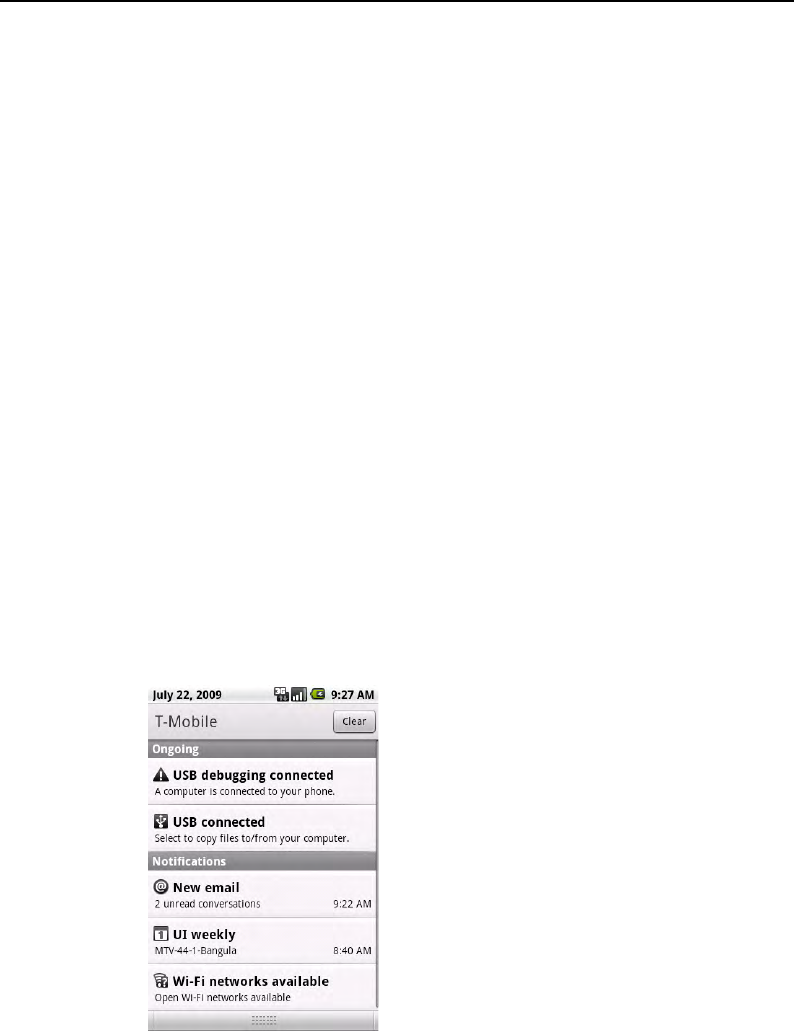
Android basics 46
AUG-2.0.0-100 Android User’s Guide
Managing notifications
Notification icons report the arrival of new messages, calendar events, alarms, as
well as ongoing events, such as when call forwarding is on or the current call status.
When you receive a notification, its icon and a brief summary appear in the status
bar, and then is replaced just by its icon. For a table of notification icons, see
“Notification icons” on page 45.
You can open the Notifications panel to view a list of all your notifications.
Depending on your settings and your model of phone, you may also hear a
notification sound, the phone may vibrate, and LEDs may blink as well.
Adjusting sound volume and other general notifications settings is described in
“Sound & display settings” on page 262.
Applications whose activities produce notifications, such as Gmail and Google Talk,
have their own settings you can use to configure whether and how they send
notifications. See the sections on those applications for details.
To open the Notifications panel
STouch the status bar and when the tab appears below it, drag it down.
On the Home screen, you can also press MENU and touch Notifications.
The Notifications panel displays your wireless provider at the top, followed by a
scrolling list of your current notifications, organized into ongoing and event-
based notifications.
Touch a notification to open it
in its application.

Android basics 47
AUG-2.0.0-100 Android User’s Guide
To respond to a notification
1Open the Notifications panel.
Your current notifications are listed in the panel, each with a brief description.
2Touch a notification you want to respond to.
The Notification panel closes and then what happens next depends on the
notification. For example, new voicemail notifications dial your voicemail box;
network disconnect notifications open the list of configured networks so you
can reconnect, and so on.
To clear all notifications
1Open the Notifications panel.
2Touch Clear at the top right of the panel.
All event-based notifications are cleared; ongoing notifications remain in the list.
To close the Notifications panel
SDrag the tab at the bottom of the Notifications panel to the top of the screen.
Or just press the BACK button.
The panel also closes when you touch a notification to respond to it.
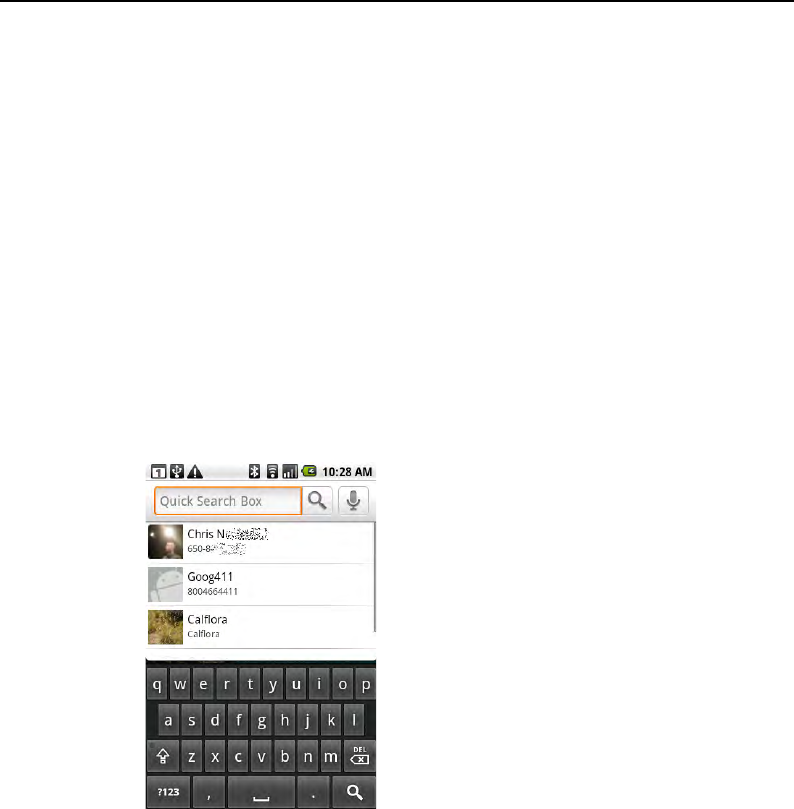
Android basics 48
AUG-2.0.0-100 Android User’s Guide
Searching your phone and the web
You can search for information on your phone and on the web, by typing in Quick
Search Box for Android or by speaking, with Google search by voice.
Some applications, such as Contacts, Gmail, and Maps, have their own search box,
which you can use to search within those applications (you know you’re in an
application’s own search box when its icon is at the left).
You can also dial a phone number with the Voice Search application, as described in
“Dialing by voice” on page 80.
To search your phone and the web by entering text
1Press the SEARCH button.
When you press the SEARCH button on the Home screen or in many other
applications, Quick Search Box opens.
Many applications, such as Gmail, Contacts, and Browser, make special use of
the Search button, which they indicate with an application icon to the left of
the search box. (See the sections about those applications for more information
about searching in them.) To search your phone and the web instead of that
application, press the Search button again to switch to Quick Search Box (in
other words, no matter what application you’re working in, pressing Search
twice opens Quick Search Box).
You can also search the web with the Search widget on the Home screen, if you
have added it there (see “Customizing the Home screen” on page 52).
2Type in Quick Search Box.
Enter what you want to search for
here
Touch to search by voice
Shortcuts to previously chosen
search results
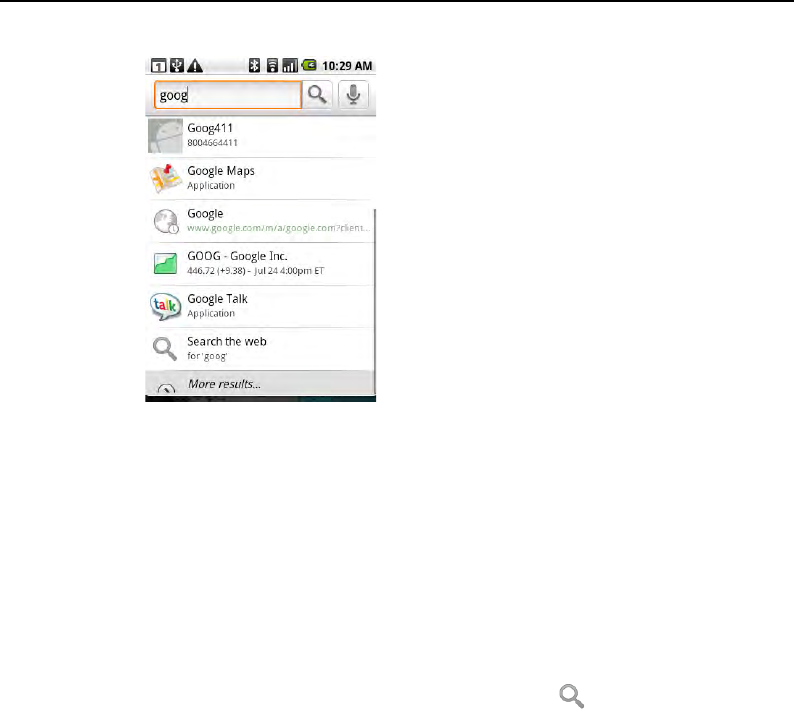
Android basics 49
AUG-2.0.0-100 Android User’s Guide
As you type, matching items on your phone and suggestions from Google web
search are added to the list of previously chosen search results.
You can use the Search preferences to configure some aspects of Google web
search (for example, whether it makes suggestions below Quick Search Box as
you type), and what phone features you want to include in searches. You can
also clear the list of recently chosen searches. See “Search settings” on
page 271.
3If what you’re searching for is in the list of suggestions, phone search results, or
previously chosen search results, touch it in the list.
The item opens in the appropriate application, such as Contacts or the Browser.
4If what you’re searching for is not in the list, touch to search the web.
The Browser opens, displaying results of a Google search on the web. (For more
information about working with Browser, see “Browser” on page 177.)
Touch to search the web
As you type, search results from
your phone, previously chosen
search results, plus web search
suggestions appear. Touch a
result to open it.

Android basics 50
AUG-2.0.0-100 Android User’s Guide
To search the web by speaking
SPress and hold the SEARCH button
OR
STouch the microphone icon in Quick Search Box.
(If you touch the microphone icon in an application’s search box, you search the
application by voice, not the web.)
A dialog opens, prompting you to speak the words you want to search for.
When you’re done speaking, Google search by voice analyzes your speech and
displays the results of your search.
Touch the Quick Search Box for a list of similar-sounding search terms, if
Google search by voice misunderstood you.
You can also preface your search by speaking special words, to take special
actions:
GSay “Call” followed by a name from your contacts, followed by the kind of
phone number (“mobile,” “work,” and so on), for example: “Call Mike
home.” If there is a single match, the number is dialed automatically (see
“Dialing by voice” on page 80).
GSay “Directions to” followed by an address to get directions to that location
from Google Maps.
GSay “Map of” followed by an address to view that location on Google Maps.
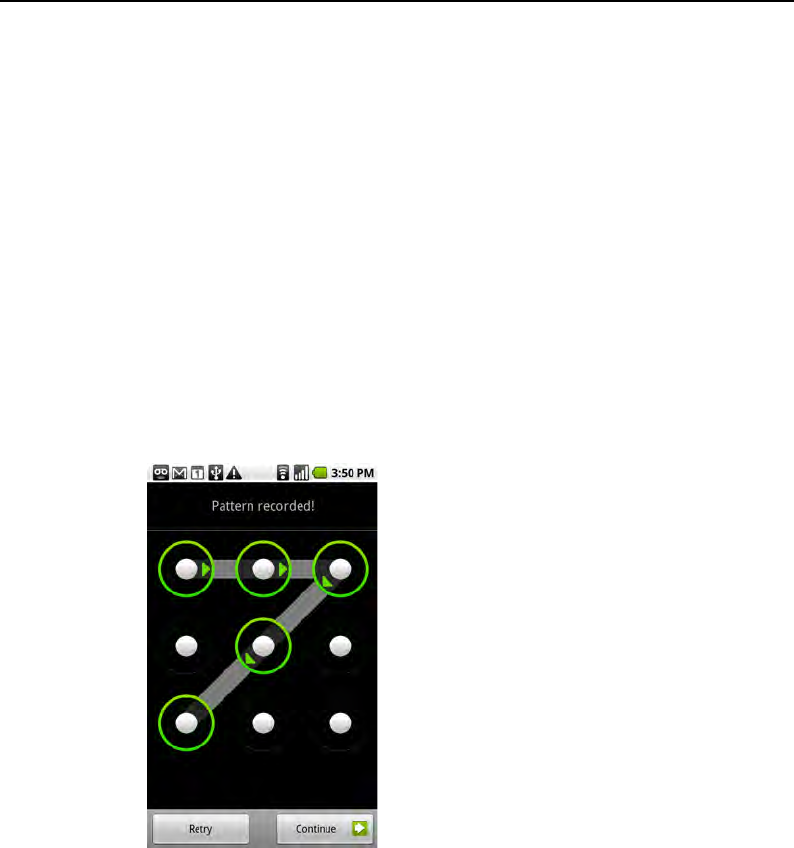
Android basics 51
AUG-2.0.0-100 Android User’s Guide
Locking your screen
You can lock your screen so that only you can unlock it, to make calls, access your
data, buy applications, and so on. (See “Location & security settings” on page 264
for other ways to protect your phone and privacy.)
To lock your screen
1On the Home screen press MENU and touch Location & security.
2Scroll to the Screen unlock pattern section and touch Set unlock
pattern.
The first time you do this, you’re presented with a short tutorial on creating an
unlock pattern. Subsequently you can press MENU and touch Help for a
refresher.
Then you’re prompted to drawn and redraw your own pattern.
Then next time you turn on your phone or wake up the screen, you’re
prompted to draw your unlock pattern to unlock the screen.
Draw your unlock pattern
Touch Continue to draw
your pattern again to
confirm it

Android basics 52
AUG-2.0.0-100 Android User’s Guide
Customizing the Home screen
You can add application icons, widgets, and other items to any pane of the Home
screen. You can also change the wallpaper.
To add an item to the Home screen
1Open the Home screen pane where you want to add the item.
See “Getting to know the Home screen” on page 29 for an introduction to
working with the Home screen.
2Press MENU and touch Add.
Or just touch & hold an empty location on the Home screen.
3In the menu that opens, touch the type of item you want to add.
You can a variety of items to the Home screen:
Shortcuts Add shortcuts to applications, a bookmarked webpage, a favorite
contact, a Gmail label, a music playlist, and other items.
Widgets Add a clock, music player, a picture frame, the Google search bar, a
power manager, or a calendar that shows upcoming appointments. You can also add
widgets you downloaded from Android Market.
Folders Add a folder where you can organize Home screen items, or folders that
contain all your contacts, contacts with phone numbers, or starred contacts. Your
folders’ contents are kept up to date automatically.
To move an item on the Home screen
1Touch & hold the item you want to move until it vibrates. Don’t lift your finger.
2Drag the item to a new location on the screen.
Pause at the left or right edge of the screen to drag the item onto another
Home screen pane.
3When the item is where you want it, lift your finger.

Android basics 53
AUG-2.0.0-100 Android User’s Guide
To remove an item from the Home screen
1Touch & hold the item you want to remove until it vibrates. Don’t lift your
finger.
The Applications tab icon changes to a trash can.
2Drag the item to the trash can icon on the Applications tab.
3When the icon and Application tab turn red, lift your finger.
To change the Home screen wallpaper
1Press MENU and touch Wallpaper.
You can also touch & hold an empty area of the home screen and in the menu
that opens, touch Wallpapers.
2Touch Pictures or Wallpaper gallery.
Touch Pictures to use a picture that you have captured using the camera or
copied to your phone as a wallpaper. You can crop the picture before setting it
as a wallpaper. Working with pictures is described in “Gallery” on page 215
Touch Wallpaper gallery to open a screen where you can sample the
wallpaper images that come with the phone. Slide the miniature images left and
right to view the samples. Touch a sample to view a larger version.
3Touch Save or Set wallpaper.
To rename a folder
1Touch the folder to open it.
2Touch and hold the folder window’s title bar.
3Enter a new name in the dialog.
4Touch OK.

Android basics 54
AUG-2.0.0-100 Android User’s Guide
Connecting quickly with your contacts
As you build up your list of contacts on your phone, you can use Quick Contact for
Android in many applications to quickly start a chat, send an email or text message,
or to locate your contacts.
SIdentify a Quick Contact icon by its picture frame.
Contacts you can access via Quick Contact are displayed differently in different
applications, but usually with a picture frame that looks like this:
STouch a Quick Contact icon to open a bubble with icons for all the ways you
can communicate with the contact.
Drag the icons left and right to view them all, if there are more than can fit in
the bubble.
STouch an icon to open its application where you can start communicating with
your contact right away.
You can also touch an icon to edit the contact’s information in Contacts, to view
the contact’s address in Google Maps, and so on, depending on which
applications and accounts are configured on your phone.
A Quick Contact icon.
Touch an icon to start
communicating with the
contact in that application.

Android basics 55
AUG-2.0.0-100 Android User’s Guide
Optimizing battery life
You can extend the your battery’s life between charges by turning off features you
don’t need. You can also monitor how applications and system resources consume
battery power.
To extend the life of your battery
STurn off radios you aren’t using.
If you aren’t using Wi-Fi, Bluetooth, or GPS, use the Settings application to turn
them off. (See “Wireless & networks” on page 257 and “Location & security
settings” on page 264).
STurn down screen brightness and set a shorter screen timeout.
See “Sound & display settings screen” on page 262.
SIf you don’t need them, turn off automatic syncing for Gmail, Calendar,
Contacts, and other applications.
See “Configuring account sync and display options” on page 110.
SUse the Power Control widget to check and control the status of radios, the
display brightness, and syncing.
Adding widgets is described in “Customizing the Home screen” on page 52.
To check the battery charge level
SOn the Home screen, press MENU and touch Settings > About phone >
Status.
The battery status (charging, discharging) and level (as a percentage of fully
charges) are displayed at the top of the screen.
To monitor and control what uses the battery
You can use the Battery use screen to view which applications consume the most
battery power and to identify applications you’ve downloaded that you may want to
avoid when trying to get the most from your battery.

Android basics 56
AUG-2.0.0-100 Android User’s Guide
SOn the Home screen, press MENU and touch Settings > About phone >
Status.
The battery use screen lists the what’s been using the battery, from greatest to
least battery use.
At the top the screen displays the time since you were last connected to a
power source or, if you’re currently connected to one, how long you were last
running on battery power.
Then each application or service that used battery power during that time is
displayed, in order of the amount of power they used.
STouch an application in the Battery use screen to learn details about its power
consumption.
Different applications offer different kinds of information, and may even include
buttons that open settings you can use to reduce power consumption by that
application.

57
AUG-2.0.0-100 Android User’s Guide
Connecting to networks and
devices
Your phone can connect to a variety of networks and devices,
including Mobile networks for voice and data transmission, Wi-Fi data
networks, and Bluetooth devices, such as headsets. You can also
connect your phone to a computer, to transfers files from your
phone’s SD card.
In this section
“Connecting to mobile networks” on page 58
“Connecting to Wi-Fi networks” on page 60
“Connecting to Bluetooth devices” on page 63
“Connecting to a computer via USB” on page 66
“Connecting to virtual private networks” on page 68

Connecting to networks and devices 58
AUG-2.0.0-100 Android User’s Guide
Connecting to mobile networks
When you assemble your phone with a SIM card from your wireless service
provider (as described in “Your phone and accessories” on page 19), your phone is
configured to use your provider’s mobile networks for voice calls and for
transmitting data.
Different locations may have different mobile networks available. Initially, your
phone is configured to use the fastest mobile network available for data. But you
can configure your phone to use only a slower 2G network for data, to extend the
life of your battery. You can also configure your phone to access a different set of
networks entirely, or to behave in special ways when roaming.
The status bar indicates which kind of data network you’re connected to and the
overall voice and data network signal strength:
When you’re connected to slower networks, you may wish to postpone using your
phone for data-intensive tasks until you are connected to a faster network again, or
find a Wi-Fi network to connect to (see “Connecting to Wi-Fi networks” on
page 60).
To check which provider’s network you’re using
1Press HOME, press MENU, and touch Settings, to open the Settings
application.
2Touch Wireless controls > Mobile networks > Access Point Names.
The name of the wireless service provider you’re currently registered with is
selected in the list.
To disable data when roaming
You can prevent your phone from transmitting data over other carriers’ mobile
networks, when you leave an area covered by your carrier’s networks. This is useful
if you chose a cell plan that doesn’t include data roaming, to control expenses.
Connected to the fastest 3G networks (UMTS or HSDPA)
Connected to the second-fastest network (EDGE)
Connected to a 2G network (GPRS)
The more bars are lit, the stronger the wireless signal
Connected to another wireless service provider’s network (roaming)

Connecting to networks and devices 59
AUG-2.0.0-100 Android User’s Guide
1Press HOME, press MENU, and touch Settings, to open the Settings
application.
2Touch Wireless controls > Mobile networks and uncheck Data
roaming.
With Data roaming unchecked, you can still transmit data with a Wi-Fi
connection (see “Connecting to Wi-Fi networks” on page 60).
To limit your data connection to 2G networks
You can extend your battery life by limiting your data connections to 2G networks
(GPRS or EDGE). When you are connected to a 2G network, you may want to
postpone activities that transmit a lot of data (such as sending, uploading, or
downloading pictures or video) until you are connected to a faster mobile or other
wireless network.
1Press HOME, press MENU, and touch Settings, to open the Settings
application.
2Touch Wireless controls > Mobile networks and check Use only 2G
networks.
To edit or create a new access point
If you and your wireless service provider determine you need to change the settings
of your current access point name (APN) or to create a new one, you must obtain
the access point name (APN) and detailed settings from your provider.
1Press HOME, press MENU, and touch Settings, to open the Settings
application.
2Touch Wireless controls > Mobile networks and touch Access Point
Names.
3Touch an existing APN to edit it. Or press MENU and touch New APN.
Enter the APN settings you obtained from your wireless service provider, by
touching each setting you need to edit.
4When you’re done, press MENU and touch Save.
5If you created a new APN, touch it in the APNs screen to start using it.
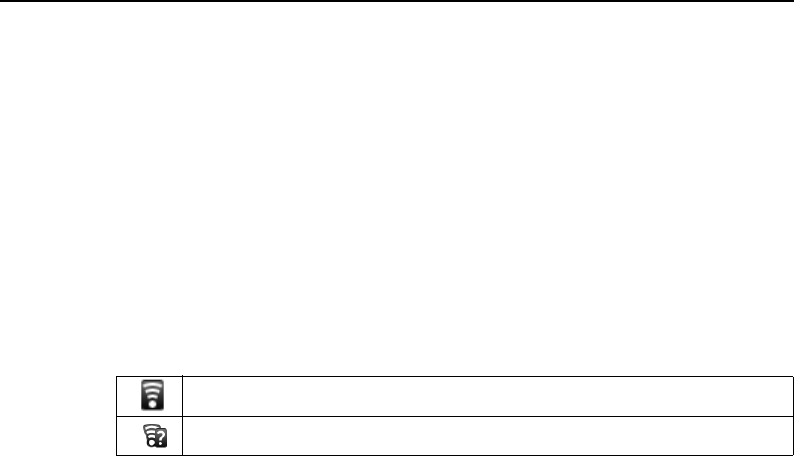
Connecting to networks and devices 60
AUG-2.0.0-100 Android User’s Guide
Connecting to Wi-Fi networks
Wi-Fi is a wireless networking technology that can provide Internet access at
distances of up to 100 meters, depending on the Wi-Fi router and your
surroundings.
To use Wi-Fi on your phone, you access to a wireless access point or “hotspot.”
Some access points are open and you can simply connect to them. Others are
hidden or implement any of a number of other security features, so you must
configure your phone so it can connect to them.
Turn off Wi-Fi when you’re not using it, to extend the life of your battery.
The status bar displays icons that indicate Wi-Fi status.
When you connect to a Wi-Fi network, the phone obtains a network address and
other information it needs from the network, using the DHCP protocol. You can
configure the phone with a fixed IP address and make other advanced settings by
pressing Menu and touching Advanced (see “Advanced Wi-Fi settings screen” on
page 258).
Connected to a Wi-Fi network (waves indicate connection strength)
Notification that an open Wi-Fi network is in range

Connecting to networks and devices 61
AUG-2.0.0-100 Android User’s Guide
To turn Wi-Fi on and connect to a Wi-Fi network
1Press HOME, press MENU, and touch Settings, to open the Settings
application.
2Touch Wireless controls > Wi-Fi settings.
3Check Wi-Fi to turn it on.
The phone scans for available Wi-Fi networks and displays the names of those it
finds in the Wi-Fi networks list.
If the phone discovers a network you connected to in the past, it connects to it.
Secured networks are indicated with a lock icon.
4Touch a network to connect to it.
If the network is open, a dialog prompts you to confirm that you want to
connect to that network by touching Connect.
If the network is secured, you’re prompted to enter a password or other
credentials (ask your network administrator for details).
When you’re connected to a network, you can touch its name in the Wi-Fi
settings screen to open a dialog with details about the speed, security, assigned
address, and related settings.
To receive notifications when open networks are in range
By default, when Wi-Fi is on, you receive notifications in the status bar when your
phone detects an open Wi-Fi network.
1Turn on Wi-Fi, if it’s not already on.
2In the Wi-Fi settings screen, check Network notification.
You can also uncheck this option to stop receiving notifications.
To add a Wi-Fi network
You can add a Wi-Fi network so the phone will remember it, along with any security
credentials, and connect to it automatically when it is in range. You must also add a
Wi-Fi network to connect to it, if it does not broadcast its name (SSID), or to add a
Wi-Fi network when you are out of range.
To join a secured network, you will need to contact the network’s administrator to
learn what security scheme is deployed on it and to obtain the password or other
required security credentials.

Connecting to networks and devices 62
AUG-2.0.0-100 Android User’s Guide
1Turn on Wi-Fi, if it’s not already on.
2In the Wi-Fi settings screen, touch Add Wi-Fi network (at the bottom of the
list of discovered networks).
3Enter the SSID (name) of the network and if the network is secured, touch the
Security menu and then touch the type of security deployed on the network.
4Enter any required security credentials.
5Touch Save.
The phone connects to the wireless network, and any credentials you entered
are saved, so you are connected automatically the next time you come within
range of this network.
To forget a Wi-Fi network
You can make the phone forget about the details of a Wi-Fi network you added, for
example, if you don’t want the phone to connect to it automatically or if it is no
longer a network you use.
1Turn on Wi-Fi, if it’s not already on.
2In the Wi-Fi settings screen, touch & hold the name of the remembered
network.
3Touch Forget network in the dialog that opens.
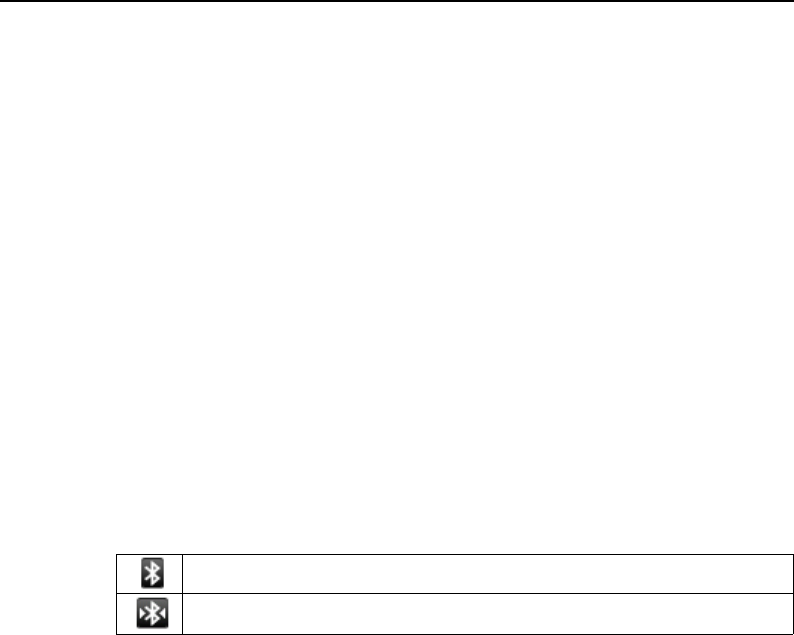
Connecting to networks and devices 63
AUG-2.0.0-100 Android User’s Guide
Connecting to Bluetooth devices
Bluetooth is a short-range wireless communications technology that devices can
use to exchange information over a distance of about eight meters. The most
common Bluetooth devices are headphones, for making calls or listening to music,
hands-free kits for cars, and other portable devices, including laptops and cell
phones.
There are several Bluetooth profiles that define the features and communications
standards for Bluetooth devices. For a list of the profiles supported by your phone,
see “Specifications” on page 279.
To connect to a Bluetooth device, you must turn on your phone’s Bluetooth radio.
Then the first time you use a new device with your phone, you must “pair” them, so
they know how to connect securely to each other. Subsequently, you can simply
connect to a paired device.
Turn off Bluetooth when you’re not using it, to extend the life of your battery. You
may also be required to turn Bluetooth off in some locations, such as hospitals or
airplanes. Bluetooth is turned off in Airplane mode.
The status bar displays icons that indicate Bluetooth status:
To turn Bluetooth on or off
1Press HOME, press MENU, and touch Settings, to open the Settings
application.
2Touch Wireless controls.
3Check or uncheck Bluetooth to turn it on or off.
To change your phone’s Bluetooth name
Your phone has a generic Bluetooth name by default, which is visible to other
devices when you connect them. You can change the name so it more recognizable
or unique.
Bluetooth is on
Connected to a Bluetooth device

Connecting to networks and devices 64
AUG-2.0.0-100 Android User’s Guide
1Press HOME, press MENU, and touch Settings, to open the Settings
application.
2Touch Wireless controls > Bluetooth settings.
The Bluetooth settings screen opens.
3If Bluetooth isn’t turned on, check Bluetooth to turn it on.
4Touch Bluetooth name, enter a name, and touch OK.
To pair your phone with a Bluetooth device
You must pair your phone with another device before you can connect to it. You
only need to do this the first time you connect to a device.
1Press HOME, press MENU, and touch Settings, to open the Settings
application.
2Touch Wireless controls > Bluetooth settings.
3If Bluetooth isn’t turned on, check Bluetooth to turn it on.
Your phone scans for and then displays the IDs of all available Bluetooth devices
in range.
4If the device you want to pair with isn’t in the list, make it discoverable.
See the device’s documentation to learn how to make it discoverable by your
phone, and for any other instructions for pairing.
5If your phone stops scanning before you make the other device discoverable,
touch Scan for devices.
6Touch the ID of the other device, in the list in Settings, to pair them.
The devices pair with each other. If you’re prompted to enter a passcode, try
entering 0000 or 1234 (the most common passcodes), or consult your device’s
documentation to learn its passcode.
If the pairing is successful, your phone connects to the device.
To connect to a Bluetooth device
Once paired, you can connect to a Bluetooth device, for example, to switch devices
or to reconnect after the phone and the device come back into range.

Connecting to networks and devices 65
AUG-2.0.0-100 Android User’s Guide
1Press HOME, press MENU, and touch Settings, to open the Settings
application.
2Touch Wireless controls > Bluetooth settings.
3If Bluetooth isn’t turned on, check Bluetooth to turn it on.
4In the list of devices, touch a paired but unconnected device in the list.
If the device you expected isn’t displayed, touch Scan for devices.
When the phone and the device are connected, the device is displayed as
connected in the list.
To configure which features of a Bluetooth device you want to use
Some Bluetooth devices have multiple profiles. Profiles can includes the ability to
transmit your phone conversations, to play music in stereo, or to transfer files or
other data. You can select which profiles you want to use with your phone.
1Touch & hold the device in the Bluetooth settings screen.
2Touch Options in the menu that opens.
A screen opens with a list of the device’s profiles.
3Check or uncheck a profile to use it or not.
4When you’re done, press BACK.
To disconnect from a Bluetooth device
1Touch the device in the Bluetooth settings screen.
2Touch OK in the dialog that asks you to confirm you want to disconnect.
To unpair a Bluetooth device
You can unpair a Bluetooth device, to erase all pairing information about it.
1Touch & hold the device in the Bluetooth settings screen.
2Touch Unpair or Disconnect & unpair in the menu that opens.

Connecting to networks and devices 66
AUG-2.0.0-100 Android User’s Guide
Connecting to a computer via USB
You can connect your phone to a computer with a USB cable, to transfer music,
pictures, and other files between your phone’s SD card and the computer.
Warning! When connecting your phone to a computer and mounting its SD card, you must
follow your computer’s instructions for connecting and disconnecting USB devices,
to avoid damaging or corrupting the files on your SD card.
To connect your phone to a computer via USB
1Use the USB cable that came with your phone to connect the phone to a USB
port on your computer.
You receive a notification that the USB is connected.
2Open the Notifications panel and touch USB connected.
For details on working with the Notifications panel, see “Managing notifications”
on page 46.
3Touch Mount in the dialog that opens asking if you want to transfer files.
You receive a new notification when the phone is connected as USB storage.
You phone’s SD card is mounted as a drive on your computer. You can now copy
files to and from the SD card. For more information, see the documentation for
your computer.
During this time, you can’t access the SD card from your phone, so you can’t use
applications that rely on the SD card (such as Camera, Gallery, or Music).
To disconnect your phone from the computer
1Unmount the SD card on your computer.
You must carefully follow your computer’s instructions to unmount the SD card
and disconnect USB devices correctly, to avoid losing information on the card.
2Open the Notifications panel and touch Turn off USB storage.
3In the dialog that asks you to confirm that you first unmounted the SD card on
the computer, touch Turn off.
To safely remove the SD card from your phone
You can safely remove the SD card from your phone any time the phone is turned
off, as described in “Your phone and accessories” on page 19. But if you need to

Connecting to networks and devices 67
AUG-2.0.0-100 Android User’s Guide
remove the storage card while the phone is on, you must unmount the storage card
form the phone first, to prevent corrupting or damaging the storage card.
1Press HOME, press MENU, and touch Settings, to open the Settings
application.
2Touch SD card & phone storage.
3Touch Unmount SD card.
You can now safely remove the SD card from the phone.
To format an SD card
If you purchase a new SD card, you may need to format it before you can use it with
your phone. You can also format an SD card to erase its contents.
1Press HOME, press MENU, and touch Settings, to open the Settings
application.
2Touch SD card & phone storage.
3If necessary, touch Unmount SD card.
You can only format an SD card when it is unmounted.
4Touch Format SD card and on the screen that warns you that formatting the
SD card will erase its contents, touch Format SD card.

Connecting to networks and devices 68
AUG-2.0.0-100 Android User’s Guide
Connecting to virtual private networks
Virtual private networks (VPNs) are a technology for connecting to the resources
inside a secured local network, from outside that network. VPNs are commonly
deployed by corporations, schools, and other institutions so their users can access
local network resources when not on campus, or when connected to a wireless
network.
There are numerous systems for securing VPN connections, including some that
rely on secure certificates or other schemes to ensure that only authorized users
can connect. You must obtain the details from your network administrator to
configure VPN access from your phone.
Working with secure certificates
If your organization’s VPN access relies on secure certificates, you must obtain the
certificates and store them in your phone’s secure credential storage, before you
can configure VPN access on your phone.
If your network administrator instructs you download the certificates from a web
site, you’ll be prompted to set a password for the credential storage when you
download the certificates. If your network administrator has you obtain the
certificates in some other way, you will need to use the Security & location settings
to set a password for the credential storage first (see “Location & security settings”
on page 264).
To add a VPN
1Press HOME, press MENU, and touch Settings, to open the Settings
application.
2Touch Wireless controls > VPN settings.
3Touch Add VPN.
4Touch the type of VPN you want to add.
5In the screen that opens, follow the instructions from your network
administrator to configure each component of the VPN’s settings.
6Press MENU and touch Save.
The VPN is added to the list on the VPN settings screen.

Connecting to networks and devices 69
AUG-2.0.0-100 Android User’s Guide
To connect to a VPN
1Open the Settings application.
2Touch Wireless controls > VPN settings.
The VPNs you’ve added are listed on the VPN settings screen.
3Touch the VPN you want to connect to.
4In the dialog that opens, enter any requested credentials and touch Connect.
When you’re connected to a VPN, you receive an ongoing notification in the
status bar. If you are disconnected, you receive a notification that you can use to
return to the VNP settings screen so you can reconnect to it (see “Managing
notifications” on page 46).
To disconnect from a VPN
SOpen the Notifications panel and touch the ongoing notification for the VPN
connection.
Touch the ongoing VPN notification to disconnect.

Connecting to networks and devices 70
AUG-2.0.0-100 Android User’s Guide

71
AUG-2.0.0-100 Android User’s Guide
Placing and receiving calls
You can place phone calls by dialing a phone number, from your
contacts, from web pages, and in other ways. When on a call, you can
manage incoming calls, answering them or sending them to your
voicemail box. You can even set up conference calls with several
participants <<not CDMA>>.
In this section
“Placing and ending calls” on page 72
“Answering or rejecting calls” on page 75
“Working with the Call log” on page 76
“Calling your contacts” on page 78
“Listening to your voicemail” on page 79
“Dialing by voice” on page 80
“Options during a call” on page 81
“Managing multiple calls” on page 84
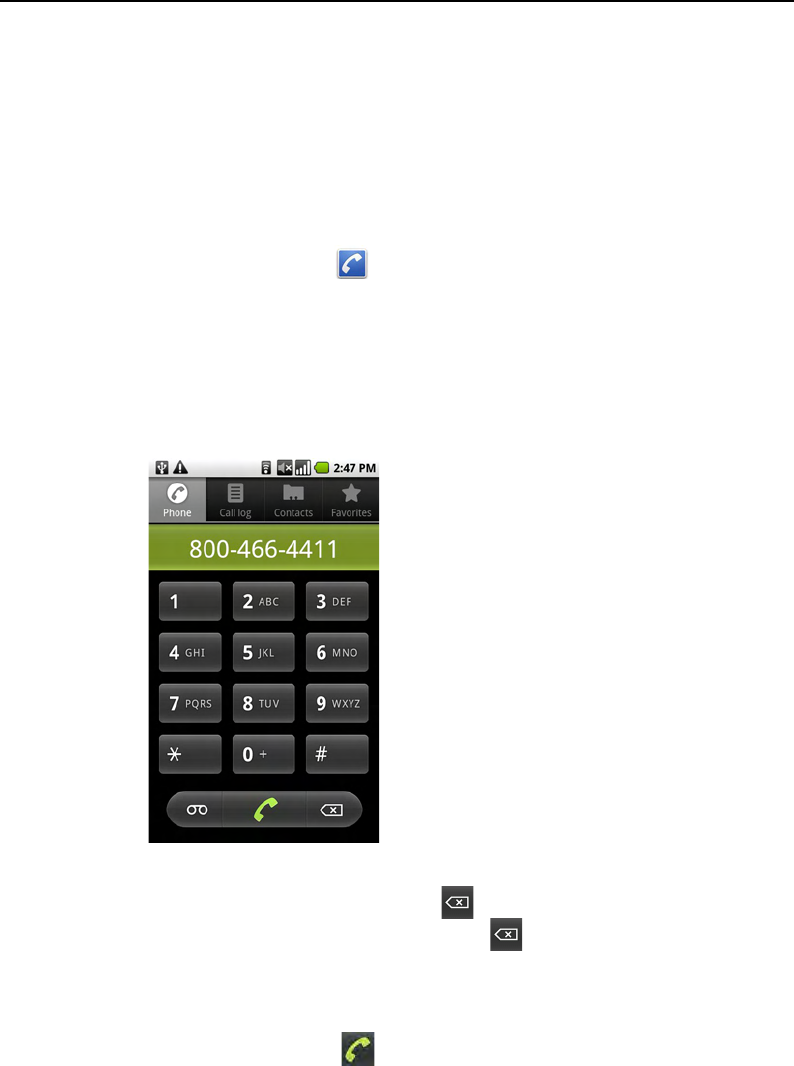
Placing and receiving calls 72
AUG-2.0.0-100 Android User’s Guide
Placing and ending calls
You can place calls with the Phone application. You can also place calls when
working in the Call log (see “Working with the Call log” on page 76) or in Contacts
(see “Communicating with your contacts” on page 98).
To open Phone
STouch the Phone icon on the Home screen or in the Applications tab.
OR
SIf you’re already working with Contacts or the Call log, touch the Phone tab.
To place a call by dialing
1Open Phone.
2Touch the keys on the Phone tab to enter the phone number.
If you enter a wrong number, touch to erase digits one by one.
To erase the entire number, touch & hold .
To dial an international number, touch & hold the 0 key to enter the plus ( +)
symbol. Then enter the appropriate international prefix, followed by the full
phone number.
3Press green phone icon to dial the number you entered. Or just touch the
number on screen.
Touch the entered number to dial
it.
Touch & hold to enter +.
Touch to erase a digit. Touch &
hold to erase the entire number.
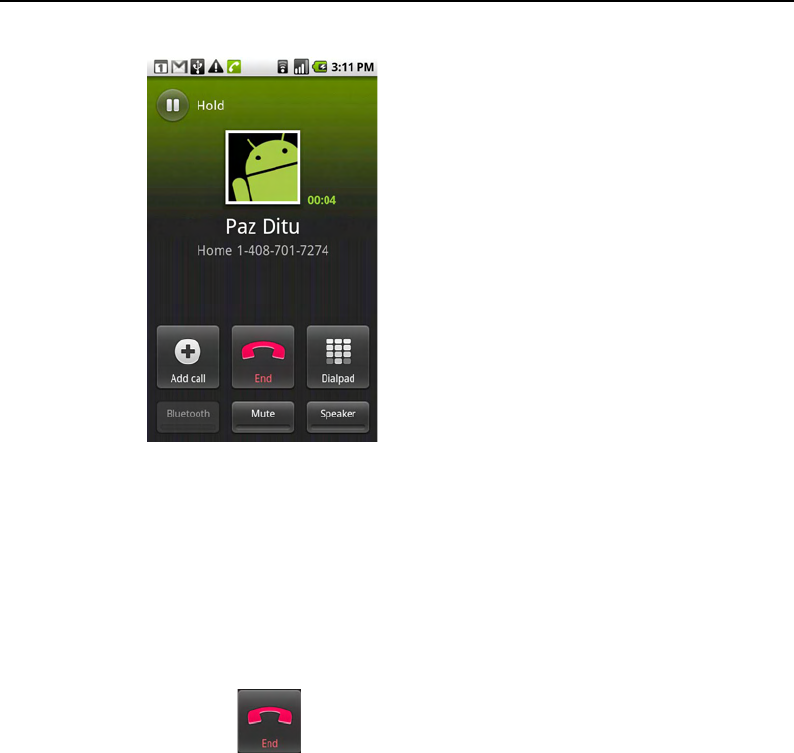
Placing and receiving calls 73
AUG-2.0.0-100 Android User’s Guide
During a call, you can switch applications, for example, to look up information
using the Browser. The green phone icon appears in the Status bar while the call
is underway, as a reminder.
Press the VOLUME UP / DOWN buttons to adjust the in-call volume.
Use can use the onscreen buttons to place the current call on hold<<not
CDMA>>, to add a caller, and for other in-call options, as described in “Options
during a call” on page 81.
To end a call
STouch End .
To quickly redial the last number you called
<<Delete for phones without physical buttons>>
SPress the CALL button twice.
Or if you have the Phone tab open, touch the Call log tab and then press the
CALL button to redial.
To disable phone calls (airplane mode)
In some locations, such as on airplanes, you must turn off your phone’s wireless
connections, by placing your phone in airplane mode.
Information from Contacts
about the person you’re
calling.
The duration of the call.
Drag the Dialpad tab up to
enter additional numbers
during your call.
<<Delete Hold for
CDMA.>>
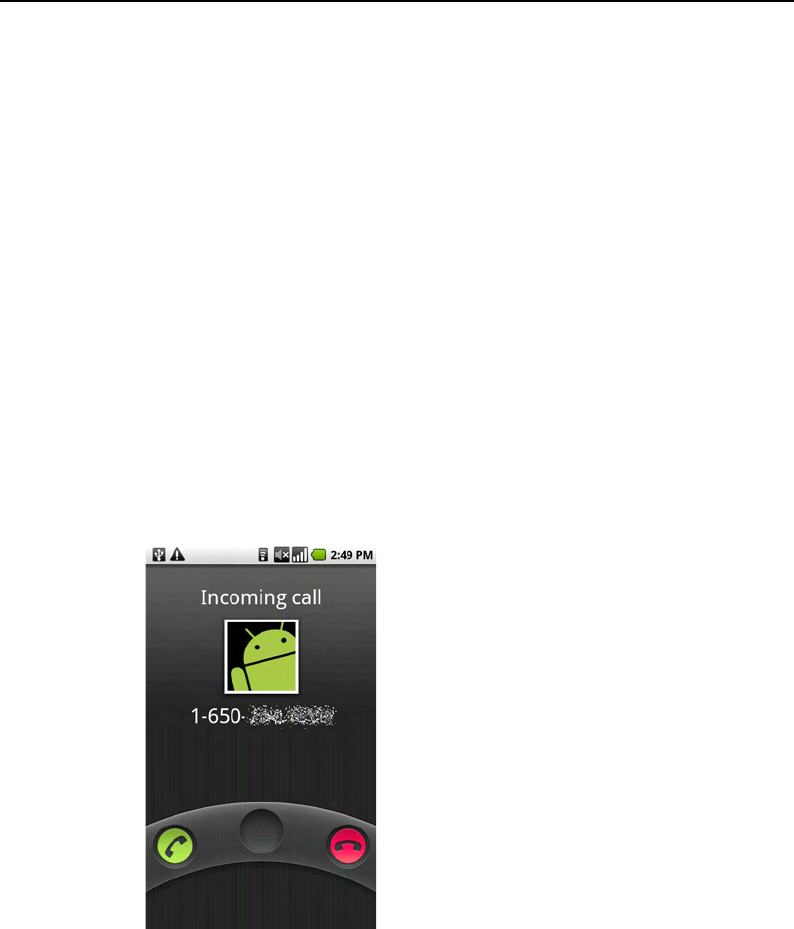
Placing and receiving calls 75
AUG-2.0.0-100 Android User’s Guide
Answering or rejecting calls
When you receive a phone call, the incoming call screen opens with the caller ID
and additional information about the caller, depending on how much information
about the caller you have entered in Contacts (see “Contacts” on page 87).
All incoming calls are recorded in the Call log (see “Working with the Call log” on
page 76). If you miss a call, you receive a notification (see “Managing notifications”
on page 46).
Selecting a ringtone and its volume are described in “Sound & display settings” on
page 262.
To answer a call
SDrag the green phone icon to the right.
If you were already on a call, the first call is placed on hold while you answer the
new call.
To silence the ringer before answering the call, press the VOLUME DOWN
button.
To reject a call
SDrag the red phone button to the left.
Information from Contacts is
displayed about the caller.
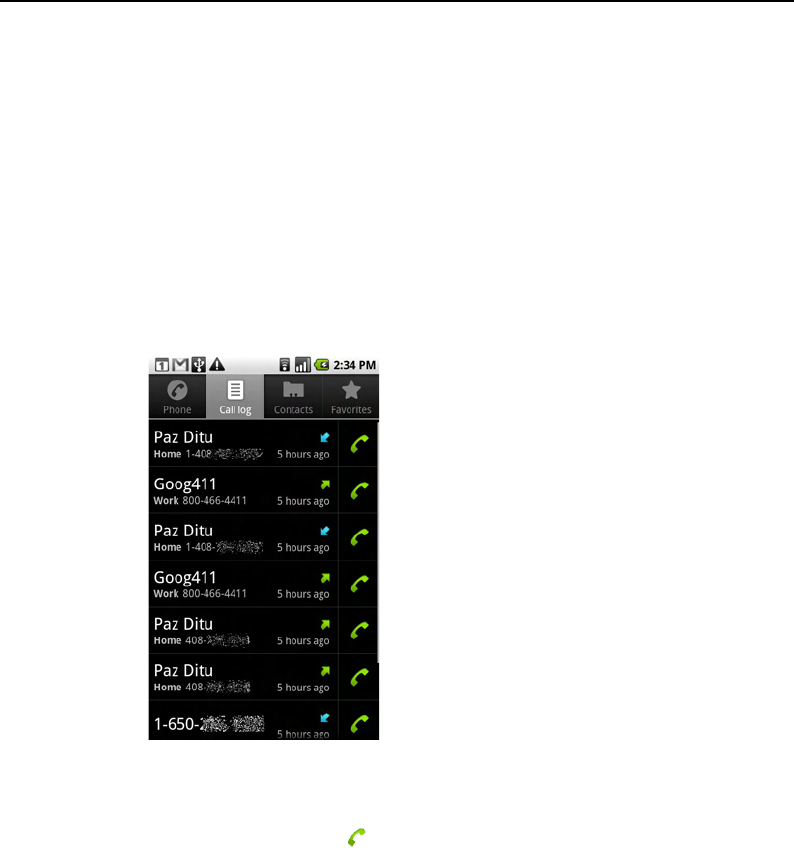
Placing and receiving calls 76
AUG-2.0.0-100 Android User’s Guide
Working with the Call log
The Call log is a list of all the calls you’ve placed, received, or missed. It offers a
convenient way to redial a number, return a call, add to a number to your Contacts.
To open the Call log
SPress the CALL button.
Or if you have the Phone or Contacts tab open, touch the Call log tab.
Calls are listed with the most recent at the top. You can scroll to view earlier
entries in the log.
To quickly dial a number in the Call log
STouch the green phone icon at the right of the entry.
You can also touch & hold the entry to open a menu with options for
communicating with the entry in other ways.
<<reshoot with missed call
showing, final art, etc.>>
Missed call
Incoming call
Outgoing call
Touch to call back
Touch & hold an entry for
more options

Placing and receiving calls 77
AUG-2.0.0-100 Android User’s Guide
To add an entry’s number to your Contacts
1Touch & hold the entry.
2Touch Add to contacts in the menu that opens.
3In the list of contacts that opens, touch Create new contact at the top, or
scroll to find and then touch an existing contact you want to add the number to.
For more information on creating and editing contacts, see “Contacts” on
page 87.
To take other actions on a Call log entry
STouch a Call log entry to open a screen where you can call the contact again,
send the contact a message, add the number to your Contacts, and learn more
about the original call.
STouch & hold a Call log entry to open a menu where you call the contact, view
the contact information (if the number is stored in your contacts list), edit the
number before you redial, and more.
To clear the Call log
SWhen viewing the Call log, press MENU and touch Clear call log.
You can also touch & hold an entry in the log and in the menu that opens, touch
Remove from call log to remove just that entry from the log.

Placing and receiving calls 78
AUG-2.0.0-100 Android User’s Guide
Calling your contacts
You can touch one of your contacts’ phone numbers to dial it, instead of entering
the number in the Phone tab.
(You can also quickly call a contact with Quick Contact. See “Connecting quickly
with your contacts” on page 54)
Adding, editing, and performing other tasks with your contacts is described in
“Contacts” on page 87. If you have contacts on the web, they’re synchronized with
your phone when you first connect to your Google Account.
To call a contact
1Open your contacts.
For example, on the Home screen touch the Contacts icon . Or in Phone,
touch the Contacts tab.
2Touch the contact you want to call.
You can search for or scroll to find a contact.
3Touch the phone number you want to use to call the contact.
See “Communicating with your contacts” on page 98 for other options.
To call a favorite contact
1Open your list of favorites.
For example, on the Home screen touch the Contacts icon and then touch the
Favorites tab.
The list of your favorite contacts is followed by a list of the numbers you call
most often.
You add and remove favorites by touching the star next to their names, when
you’re viewing information about the Contact. For details, see “Adding a contact
to your favorites” on page 93.
2Touch the favorite you want to call.
3Touch the phone number you want to use to call the contact.

Placing and receiving calls 79
AUG-2.0.0-100 Android User’s Guide
Listening to your voicemail
A voicemail icon appears in the status bar when you have new voicemail
messages.
If you have not set up your voicemail number, or if you need to change it, you can
do that with the Call settings (see “Call settings” on page 260).
To listen to your voicemail
SOpen the Notifications panel and touch New voicemail.
Responding to notifications is described in “Managing notifications” on page 46.
OR
SOpen Phone and touch & hold the voicemail icon in the Phone tab.
Opening Phone is described in “Placing and ending calls” on page 72
<<confirm per deployment>>Your carrier’s voicemail system guides you
through the process of listening to and managing your voicemail. The first time
you call your voicemail, it also guides you through the process of recording
greetings, setting a password, and so on.

Placing and receiving calls 80
AUG-2.0.0-100 Android User’s Guide
Dialing by voice
You can search for and dial a contact by speaking, rather than by using the Phone
tab or touching a contact’s number.
To place a call by speaking
You can call a contact using Google search by voice.
1Press and hold the SEARCH button.
You’re prompted to speak.
2Say “Call” followed by the name of the contact you want to call.
If Google search by voice finds a match, it dials the contact’s default number.
For details about setting a contact’s default number, see “Editing contact details”
on page 95.
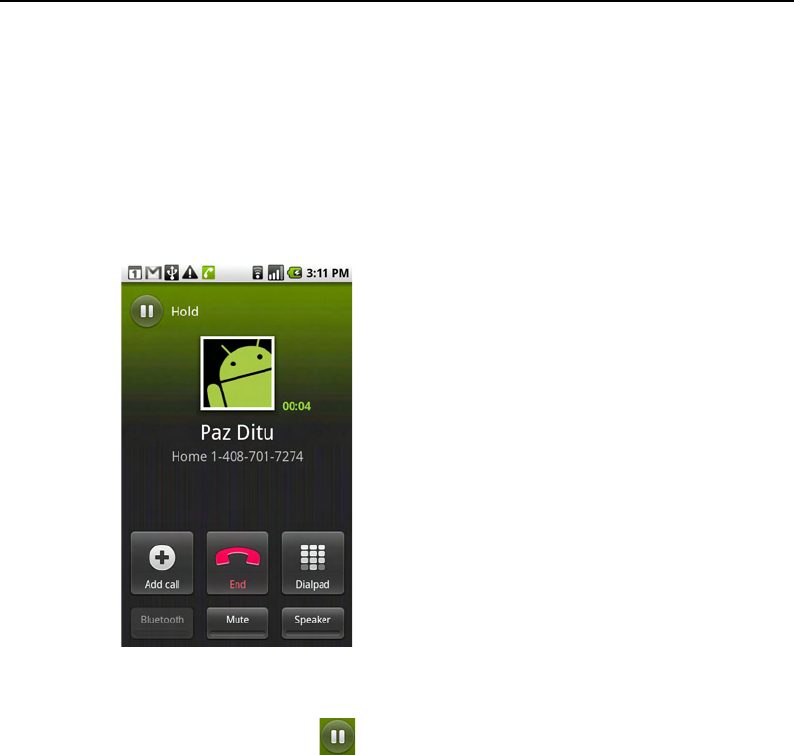
Placing and receiving calls 81
AUG-2.0.0-100 Android User’s Guide
Options during a call
<<Hold and merge not for CDMA>>
When a call is in progress, you put a call on hold, dial another contact for a phone
conference, mute your microphone, and more.
During a call, you can also switch between callers and set up conference calls, as
described in “Managing multiple calls” on page 84.
To place a call on hold
STouch the Hold icon .
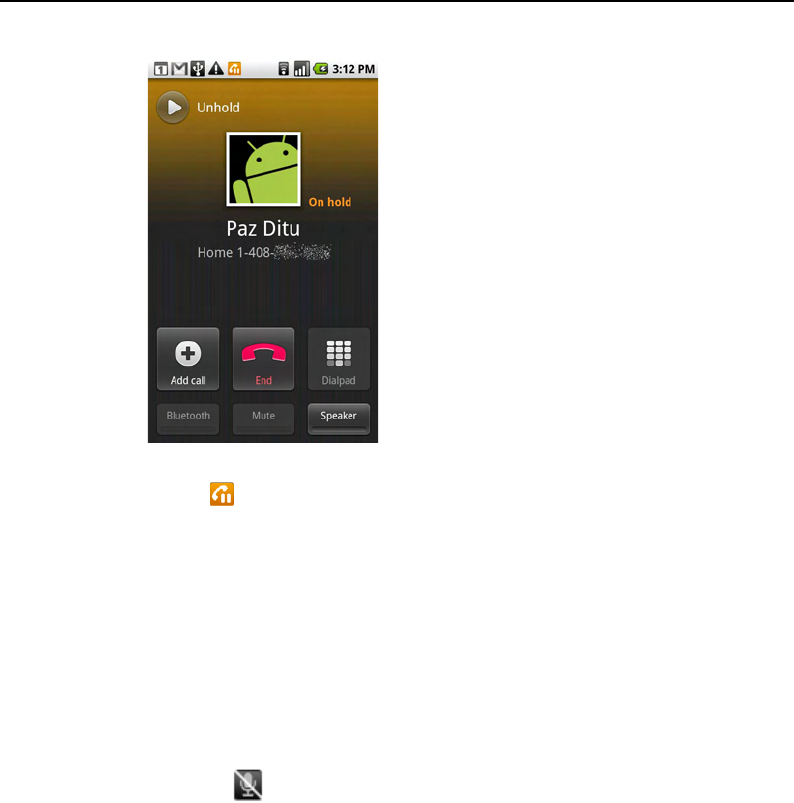
Placing and receiving calls 82
AUG-2.0.0-100 Android User’s Guide
The phone screen indicates that you have a call on hold.
A hold icon appears in the status bar, to remind you that you have a call on
hold. From any other application, you can open the Notifications panel and
touch the entry for the call on hold, to return to the current call screen (for
details about notifications, see “Managing notifications” on page 46).
When viewing the current call screen, you can take the call off hold by touching
the Unhold button.
To mute the microphone during a call
STouch Mute.
The Mute icon lights green to indicate the microphone is muted.
The mute icon appears in the status bar, to remind you that the
microphone is turned off.
When viewing the current call screen, you can unmute the microphone by
touching the Mute icon again.
The microphone is unmuted automatically when your current call ends.

Placing and receiving calls 83
AUG-2.0.0-100 Android User’s Guide
To turn the speakerphone on or off
STouch Speaker.
The Speaker icon lights green to indicate the speakerphone is on.
The speakerphone icon appears in the status bar and the sound from your
call is played out your phone’s speaker.
When viewing the current call screen, you can turn the speakerphone off by
touching the Speaker icon again.
The speaker it turned off automatically when your current call ends.
Warning! To avoid damage to your hearing, do not hold the phone against your ear when the
speakerphone is turned on.
To switch between a Bluetooth headset and the phone
When a Bluetooth headset is paired and connected to your phone, you can conduct
all calls on the headset for hands-free conversation.
For details about configuring the phone to use a Bluetooth headset, see
“Connecting to Bluetooth devices” on page 63.
When using the Bluetooth headset during a call, the current call screen gets a blue
border and the ongoing call icon turns blue in the status bar.
STouch the Bluetooth icon to switch from the headset to the phone, or vice
versa.
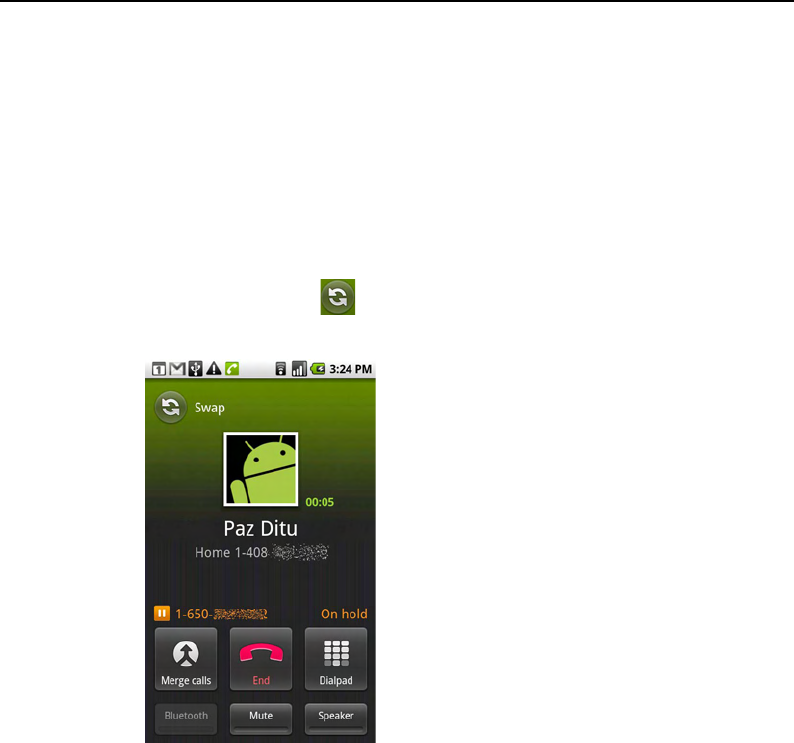
Placing and receiving calls 84
AUG-2.0.0-100 Android User’s Guide
Managing multiple calls
<<Much simpler for CDMA.>>
If you accept a new call when you’re already on a call, you can switch between the
two callers or merge the two calls into a single conference call. You can also set up
a conference call with multiple callers.
To switch between current calls
STouch the Swap icon .
The current call is put on hold and you join the other.
To set up a conference call
Contact your wireless service provider to learn whether they support conference
calls and how many participants you can include.
Touch to swap calls.
The number of the call
that’s on hold.
Touch to merge the calls
into a conference call.
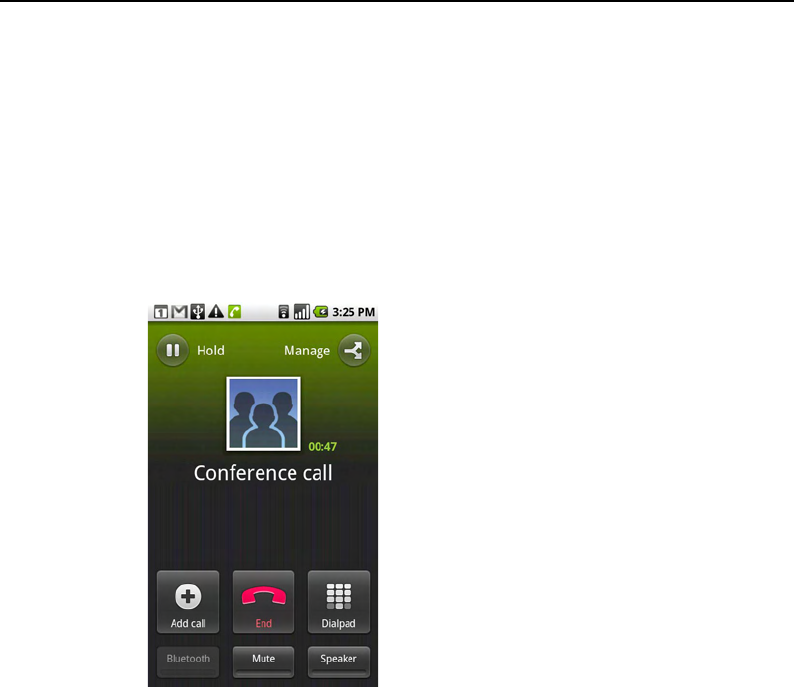
Placing and receiving calls 85
AUG-2.0.0-100 Android User’s Guide
1Place a first call to the first participant.
See “Placing and ending calls” on page 72 for details.
2When you’re connected, touch Add call.
The first participant is put on hold and you’re prompted to dial the second
caller.
3Place the next call, using the Phone tab, the Call log, or your contacts.
4When you’re connected, touch Merge calls.
The participant is added to the conference call.
You can add as many callers as your carrier supports.
During a conference call, touch Manage to drop a conference call participant
or to talk privately to one of the participants.
To end a conference call and disconnect all callers
STouch End.

Placing and receiving calls 86
AUG-2.0.0-100 Android User’s Guide

87
AUG-2.0.0-100 Android User’s Guide
Contacts
Contacts gives you quick and easy access to the people you want to
reach. When you first turn on your phone and sign into your Google
Account, any existing Google contacts are downloaded to your
phone. Subsequently, changes to either set of contacts are
synchronized. Information about your contacts is shared with other
applications, such a Gmail, Google Talk, Messaging, Gallery (for
sharing photos and videos), and so on.
If you have more than one account with contact information,
Contacts attempts to merge duplicates contacts into a single entry,
but you can also manage that process manually.
In this section
“Opening your contacts” on page 88
“Adding contacts” on page 90
“Importing, exporting, and sharing contacts” on page 91
“Adding a contact to your favorites” on page 93
“Searching for a contact” on page 94
“Editing contact details” on page 95
“Communicating with your contacts” on page 98
“Changing which contacts are displayed” on page 100
“Joining contacts” on page 102
“Separating contact information” on page 103
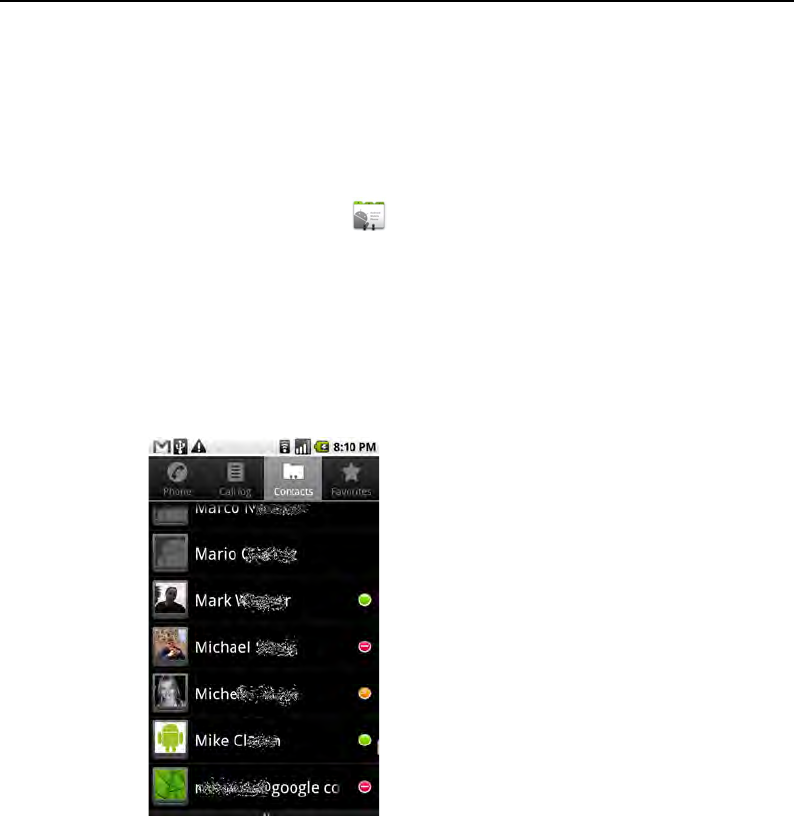
Contacts 88
AUG-2.0.0-100 Android User’s Guide
Opening your contacts
Open Contacts to add, view, and communicate with your friends and acquaintances.
To open your contacts
STouch the Contacts icon on the Home screen or in the Applications tab.
You can also open Contacts using Quick Contact (see “Connecting quickly with
your contacts” on page 54).
All your contact are displayed alphabetically in a scrolling list. Each contact is
followed by the default phone number.
If you have a new phone and haven’t added any contacts yet (by signing into a
Google or other account that has contacts you can sync), Contacts displays a
message with hints on how to start adding contacts to your phone.
You can drag the list up and down to scroll it, or slide your finger up or down to
scroll quickly. Either way, a tab briefly appears to the right of the list, which you
can drag up and down to scroll very quickly, while displaying the letter of the
alphabet for the contacts you’re scrolling past.
Touch to view only your favorite
contacts
Touch a contact to view its
details.
Touch an icon to open Quick
Contact
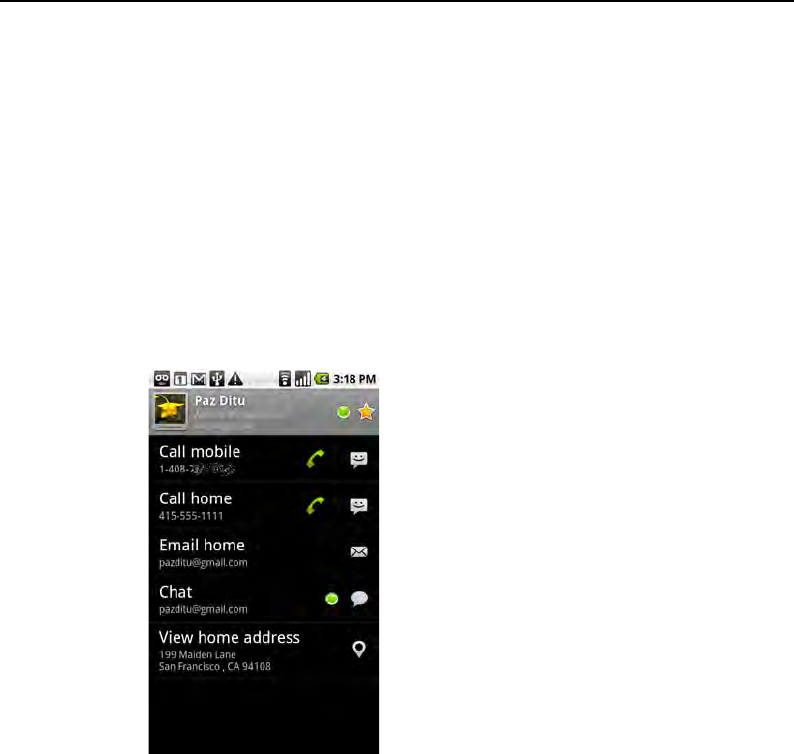
Contacts 89
AUG-2.0.0-100 Android User’s Guide
To open a list of your favorite contacts
SOpen your contacts and touch the Favorites tab.
The Favorites tab lists the contacts you’ve added to the list (see “Adding a
contact to your favorites” on page 93), followed by a list of your most frequently
called contacts.
To view details about a contact
1Open your contacts.
2Touch the contact whose details you want to view.
Entries for communicating with the contact are followed by the other details.
You can touch a communication method to start dialing, texting, or emailing the
contact using the listed number, address, and so on.
Touch an address to view it on Google Maps (see “Maps” on page 193).
You can also press MENU and touch Edit contact to edit the contact’s
information (see “Editing contact details” on page 95), or touch Delete
contact to delete all information about the contact from your Contacts.
Touch to open Quick Contact.
The contact’s status and where it’s
from
Touch to add or remove this
contact from your favorites.
Touch a contact method to start
communicating with the contact.
Touch an icon to call, email, text,
chat, map, and so on.
Touch an address to view it on
Google Maps.

Contacts 90
AUG-2.0.0-100 Android User’s Guide
Adding contacts
You can add contacts on your phone and synchronize them with the contacts in
your Google Account, an Exchange account, or other accounts that support syncing
contacts.
When you reply to or forward an email message to an email address that is not in
Contacts, the email address is added as a contact. Contacts tries to join new
addresses with existing contacts, to create a single entry, but you can also manage
that process manually (see “Joining contacts” on page 102 and “Separating contact
information” on page 103).
To add a new contact
1Open your contacts.
2Press MENU and touch New contact.
3Touch the account you want to add the contact to.
This step is skipped if you have only one account with contacts.
4Enter the contact’s name.
5Touch a category of contact information (such as phone numbers and email
addresses) to enter that kind of information about your contact.
Scroll the page to view all categories.
6Touch a category’s plus button to add more than one entry for that
category (such as more than one phone number).
You can touch the button to the left of the item of contact information to open
a menu with some preset labels (such as Mobile or Work for a phone
number), or touch Custom in the menu to create your own label.
7Touch the picture frame icon to pick a picture to display next to the contact’s
name in your lists of contacts.
8When you’re done, touch Done.

Contacts 91
AUG-2.0.0-100 Android User’s Guide
Importing, exporting, and sharing contacts
<<SIM not for CDMA>>
If you have contacts stored in vCard format on an SD card or SIM, you can import
them into Contacts on your phone. You can export contacts in vCard format onto
an SD card, to back them up on to a computer or other device. You can send a
contact via email.
To import contacts from your SIM card
Your service provider may store some useful contacts on your SIM card (such as
customer care and voicemail numbers). You also may have stored contacts on the
SIM card if you’re moving it from another phone. You can add some or all of these
contacts to the Contacts application.
1Open your contacts.
2Press MENU and touch Import/Export.
3Touch Import from SIM.
4If you have more than one account on your phone, touch the account into which
you want to import the contacts.
Contacts presents a list of the contacts on the SIM.
5Touch & hold a contact and touch Import in the menu that open. Or press
MENU and touch Import all.
To import contacts from your SD card
You can copy individual or group contacts in vCard format onto your SD card and
then import them into one of your accounts on the phone. (See “Connecting to a
computer via USB” on page 66 for details about copying files to an SD card from
your computer.) You may also have contacts stored on an SD card from another
device (see “Your phone and accessories” on page 19 for details about working with
SD cards).

Contacts 92
AUG-2.0.0-100 Android User’s Guide
1Open your contacts.
2Press MENU and touch Import/Export.
3Touch Import from SD card .
4If you have more than one account on your phone, touch the account into which
you want to import the contacts.
5If you have more than one vCard file on the SD card, touch the option to import
a single contact file, multiple contact files, or all the contact files on the SD card.
The contacts are imported.
To export contacts to your SD card
You can export all the contacts on your phone to your SD card, as a group vCard
file. You can then copy this file to a computer or another device that can work with
files in this format, such as an address book application (see “Connecting to a
computer via USB” on page 66).
1Open your contacts.
2Press MENU and touch Import/Export.
3Touch Export to SD card.
4Touch OK to confirm.
Contacts creates a file with the .vcf extension on your SD card, with all of your
Contacts.
To share a contact
You can share a contact with someone by emailing it to them in vCard format.
1Open your contacts.
2Open the contact you want to share.
3Press MENU and touch Share.
A Gmail compose message window opens, with the contact attached as a vCard
(.vcf) file.
Address, write, and send the email, as described in “Composing and sending a
message” on page 119.

Contacts 93
AUG-2.0.0-100 Android User’s Guide
Adding a contact to your favorites
The Favorites tab contains the short list of the contacts you communicate with
most often.
To add a contact to your favorites
1Open your contacts.
2Touch & hold the contact you want to add to your list of favorites.
3Touch Add to favorites in the menu that opens.
Favorite contacts have a gold star next to their names, when you view their
details (see “Editing contact details” on page 95). You can also add and remove
To remove a contact from your favorites list
1Open your contacts and touch the Favorites tab.
2Touch & hold the contact you want to remove.
3Touch Remove from favorites in the menu that opens.

Contacts 94
AUG-2.0.0-100 Android User’s Guide
Searching for a contact
You can search for contact by name.
To search for a contact
1Open your contacts.
2Press the SEARCH button.
3Start entering the name of the contact you’re searching for.
As you type, contacts with matching names appear below the search box.
4Touch a matching contact in the list to open its details screen. Or touch the
magnifying glass icon to open a screen with a list of matching contacts.
You can also filter a list of contacts by opening the keyboard and entering text.

Contacts 95
AUG-2.0.0-100 Android User’s Guide
Editing contact details
You can change or add details about your contacts. You can also set the ringtone for
when a contact calls, or divert all calls from a contact to your voicemail.
Some contacts contain information from multiple sources: information you added
by hand, information Contacts joined from multiple accounts to consolidate
duplicates, and so on. When you edit a contact, the information from each source is
grouped in its own color-coded, labeled section. If you find duplicate entries in
Contacts, you can join them into a single contact as described in “Joining contacts”
on page 102. If you find information from unrelated contacts were joined in error,
you can separate them, as described in “Separating contact information” on
page 103.
Changes you make to information from one source do not affect the information
from other sources. So for example, if you have information about a contact from a
Google Account and an Exchange account and both are configured to sync contacts,
edits to the information from the Google Account are synced to that account on
the web, but don’t change the information from the Exchange account.
For more information about working with multiple accounts, see “Accounts” on
page 105.
To edit contact details
1Open your contacts or favorites.
2Touch & hold the contact whose details you want to edit and in the menu that
opens, touch Edit contact.
You can also press MENU and touch Edit contact when viewing a contact’s
details.
3Edit the contact information, using the same controls as when you create a
contact.
See “Adding contacts” on page 90.
4Touch Done.
To change a contact’s default phone number
A contact’s default phone number appears below the contact’s name in the contacts
list. The default phone number is used when you initiate a call or send a text
message from the contacts list (by touching & holding a contact).

Contacts 96
AUG-2.0.0-100 Android User’s Guide
1Open your contacts or favorites.
2Touch the name of a contact in the list to view its details.
3Touch & hold the phone number you want to use as the contact’s default phone
number.
4Touch Make default number in the menu that opens.
The default phone number is marked with a checkmark .
To divert all of a contact’s calls to your voicemail
1Open your contacts or favorites.
2Touch the name of a contact in the list to view its details.
3Press MENU and touch Options.
4Check Incoming calls.
5Press BACK.
When this contact calls you, your phone won’t ring and the caller is sent directly
to your voicemail.
To set a ringtone for a contact
1Open your contacts or favorites.
2Touch the name of a contact in the list to view its details.
3Press MENU and touch Options.
4In the scrolling list of ringtones that opens, touch the one you want to play
when the contact calls.
The ringtone plays a sample.
5Touch OK.

Contacts 97
AUG-2.0.0-100 Android User’s Guide
To delete a contact
1Open your contacts or favorites.
2Touch the name of a contact in the list to view its details.
3Press MENU and touch Delete contact.
If the contact contains information from a read-only account, you can’t delete it:
you can only change the sync settings for that account or delete the account
itself.
If the contact contains information joined from a read-only account, a dialog
informs you that you must separate the contact entry into individual contacts
delete the contact.
4Touch OK to confirm you want to delete the contact.
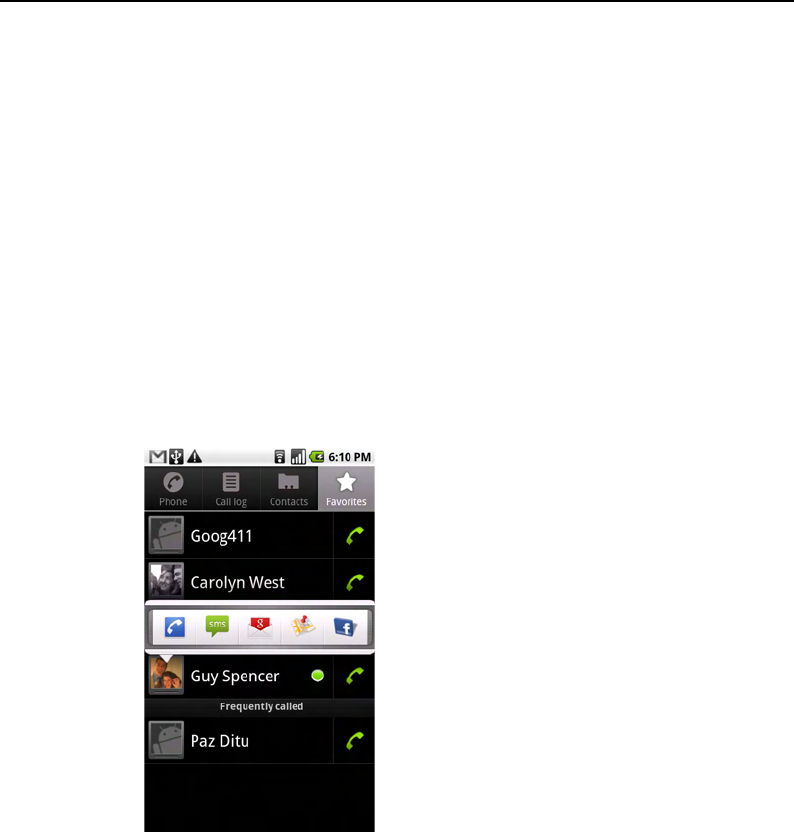
Contacts 98
AUG-2.0.0-100 Android User’s Guide
Communicating with your contacts
From the Contacts or Favorites tab you can quickly call or send a text (SMS) or
multimedia message (MMS) to a contact’s default phone number. You can also open
details about a contact to view a list of all the ways you can communicate with that
contact.
This section describes ways to initiate communication when viewing your list of
Contacts. Contacts shares your contacts with many other applications, such as
Gmail (see “Gmail” on page 113) and Messaging (“Messaging” on page 169). The
sections on those applications describe how to access your contacts when working
in them.
To connect using Quick Contact for Android
1Touch a contact’s icon to open Quick Contact for Android.
2Touch the icon for the way you want to connect.
The icons available depend on the information you have for the contact and the
applications and accounts on your phone.
For more information, see “Connecting quickly with your contacts” on page 54.
Touch a contact’s icon and
then touch the icon for how
you want to connect

Contacts 99
AUG-2.0.0-100 Android User’s Guide
To communicate with a contact
1Open your contacts or favorites.
2Touch the contact you want to communicate with.
You can also just touch the green phone icon in the list of favorites of in the Call
log to call the displayed number.
3In the contact’s details screen, touch the way in which you want to start
communicating with the contact.
For phone numbers, you switch to the Phone application as the number is
called. For other kinds of communication, you switch to the appropriate
application with contact’s address entered.
To call a contact’s default number
1Open your contacts or favorites.
2Touch & hold the contact you want to call.
3Touch Call in the menu that opens.
The actual menu item depends on the default number you set for your contact,
so it may be Call Mobile, Call Work, and so on.
You switch to the Phone application as the number is called. For more
information on placing phone calls, see “Placing and receiving calls” on page 71.
To send a text or multimedia message to a contact’s default number
1Open your contacts or favorites.
2Touch & hold the contact you want to call.
3Touch Text contact in the menu that opens.
You switch to the Messaging application with the contact’s phone number
entered in a new message. For more information on sending text and
multimedia messages, see “Messaging” on page 169.
You can also use Quick Contact to start sending a text or multimedia message
(see “Connecting quickly with your contacts” on page 54).

Contacts 100
AUG-2.0.0-100 Android User’s Guide
Changing which contacts are displayed
You can configure Contacts to hide contacts that don’t have phone numbers. You
can also configure which groups of contacts, for each account, you want to display
in the Contacts list.
To set whether contacts without phone numbers are displayed
If you use your list of contacts only to call people, you may find it more convenient
to hide any contacts that don’t have phone numbers.
1Open your list of contacts.
2Press MENU and touch Display options.
3Check or uncheck Only contacts with phones.
To set which groups of contacts to display
1Open your list of contacts.
2Press MENU and touch Display options.
3Touch an account to open its list of groups.
An account’s groups depend on the kind of account.
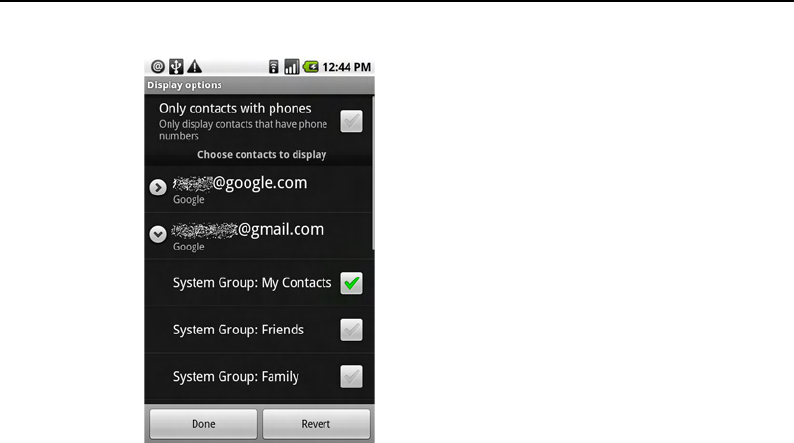
Contacts 101
AUG-2.0.0-100 Android User’s Guide
4Check or uncheck the groups whose contacts you want to view in Contacts.
You only affect the display of groups of contacts with this screen: your sync
settings are not affected.
5Touch Done.
A message appears while your changes are made. If your change affects a great
many contacts, this can take a short while.

Contacts 102
AUG-2.0.0-100 Android User’s Guide
Joining contacts
When you add an account or add contacts in other ways (such as by exchanging
email), Contacts attempts to join any new contact information with existing
contacts under a single entry, to avoid duplication. But you can also join contacts
manually.
To join contacts
1Open your contacts or favorites.
2Touch the contact you want to add information to.
This is the contact you will see in Contacts after you join.
3Press MENU and touch Edit contact.
4Press MENU and touch Join.
Touch the contact whose information you want to join with the first contact.
The information from the second contact is added to the first contact, and the
second contact is no longer displayed in the Contacts list.
See “Editing contact details” on page 95 for details on how to view where a
Contact’s information came from (including automatic and manually joined
information). See “Separating contact information” on page 103 for information
on how to separate contacts joined in error.
Touch the contact whose
information you want to join.

Contacts 103
AUG-2.0.0-100 Android User’s Guide
Separating contact information
Each contact on your phone may contain information from a variety of sources: you
may have entered it, Contacts may have joined information automatically when you
added an account, you may have joined contacts (as described in “Joining contacts”
on page 102), and so on.
If contact information from different sources was joined in error, you can separate
the information back into individual contacts on your phone.
To separate contact information
1Open your contacts or favorites.
2Touch the contact whose information you want to separate.
3Press MENU and touch Edit contact.
4Press MENU and touch Separate contact.
The contact information is separated into individual contacts in the list of
contacts.

Contacts 104
AUG-2.0.0-100 Android User’s Guide

105
AUG-2.0.0-100 Android User’s Guide
Accounts
You can sync contacts, email, and other information to your phone
from multiple Google Accounts, corporate (Exchange) accounts, or
other kinds of accounts (depending on the applications installed on
your phone).
For example, you could start by adding your personal Google
Account, so your personal email, contacts, and calendar are always
available. Then you could add an Exchange account from work, so you
can read your work email and have your work contacts handy. You
can even add multiple Google Accounts and accounts.
In this section
“Adding and removing accounts” on page 106
“Configuring account sync and display options” on page 110

Accounts 106
AUG-2.0.0-100 Android User’s Guide
Adding and removing accounts
You can add multiple Google Accounts and Exchange accounts. You may also be
able to add other kinds of accounts, depending on the applications installed on your
phone.
When you add an account, Contacts compares any new contacts you sync to your
phone with your existing contacts, and attempts to join duplicates into a single
entry in Contacts. (This does not join that data for the accounts themselves; it just
presents it as a single contact in Contacts. See “Joining contacts” on page 102 for
more information on joining contacts manually. See “Configuring account sync and
display options” on page 110 to learn how to separate contact information that was
joined incorrectly.
To add an account
To add some accounts, you may need to obtain details about the service an account
connects to from an IT support representative, for example, the account’s domain
or server address.
1Open the Accounts & sync settings screen.
You can do this in Contacts by pressing MENU and touching Accounts, or
directly in the Settings application.
The Account & sync settings screen displays your current sync settings and a list
of your current accounts.
See “Configuring account sync and display options” on page 110 for details
about configuring existing accounts.
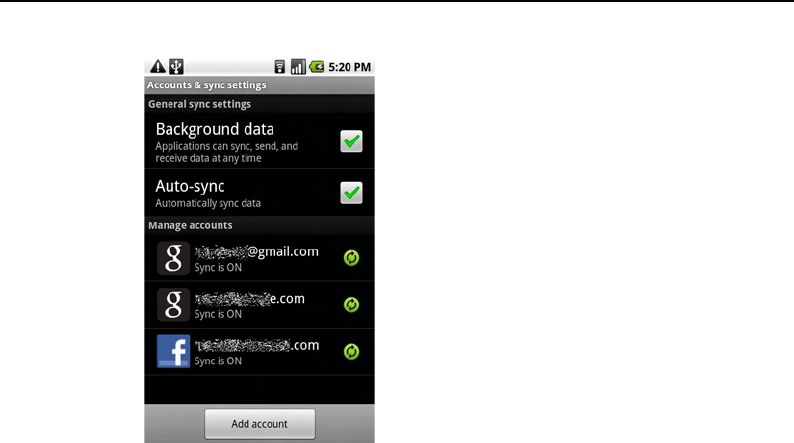
Accounts 107
AUG-2.0.0-100 Android User’s Guide
2Touch Add account.
3Touch the kind of account you want to add.
Touch Add account.
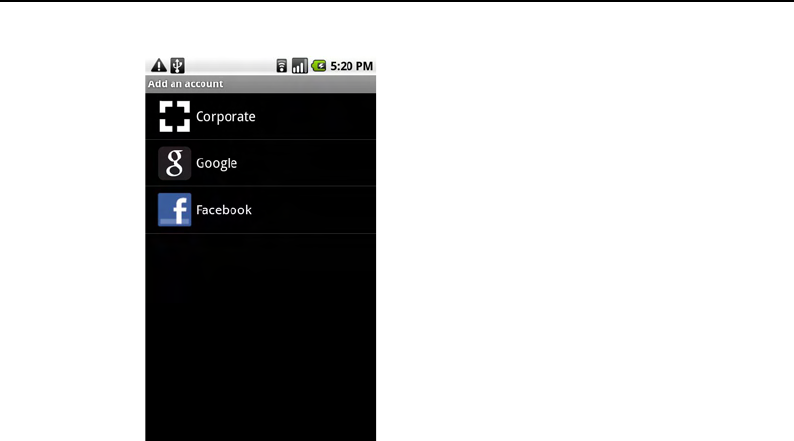
Accounts 108
AUG-2.0.0-100 Android User’s Guide
4Follow the onscreen steps to enter the required and optional information about
the account.
Most accounts require a username and password, but the details depend on the
kind of account and the configuration of the service you’re connecting to.
5Configure the account.
Depending on the kind of account, you may be asked to configure what kinds of
data you want to sync to the phone, name the account, and other details.
When you’re done, the account is added to the list in the Accounts & sync
settings screen and depending on how you configured it, email, contacts, and
other information start syncing to your phone.
See “Configuring account sync and display options” on page 110 for details
about changing how the account is configured.
To remove an account
You can remove an account to delete it an all information associated with it from
your phone, including (for example) email, contacts, settings, and so on.
You can’t remove some accounts, such the first Google Account you signed into on
the phone, except by deleting all personal information from your phone (see
“Privacy settings” on page 269 to learn now to do that).
Touch the kind of account you want
to add.

Accounts 109
AUG-2.0.0-100 Android User’s Guide
1Open the Accounts & sync settings screen.
You can do this in Contacts by pressing MENU and touching Accounts, or
directly in the Settings application.
The Account & sync settings screen displays your current sync settings and a list
of your current accounts.
2Touch the account you want to delete.
3Touch Remove account.
4Confirm you want to remove the account.

Accounts 110
AUG-2.0.0-100 Android User’s Guide
Configuring account sync and display options
You can configure background data use and synchronization options for all the
applications on your phone. You can also configure what kinds of data you
synchronize for each account. Your applications (such as Gmail and Calendar) may
also have their own synchronization settings.
Some applications, such as Contacts and Gmail, can sync data from multiple
applications. Others, such as Calendar, sync data only from the first Google
Account you sign into on your phone, or from an account associated specifically
with that application.
For some accounts, syncing is two-directional: changes you make to the information
on your phone is made to the copy of that information on the web. Your Google
Account works this way. Other accounts support only one-way sync: the
information on your phone is read-only.
You can also use the Contacts display options to configure which kinds of contacts
are displayed, as described in “Changing which contacts are displayed” on page 100.
To configure general sync settings
1Open the Accounts & sync settings.
You can do this in Contacts by pressing MENU and touching Accounts, or
directly in the Settings application (press HOME, press MENU, and touch
Settings).
The Account & sync settings screen displays your current sync settings and a list
of your current accounts.
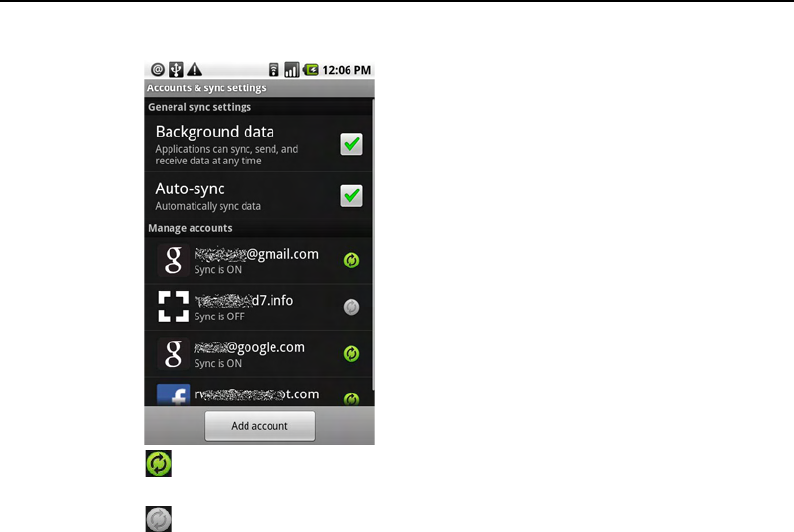
Accounts 111
AUG-2.0.0-100 Android User’s Guide
indicates that some or all of an account’s information is configured to sync
automatically with your phone.
indicates that none of an account’s information is configure to sync
automatically with your phone.
2Check or uncheck Background data to control whether applications and
services can transmit data when you are not working with them directly (that is,
when they are running in the background).
If you uncheck this option, Gmail stops receiving new mail unless you use the
Refresh menu item or send an email, Calendar stops syncing events, and so on.
3Check or uncheck Auto-sync to control whether changes you make to
information on the phone or on the web are automatically synced with each
other.
For example, when this option is checked, changes you make in Contacts on the
phone are automatically made in Google Contacts on the web.
If you uncheck this option, you may be able to use an application’s tools to sync
data manually, or as described in “To sync information manually” on page 111.
To sync information manually
1Open the Accounts & sync settings screen.
2Touch the account whose data you want to sync.
3Press MENU and touch Sync now.
Touch the account you want to
configure.
Some or all information from this
account is configured to sync
automatically with your phone.
No information from this account
syncs automatically with your phone.
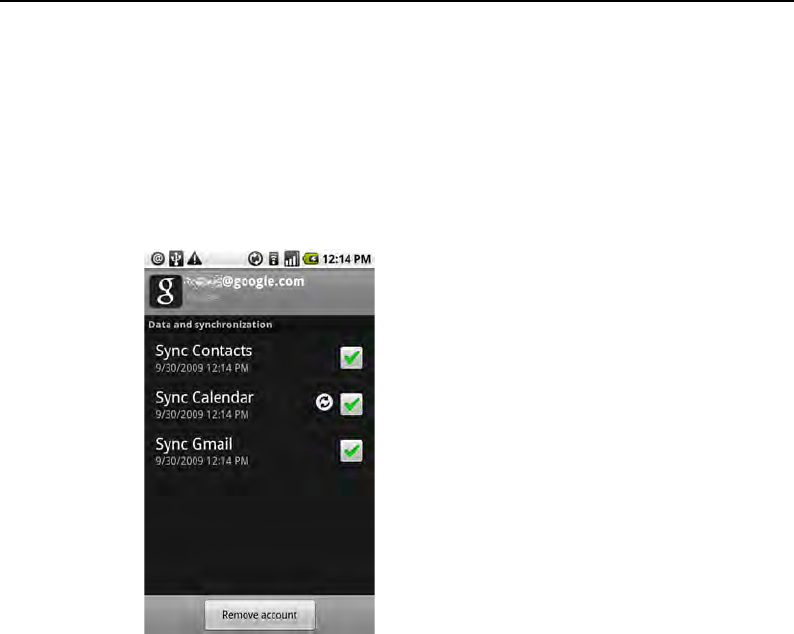
Accounts 112
AUG-2.0.0-100 Android User’s Guide
To change an account’s sync settings
1Open the Accounts & sync settings screen.
2Touch the account whose sync settings you want to change.
The Data & synchronization screen opens, with a list of the kinds of information
the account can sync.
Checked items are configured to sync to your phone.
3Check or uncheck the kinds of information you want to sync to the phone.
Unchecking an option does not remove the information from your phone: it
simply stops it from syncing automatically. To remove the information previously
synced for the account, you must remove the account.

113
AUG-2.0.0-100 Android User’s Guide
Gmail
Gmail is Google’s web-based email service. When you first set up
your phone, you configured it to use an existing Gmail Account, or
you created a new account. The first time you open the Gmail
application on your phone, your Inbox contains the messages from
your Gmail Account on the web.
In this section
“Gmail is different” on page 114
“Opening Gmail and your Inbox” on page 115
“Reading your messages” on page 117
“Composing and sending a message” on page 119
“Replying to or forwarding a message” on page 120
“Working with conversations in batches” on page 121
“Labeling a conversation” on page 122
“Starring a message” on page 123
“Viewing conversations by label” on page 124
“Reporting spam” on page 125
“Searching for messages” on page 126
“Archiving conversations” on page 127
“Synchronizing your messages” on page 128
“Appending a signature to your messages” on page 130
“Changing Gmail settings” on page 131

Gmail 114
AUG-2.0.0-100 Android User’s Guide
Gmail is different
Gmail is web-based Your messages are stored on Google servers, but you
read, write, and organize messages using the Gmail application on your phone or
using a web browser on a computer. Because your mail is stored on Google servers,
you can also search your entire message history, backed by the speed and power of
Google search.
Actions you take in one place are reflected everywhere: for example, if you read a
message in Gmail on your phone, it’s marked as read in a web browser; a message
you send using a web browser, or even a draft of a message, is visible in Gmail on
the phone.
Gmail is conversation-based Each message and all replies to it are grouped
in your Inbox as a single conversation. In other email applications, replies to
messages are sprinkled across your inbox, typically by date received, so a message
and the replies to it are separated by other messages. In this way Gmail makes is
easier to follow the “thread” of a conversation.
Gmail is organized by labels, not folders By tagging messages with
labels, you can organize your conversations in as many ways as you want. In other
email applications, each message can live only in one folder. For example, with Gmail
you can label a conversation with your mother about your brother’s birthday
present with both “Mom” and “Dave.” Later, you can look for the message under
either label. Using folders, you’d have to store the message in the “Mom” folder or
the “Dave” folder, not both.
Gmail for the phone is optimized for mobile: use the web to
organize Gmail The best place to organize and learn about Gmail is the web.
For example, you can’t use the Gmail application on the phone to create the labels
and filters you use to organize your messages, but you can label a message. Gmail
on the web also offers a host of information about the service, so it’s the best place
to learn about all of the features of Gmail.
Gmail is for Gmail Of course you can use Gmail to send email to any email
address and anyone can send email to you at your Gmail address, but if you want to
read messages from another email service provider (using your AOL, Yahoo!, or
other email account), use the Email application (see “Email” on page 159).
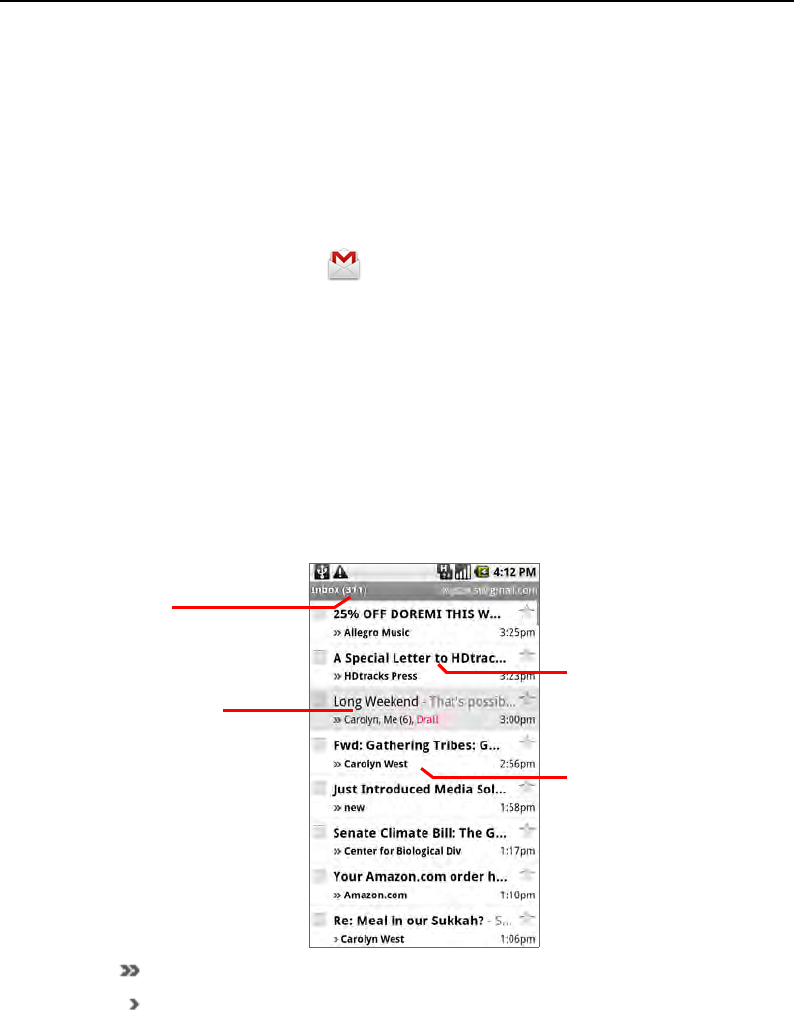
Gmail 115
AUG-2.0.0-100 Android User’s Guide
Opening Gmail and your Inbox
When you open Gmail, it displays the most recent conversations in your Inbox. Or
if you return to Gmail after using other applications, Gmail displays the last screen
you were working with.
To open Gmail
STouch the Gmail icon on the Home screen or in the Applications tab.
See “Opening and switching applications” on page 40 to learn more about
opening and switching applications.
Your Inbox displays conversations with the newest messages at the top. All your
conversations are in your Inbox unless you delete, archive, or filter them.
The current Google Account is displayed at the top-right of the Inbox. If you
have more than one account, you can switch accounts to view the messages in
its Inbox, as described in “To switch Accounts” on page 116. (Adding and
working with accounts is described in “Accounts” on page 105.)
Conversations with new messages have bold subjects. To read a message in a
conversation, touch its subject (see “Reading your messages” on page 117).
indicates messages sent directly to you.
indicates messages you were CC’d on.
Other messages were sent to you as part of a group.
Touch a conversation to open
it and read its messages
The number of unread
messages in your Inbox
Bold subjects indicate
conversations with new
(unread) messages
There are 3 messages in this
conversation.
Your account.
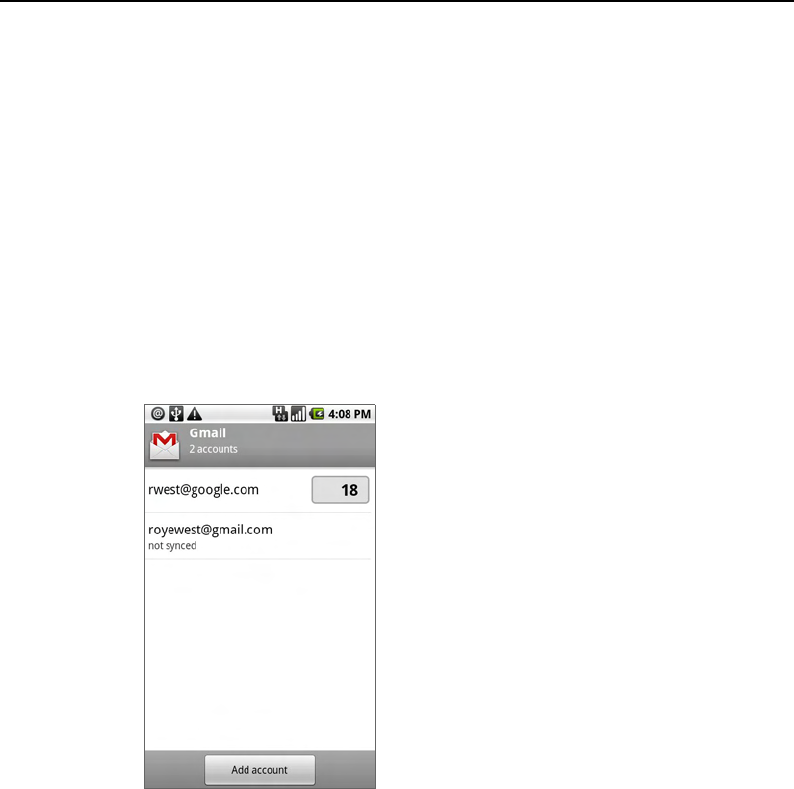
Gmail 116
AUG-2.0.0-100 Android User’s Guide
To open your Inbox when Gmail is running
SPress the BACK key until you return to your Inbox.
OR
SWhen reading a message or viewing a list of labeled conversations, the MENU
key and touch Back to Inbox.
To switch Accounts
Gmail displays conversations and messages from one Google Account at a time. If
you have more than one account, you can open the Accounts screen to view how
many unread messages you have in each account and to switch accounts.
1From your Inbox, press MENU and touch Accounts.
2Touch the account with email you want to read.
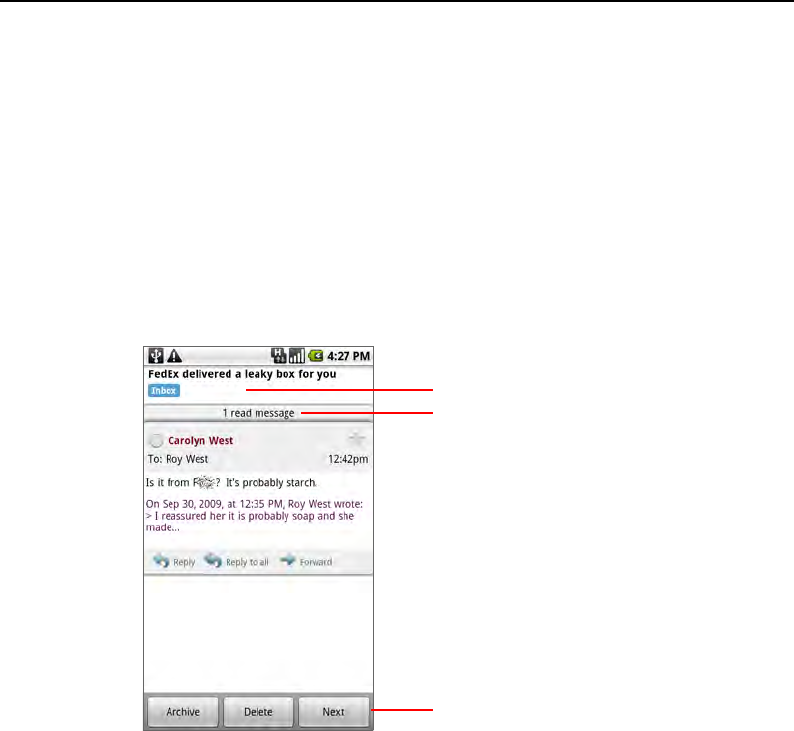
Gmail 117
AUG-2.0.0-100 Android User’s Guide
Reading your messages
When viewing a list of conversations in your Inbox or in any list of labeled
conversations, you can open a conversation to read its messages.
To read a message
STouch a conversation that contains the message you want to read.
A conversation opens to the first new (unread) message, or to the first starred
message, if you’ve previously starred a message in the conversation (see
“Starring a message” on page 123).
The Google Talk online status is shown next to the name of the sender of each
message. You can touch that status indicator to open Quick Contact (see
“Connecting quickly with your contacts” on page 54.
When reading messages in a conversation, you can use the buttons at the
bottom of the screen to archive the entire conversation (see “Archiving
conversations” on page 127) or to delete it. If you delete a conversation, you
can touch Undo in the yellow bar at the top of the screen to undelete it.
You can also touch Next to read the next unread message in a conversation in
your Inbox (or the conversation list you’re working in). Press the BACK button
to reread the last message you read.
You can scroll to the bottom of a message to view buttons for replying to or
forwarding the message, as described in “Replying to or forwarding a message”
on page 120.
This conversation has two labels.
Touch to view the sender and first line
of messages you’ve already read.
You can archive or delete the entire
conversation or read your next unread
message.
Touch a sender’s Talk status icon to
open Quick Contact.
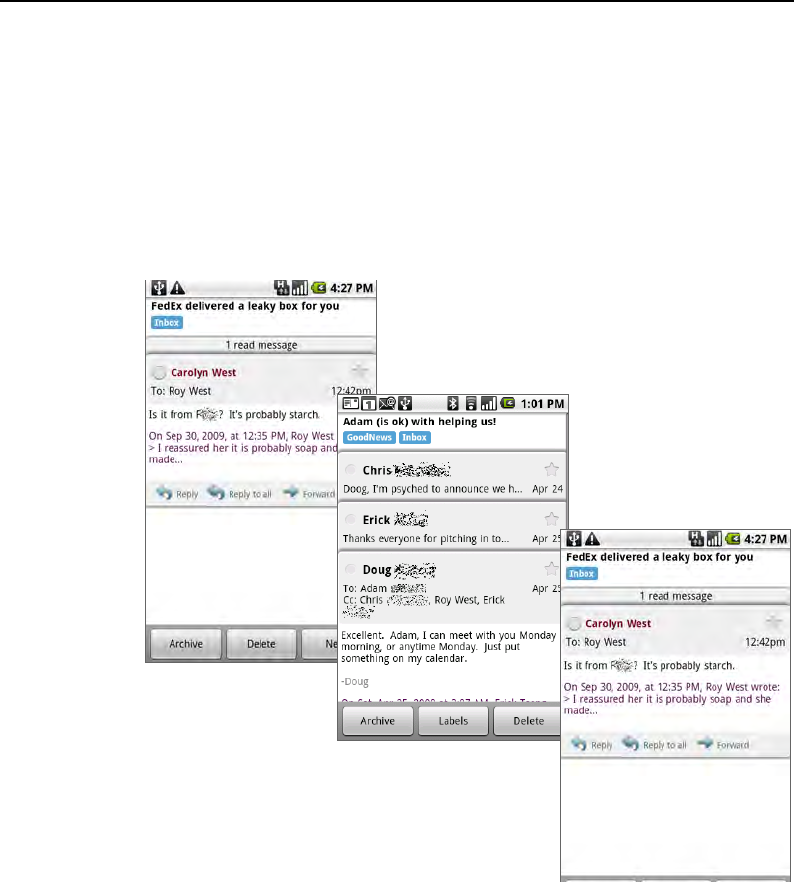
Gmail 118
AUG-2.0.0-100 Android User’s Guide
To reread a message
When you open a conversation, messages you’ve already read are hidden, in a tab
that indicates the number of hidden messages.
1Touch the tab that indicates the number of previously read messages.
The tab expands into tabs that list the sender and first line of each read
message.
2Touch an expanded tab to reread the body of the message.
When reading a message or when its tab is selected, you can press MENU and
touch Mark read to return a read message to the unread state—for example, to
remind yourself to read it again later.
Touch the tab
that indicates the number of unread
messages to view their summary tabs.
Touch the tab of a message you’ve
already read to open it, so you can read
it again.
<<Need to reshoot 3
screens; see Donut book for
details.>>

Gmail 119
AUG-2.0.0-100 Android User’s Guide
Composing and sending a message
You can compose and send a message to people or groups with Gmail or other
email addresses.
To compose and send a message
1Press MENU and touch Compose.
2Address the message.
As you enter text, matching addresses are offered from your Contacts (see
“Contacts” on page 87). You can touch a suggested message or enter a new
one.
3Press MENU and touch Add Cc/Bcc to address a copy or blind copy of the
message.
4Enter a subject for the message.
5Enter the text of the message.
For more information about entering and editing text, see “Using the onscreen
keyboard” on page 35 and “Editing text” on page 38.
6Press MENU and touch Attach to send a photo with the message.
See “Gallery” on page 215 to learn more about working with photos.
7Touch Send.
If you’re not ready to send the message, touch Save as draft instead. You can
read your drafts by openings email with the Draft label (see “Viewing
conversations by label” on page 124).
Touch Discard to abandon the message, including any saved drafts.
If you aren’t connected to a network, for example, if you’re working in Airplane
mode, the messages you send are stored on your phone with the Outbox label,
until you connect to a network again.
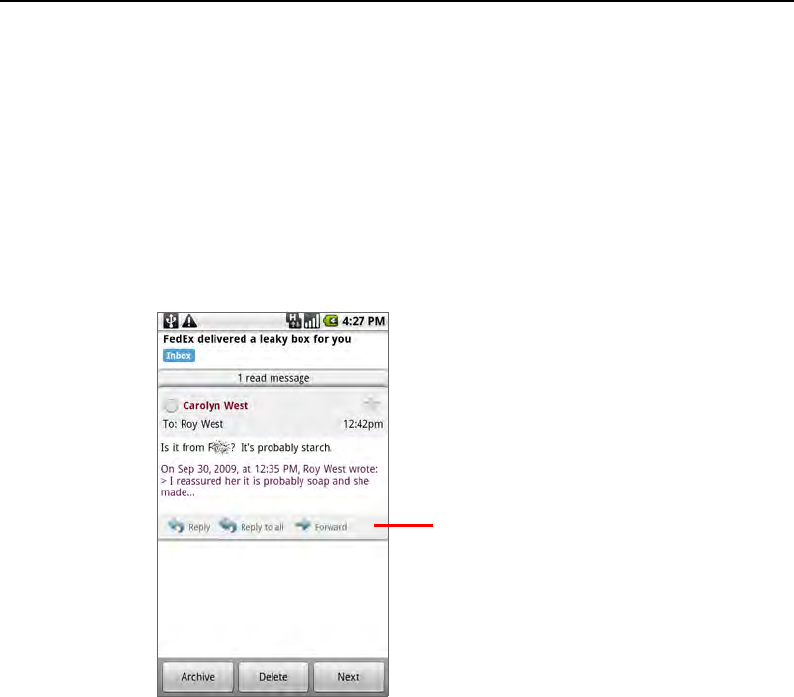
Gmail 120
AUG-2.0.0-100 Android User’s Guide
Replying to or forwarding a message
When reading a message, you can continue the conversation by replying to it or
forwarding it.
To reply to or forward a message
1Scroll to the bottom of a message.
2Touch Reply, Reply to all, or Forward.
Replying to messages without changing the subject adds your reply to the
current conversation. Forwarding a message or changing the subject starts a
new conversation.
The message opens in a new screen where you can add or remove addresses,
edit the subject, and add or remove text or attachments, as described in
“Composing and sending a message” on page 119.
You can add one or more people to an ongoing conversation by replying to all
and then adding the new people’s addresses to the reply.
All the messages in the conversation, up to the one you are replying to or
forwarding, are included in the new message; later messages are omitted.
3Touch Send.
Touch Reply to reply just to the
sender of the message; Touch
Reply to all to include all other
recipients of the message. Touch
Forward to send the
conversation to someone new.
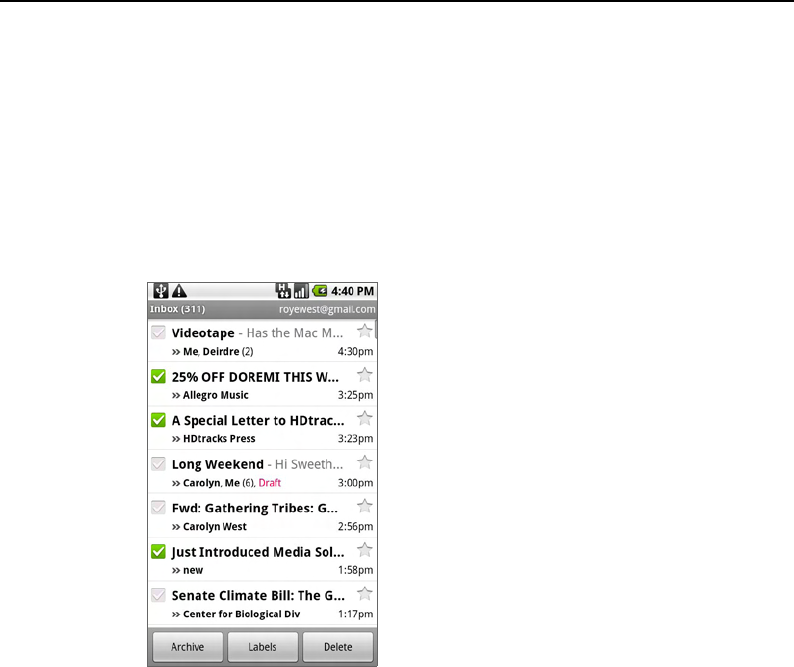
Gmail 121
AUG-2.0.0-100 Android User’s Guide
Working with conversations in batches
You can archive, label, delete, or perform other actions on a batch of conversations
at once, in your Inbox or in another labeled list of conversations.
1In the Inbox or other conversation list, check the conversations you want to
work with as a batch.
When you check a conversation, the Archives, Labels, and Delete buttons
appear at the bottom of the screen.
2Touch Archive, Label, or Delete. Or press MENU and touch Add star,
Report spam, Mute, Mark read / Mark unread, or Deselect all.
You action affects the entire batch of messages.
If you delete a batch of conversations, you can touch Undo in the yellow bar at
the top of the screen to undelete them.
You can hide the checkboxes if you never work with batches of messages, to give
more room for the subjects of conversations (see “Changing Gmail settings” on
page 131).
Check conversations to add
them to the batch.
Touch a button to acton on the
batch, or press MENU to act
on the batch in other ways.

Gmail 122
AUG-2.0.0-100 Android User’s Guide
Labeling a conversation
You organize conversations by labeling them. Gmail has several built-in labels; you
can also add your own, using Gmail on the web.
Viewing labeled conversations is described, along with a list of standard labels, in
“Viewing conversations by label” on page 124.
To label a conversation
1When reading a conversation’s messages, press MENU and touch Change
labels.
2In the dialog that opens, check the labels you want to assign to the conversation.
To label a batch of conversations at once
You can use the following steps to assign or change the labels of one or more
conversations at once.
1In your Inbox or other conversation list, check the conversations you want to
label.
See “Working with conversations in batches” on page 121.
2Touch the Labels button at the bottom of the screen.
3In the dialog that opens, check the labels you want to assign to the conversation.
4Touch OK.
To change a conversation’s labels
1When reading a conversation’s messages, press Menu and touch Change
labels.
You can also change a batch of conversations’ labels, in the same way as you
label a batch of conversations, using the Labels button.
2In the dialog that opens, check and uncheck the labels you want.
3Touch OK.

Gmail 123
AUG-2.0.0-100 Android User’s Guide
Starring a message
You can star a message that is important to you for any reason. Conversations with
starred messages display a star in your Inbox and other conversation lists. To view
just conversations with starred messages, see “Viewing conversations by label” on
page 124.
To star a message
SWhen reading a message, touch the star in its header.
OR
SWhen viewing a conversation, touch its star to star the newest message in the
conversation.
To unstar a message
STouch its star again.
To unstar all messages in a conversation
STouch a star in a conversation list.
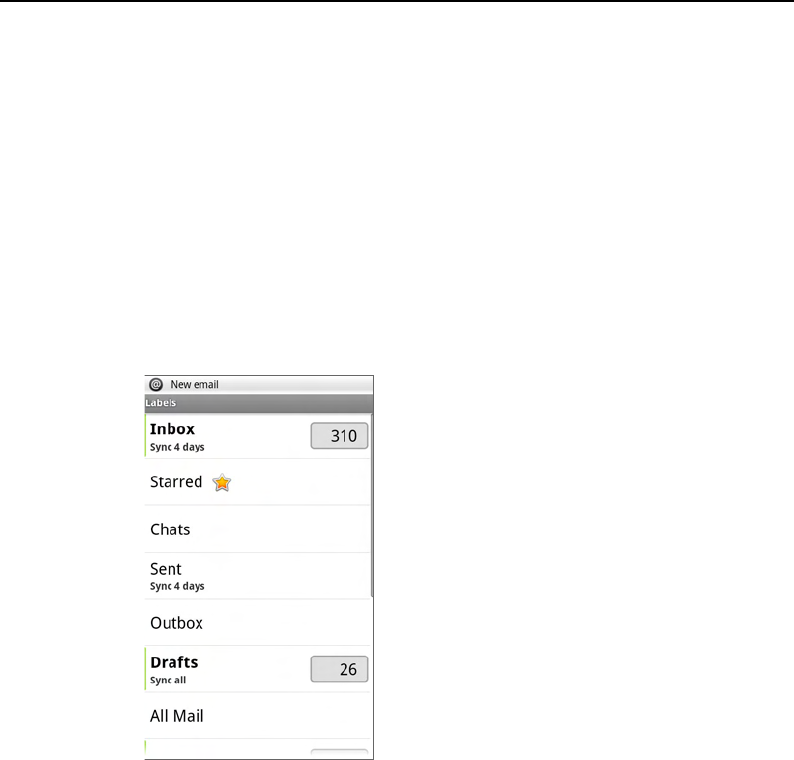
Gmail 124
AUG-2.0.0-100 Android User’s Guide
Viewing conversations by label
You can view a list of the conversations that have the same label, including
conversations with starred messages.
You can control how many conversations are kept current on your phone, by label
and time, as described in “Synchronizing your messages” on page 128.
See “Labeling a conversation” on page 122 or “Starring a message” on page 123 for
information on assigning labels and stars.
1When viewing your Inbox or another conversation list, press MENU and touch
View labels.
Your labels are presented in a scrolling list.
2Touch a label to view a list of conversations with that label.
The conversation list resembles your Inbox, but the label replaces “Inbox” in the
title bar. You work with labeled conversation lists in the same way as with your
Inbox.
Indicates how many messages with this
label are kept current on your phone
Labels applied to conversations with
unread messages are bold and have a
green bar.
The number of conversations with this
label that have unread messages.

Gmail 125
AUG-2.0.0-100 Android User’s Guide
Reporting spam
The Gmail webmail service works hard to prevent spam (unwanted and unsolicited
“junk” mail) from reaching your Inbox. But when spam makes it through, you can
help improve the Gmail service by reporting the conversation as spam.
To report a conversation as spam
SWhen reading the conversation's messages, press MENU and touch More >
Report spam.
OR
SCheck one or a batch of conversations in your Inbox or other conversation list,
press MENU, and touch Report as spam.
See “Working with conversations in batches” on page 121.
When you report a conversation as spam, the conversation and all its messages
are removed from your Inbox. You can view the messages you’ve marked as
spam by viewing messages with the Spam label (see “Viewing conversations by
label” on page 124).

Gmail 126
AUG-2.0.0-100 Android User’s Guide
Searching for messages
You can search for messages that contain one or more words in their contents or in
their addresses, subjects, labels, and so on. When you search for messages, all the
messages in your Gmail account on the web are included (except those labeled
Trash or Spam), not just those you’ve synchronized onto your phone.
You can also use the advanced search options that are described on the Gmail web
site.
1In the Inbox, press MENU and touch Search.
2Enter the word or words you want to search for and touch Search.
A conversation list opens, with all the conversations with messages that contain
the words you searched for. The words you searched for are displayed in the
title bar.
You work with the conversations in this list just as you would with the
conversations in your Inbox or any other conversation list.

Gmail 127
AUG-2.0.0-100 Android User’s Guide
Archiving conversations
You can archive conversations, to move them out of your Inbox without deleting
them. Archived conversations are assigned the All Mail label and retain any other
labels you’ve assigned to them (see “Viewing conversations by label” on page 124).
They’re also included in search results. If someone replies to a message you’ve
archived, its conversation is restored to your Inbox.
SWhen viewing a list of conversations, touch & hold a conversation and touch
Archive in the context menu that opens.
OR
SWhen reading a message, touch Archive at the bottom of the screen.
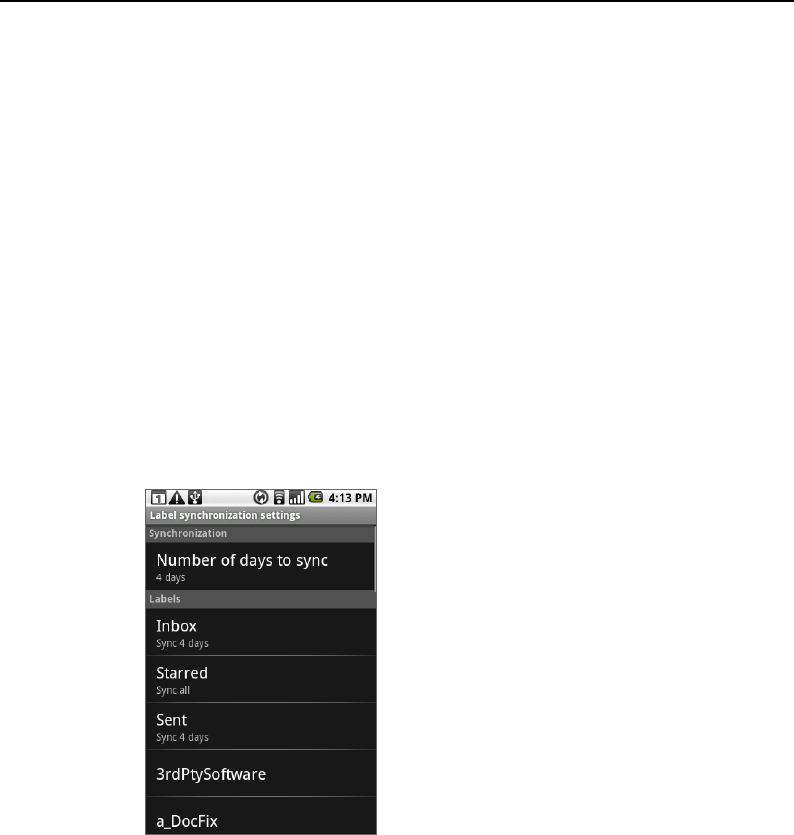
Gmail 128
AUG-2.0.0-100 Android User’s Guide
Synchronizing your messages
The Gmail webmail service has enormous resources for storing your messages;
your phone does not. Gmail only downloads some of your messages to your phone,
to save space. You can set which conversations are kept current on your phone, by
label, and what portion of those conversations, by time.
You use the Settings application to control how and when applications synchronize
their data. See “Accounts & sync settings” on page 268.
To select which conversations to synchronize
1Open your Inbox.
2Press MENU and touch Settings > Labels.
The Label synchronization settings screen opens, with a scrolling list of your
Gmail labels. Below each label is its current synchronization setting: Sync all,
Sync 4 days, or no label (conversations with that label are not synchronized).
3Touch a conversation label whose synchronization settings you want to change.
A dialog for that conversation label opens, with three options:
Sync none Don’t download any conversations that have only this label
Sync 4 days Download the previous 4 (or number of days you set) of
conversations
Sync all Download all conversations with this label

Gmail 129
AUG-2.0.0-100 Android User’s Guide
To set how many days of conversations to synchronize
1Open your Inbox.
2Press MENU and touch Settings > Labels.
3Touch Number of days to sync.
Enter the number of days and touch OK.
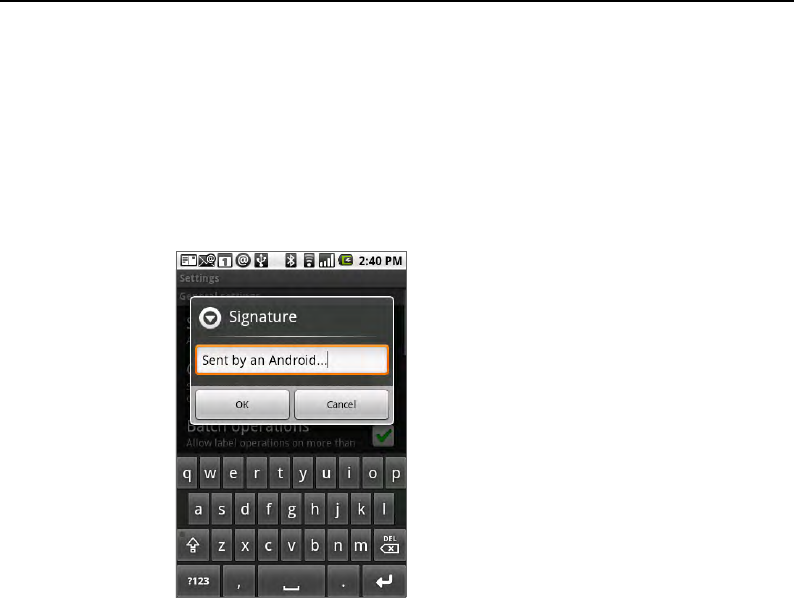
Gmail 130
AUG-2.0.0-100 Android User’s Guide
Appending a signature to your messages
You can append one or a few lines of text to every message you send, such as your
name, contact info, or even “Sent by an Android.”
1Open your Inbox or another labeled list of Conversations.
2Press MENU and touch Settings > Signature.
3Enter a signature.
4Touch OK.
Enter a signature to append to your
messages and touch OK.

Gmail 131
AUG-2.0.0-100 Android User’s Guide
Changing Gmail settings
You can change a number of settings for Gmail. Notification volumes and some
synchronization settings are changed in the Settings application (see “Settings” on
page 255).
STo change Gmail settings, open your Inbox, press MENU, and touch Settings.
General Settings
Signature Opens a dialog where you can enter text to append to every message
you send. See “Appending a signature to your messages” on page 130.
Confirm delete Check to open a dialog each time you delete messages, asking
you to confirm that your want to delete them.
Batch operations When checked, adds a check box to the left of each
conversation, so you can add it to a batch. See “Working with conversations in
batches” on page 121.
Clear search history Touch to remove the history or search results you’ve
touched when searching for messages.
Labels Opens the Labels screen, where you can manage which conversations are
synchronized. See “Synchronizing your messages” on page 128.
Notification settings
Email notifications Check to receive a notification whenever you receive new
email. See “Managing notifications” on page 46.
Select ringtone Opens a dialog where you can select the ringtone to sound
when you receive new email notifications.
Vibrate Check to vibrate the phone when you receive a new email notification.

Gmail 132
AUG-2.0.0-100 Android User’s Guide

133
AUG-2.0.0-100 Android User’s Guide
Calendar
Calendar works with Google Calendar web-based calendaring service
for creating and managing events, meetings, and appointments.
When you first set up your phone, you configured it to use an existing
Google Account, or you created a new account. The first time you
open the Calendar application on your phone, it displays any existing
calendar events from your Google Account on the web.
Calendar on the phone is optimized for the phone. There are some
Calendar features (such as creating Calendars and inviting guests to
events) that are only available in Calendar on the web. Be sure to visit
Google Calendar on the web (http://calendar.google.com) to learn
more about the features of the web and phone versions.
In this section
“Viewing your calendar and events” on page 134
“Working in Agenda view” on page 136
“Working in Day view” on page 137
“Working in Week view” on page 138
“Working in Month view” on page 139
“Viewing an event’s details” on page 140
“Creating an event” on page 141
“Editing or deleting an event” on page 142
“Setting a reminder for an event” on page 143
“Setting a reminder for an event” on page 143
“Responding to an event reminder” on page 144
“Displaying and synchronizing calendars” on page 145
“Changing Calendar settings” on page 146
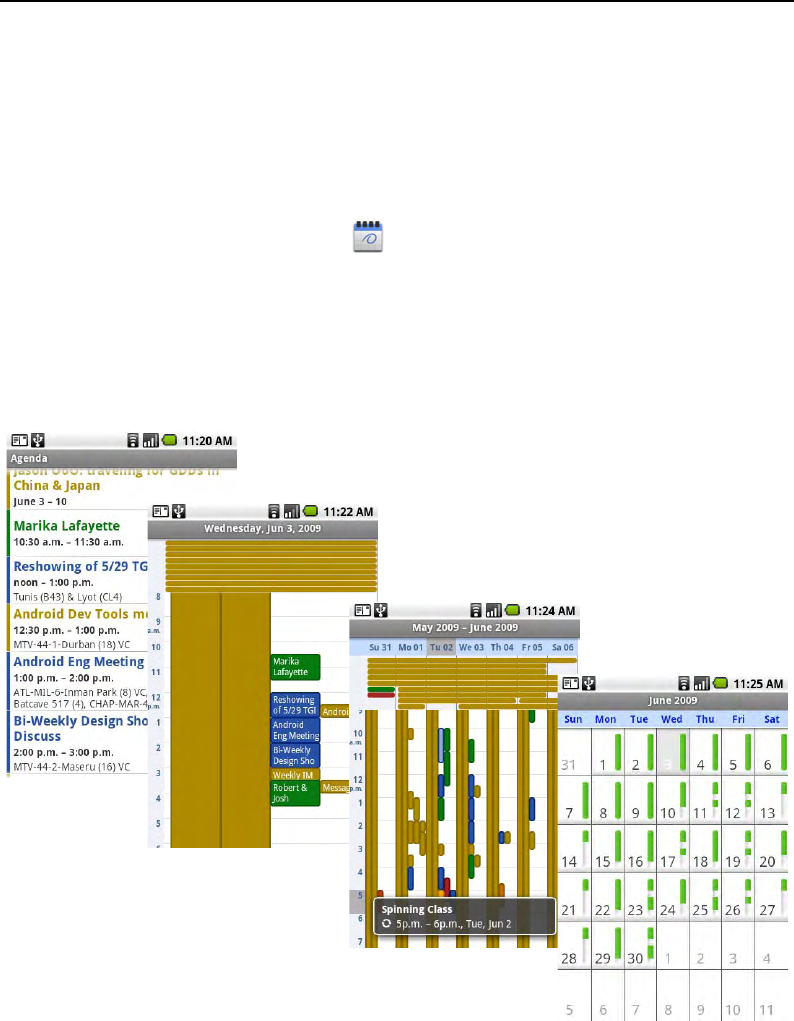
Calendar 134
AUG-2.0.0-100 Android User’s Guide
Viewing your calendar and events
Open Calendar to view the event you have scheduled in the coming days, weeks, or
months.
To open your calendar
STouch the Calendar icon on the Home screen or in the Applications tab.
See “Opening and switching applications” on page 40 to learn more about
opening and switching applications.
If you have created or subscribed to more than one calendar using Google
Calendar on the web, events from each calendar are displayed in a different
color. For more information about which calendars are displayed on your phone,
see “Displaying and synchronizing calendars” on page 145.
Agenda view
Week view
Day view
Month view
In Day or Week view, touch an event to
view its details.
Touching a day in Month view opens that day’s
events

Calendar 135
AUG-2.0.0-100 Android User’s Guide
To change your calendar view
SPress MENU and touch Agenda, Day, Week, or Month.
Each view displays in the events in your calendar for a period of time. For
details, see:
“Working in Agenda view” on page 136
“Working in Day view” on page 137
“Working in Week view” on page 138
“Working in Month view” on page 139
STo view more information about an event in Agenda view, touch the event.
STo view more information about an event in Day or Week view, touch the event
to open a quick view summary. Touch the quick view for even more information.
STo view the events of a day in Month view, touch a day.
You can also use the TRACKBALL to quickly select events in Agenda, Day, and
Week views, which displays a summary of that event, and to select days in Month
view. Press the TRACKBALL for more information about the selected event or
day.
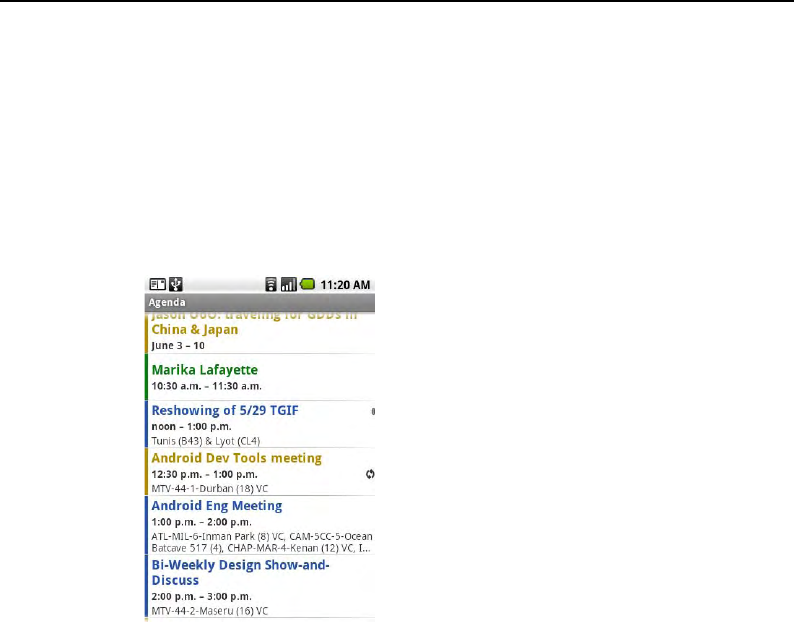
Calendar 136
AUG-2.0.0-100 Android User’s Guide
Working in Agenda view
Agenda view is a list of your events in chronological order. All-day or multi-day
events are listed at the start of each day.
To switch to Agenda view
SPress MENU and touch Agenda.
To learn more about events in Agenda view
STouch an event.
A screen with details about the event opens. See “Viewing an event’s details” on
page 140.
Touch an event to view its details.
Drag up or down to view earlier or later
events
This event repeats
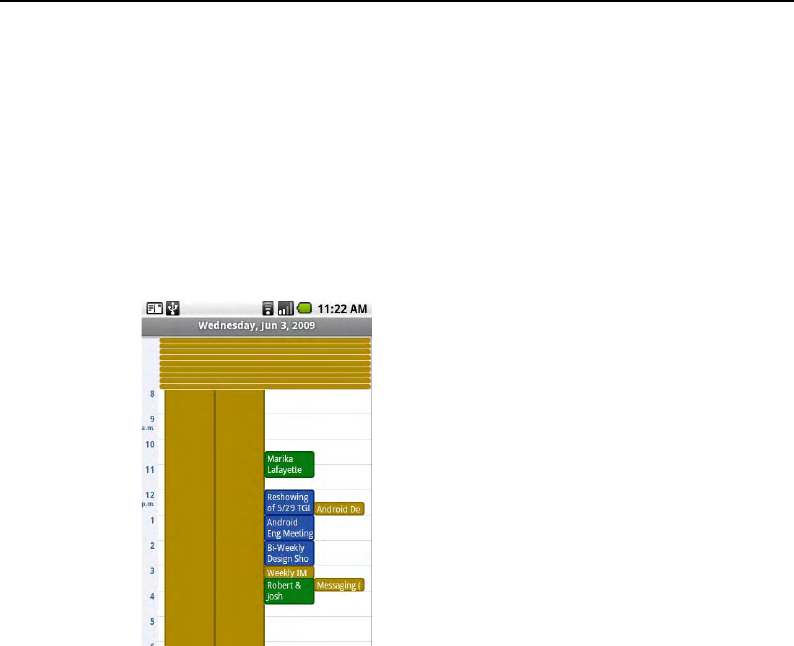
Calendar 137
AUG-2.0.0-100 Android User’s Guide
Working in Day view
Day view displays a chart of the events of one day, in a table of one-hour rows. All-
day or multi-day events are displayed at the top. As much of the title of each event
is displayed in the rows corresponding to when it occurs.
To switch to Day view
SPress MENU and touch Day.
To learn more about events in Day view
STouch an event to view the event’s details.
For more information, see “Viewing an event’s details” on page 140.
STouch & hold an event to open a menu with options for viewing, editing, or
deleting the event, and for creating a new event at that time.
To add an event in Day view
STouch & hold an empty spot or an event in the day to open a menu with the
option for creating a new event at that time.
See “Creating an event” on page 141 for details.
Touch an event to view its details.
Drag left or right to view earlier
or later days
Touch & hold an event to view
more detail about the event or
create a new event at that time
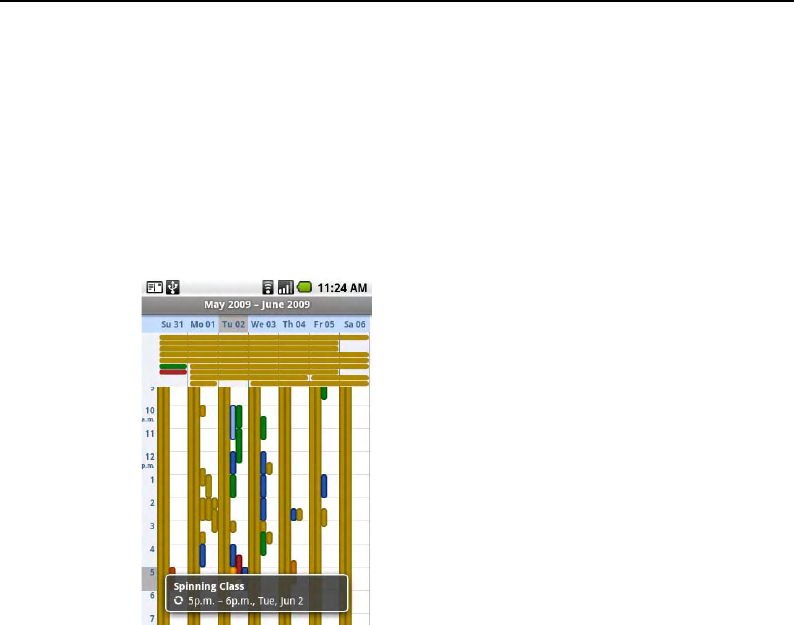
Calendar 138
AUG-2.0.0-100 Android User’s Guide
Working in Week view
Week view displays a chart of the events of one week. All-day or multi-day events
are displayed at the top.
To switch to Week view
SPress MENU and touch Week.
In a crowded Week view, it can be easiest to select events using the
TRACKBALL. Press the TRACKBALL to view more information about the
selected event.
To learn more about events in Week view
STouch an event to view the event’s details.
For more information, see “Viewing an event’s details” on page 140.
STouch & hold an event to open a menu with options for viewing, editing, or
deleting the event, and for creating a new event at that time.
To add an event in Week view
STouch & hold an empty spot or an event in the week to open a menu with the
option for creating a new event at that time.
See “Creating an event” on page 141 for details.
Touch an event to view its details.
Drag left or right to view earlier
or later weeks
Touch & hold an event to view
more detail about the event or
create a new event at that time
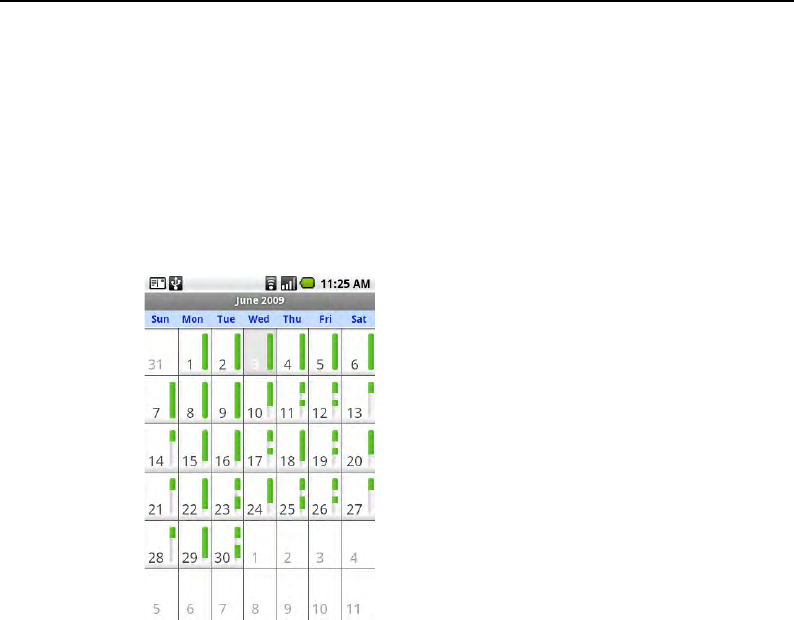
Calendar 139
AUG-2.0.0-100 Android User’s Guide
Working in Month view
Month view displays a chart of the events of the month. Segments of each day with
events are green in each day’s vertical bar.
To switch to Month view
SPress MENU and touch Month.
To view more information about events in Month view
STouch a day to view its events in Day view.
See “Working in Day view” on page 137.
Drag up or down to view earlier
or later months
Touch a day to view the events of
that day.
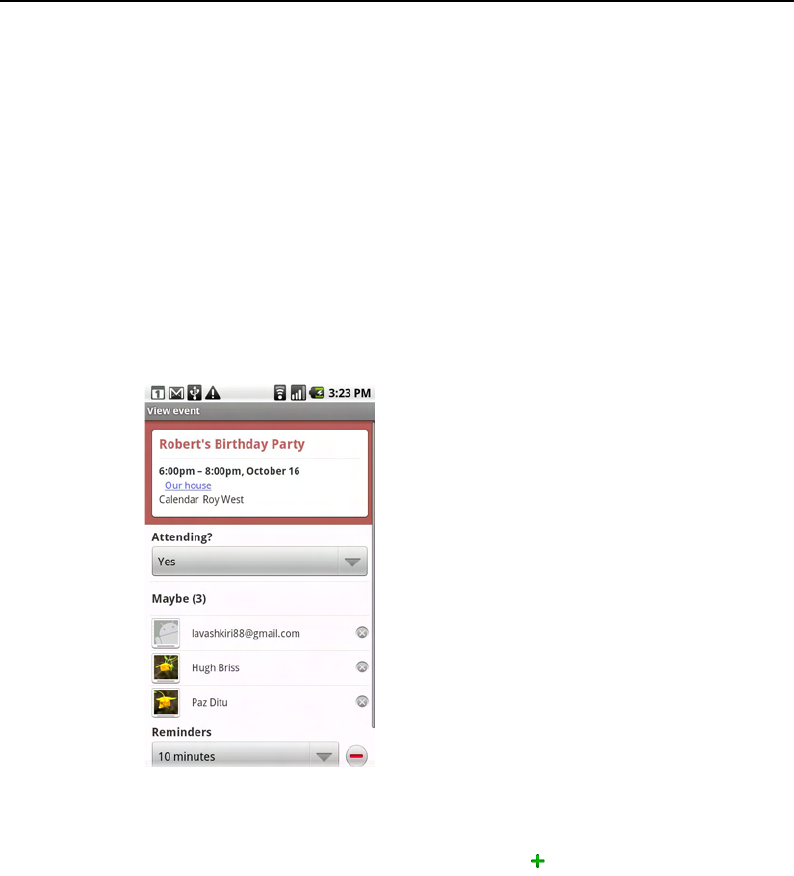
Calendar 140
AUG-2.0.0-100 Android User’s Guide
Viewing an event’s details
You can view more information about an event in a number of ways, depending on
the current view.
To view information about an event
SIn Agenda, Day, or Week view, touch an event to view its details.
SIn Month view, touch a day to switch to Day view. Then touch the event whose
details you want to view to open a summary, and touch the summary to view
the details.
<<Update screen shot with a reminder.>>
You can set or change whether you will attend the event with the Attending? menu.
Other attendees’ status is displayed below your own.
You change any event reminders or touch the plus button to add one (see
“Setting a reminder for an event” on page 143).
If you have permission to change events on the event’s calendar, you can press Menu
to edit or delete the event, as described in “Editing or deleting an event” on
page 142.
Touch to delete this reminder.
Touch to set whether you’ll attend this
event.
Other attendees’ status is shown below
yours.
Touch to change when you want to be
reminded about this event.
Touch to add another reminder for this
event.

Calendar 141
AUG-2.0.0-100 Android User’s Guide
Creating an event
You can use Calendar on your phone to create events that appear on your phone
and in your Google Calendar on the web.
To create an event
1On any Calendar view, press MENU and then touch New event to open the
Event details screen.
You can also touch & hold a spot in Day, Week, or Month view to open a menu
where you can touch New event, to open the Event details screen with that
day and time pre-entered.
2Add details about the event.
You enter a name, time, and optional additional events about the event, just as
you do in Google Calendar on the web.
If you have more than one calendar, you can choose the calendar you want to
add the event to.
You can touch the plus button to add additional reminders (see “Setting a
reminder for an event” on page 143).
3Invite guests to the event.
In the Guests field, enter the email addresses of anyone you want to invite to
the event. Separate multiple addresses with commas ( , ). If the people you send
invitations use Google Calendar, they’ll receive an invitation in Calendar, as well
by email.
4Press MENU and touch Show extra options to add additional details about
the event.
5Scroll to the bottom of the Event details screen and touch Done.
The event is added to your calendar.
To configure additional details, open the event in Google Calendar on the web.

Calendar 142
AUG-2.0.0-100 Android User’s Guide
Editing or deleting an event
You can an edit or delete an event you created on the phone or on the web. You
can also edit or delete events created by others, if they have given you permission.
To edit an event
1Open the event’s summary.
See “Viewing an event’s details” on page 140.
2Press MENU and touch Edit event.
The Event details screen opens for the event. This is the same screen described
in “Creating an event” on page 141.
You can press MENU and touch Show extra options to add or edit
additional event details.
3Make the changes you want to the event.
4Scroll to the bottom of the screen and touch Done.
To delete an event
There are a number of ways to delete an event.
SIn Agenda view, touch an event to view its details. Then press MENU and touch
Delete.
SIn Day or Week view, touch & hold the event and touch Delete in the menu
that opens.
SWhen viewing the summary of an event, press MENU and touch Delete.
SWhen editing an event, scroll to the bottom of the Event details screen and
touch Delete.
If the event repeats, you’re asked whether you want to delete just that
occurrence, this and all future occurrences, or all past and future occurrences in
your calendar.

Calendar 143
AUG-2.0.0-100 Android User’s Guide
Setting a reminder for an event
You can set one or more reminders for an event, whether or not you created the
event or have permission to edit its other details.
To set a reminder for an event
1Open the event’s summary.
See “Viewing an event’s details” on page 140.
2Touch the plus button to add a reminder.
A new reminder is added, for 10 minutes before the event.
3Touch the reminder time and in the dialog that opens, touch the amount of time
before the event that you want to be reminded of it.
When the time comes, you’re sent a notification that the event is upcoming (see
“Responding to an event reminder” on page 144).
You can use Calendar on the web to configure additional reminder settings.
To delete an event reminder
SOpen the event’s summary.
Touch the event’s minus button.
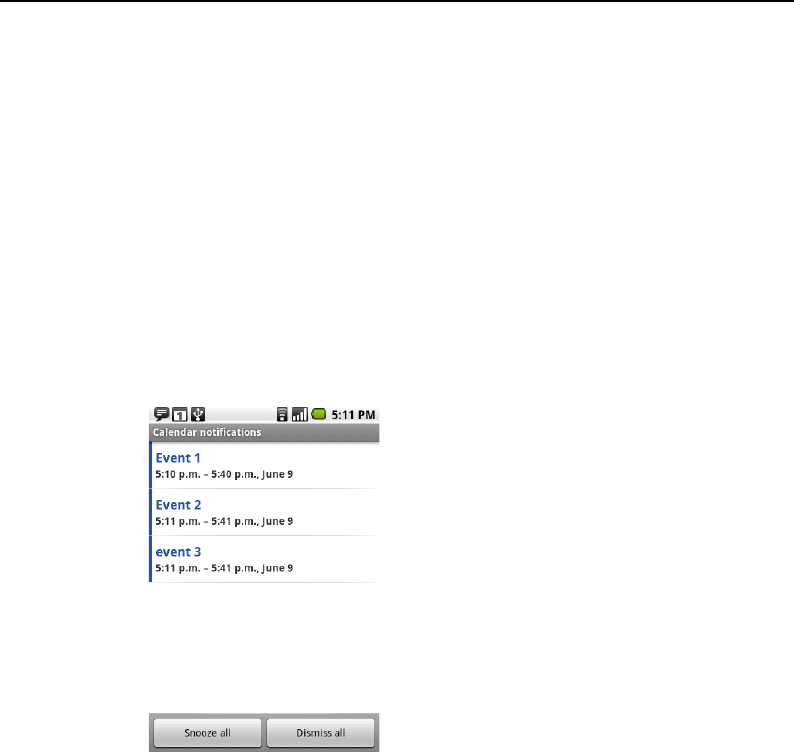
Calendar 144
AUG-2.0.0-100 Android User’s Guide
Responding to an event reminder
If you set a reminder for an event, the upcoming event icon appears in the
notifications area of the status bar when the reminder time arrives. (See “Managing
notifications” on page 46 for more information on responding to notifications.)
To respond to an event reminder
SIf you receive notifications in the status bar, touch the status bar and slide your
finger down to open the Notifications panel. Then touch the event notification
to open the list of Calendar notifications.
SIf you receive notifications with alerts, the Calendar notifications list opens,
listing all notifications awaiting your response.
STouch an event in the Calendar notifications list to view more information about
that event.
STouch Snooze all in the Calendar notifications list to snooze all event
reminders for five minutes.
STouch Dismiss all in the Calendar notifications list to delete all reminders in
the list.
SPress BACK when viewing the Calendar notifications list to keep the reminders
pending: the icon remains in the status bar and the reminders remain in the
Notifications panel.
Touch an upcoming event to view
its details.
Touch Snooze all to be reminded
of all upcoming events in 5 minutes.
Touch Dismiss all to delete all the
reminders in the list.

Calendar 145
AUG-2.0.0-100 Android User’s Guide
Displaying and synchronizing calendars
Initially, all calendars you create or subscribe to in Google Calendar on the web are
also displayed in Calendar on your phone. But you can pick which calendars you
want to show or hide on the phone, and which you want to keep synchronized.
You also control whether any data is synchronized to your phone using the general
sync settings in the Settings application’s Accounts & sync settings. For more
information, see “Accounts” on page 105.
To show or hide calendars
STo show or hide a calendar, press MENU, touch More > My calendars, and
then check or uncheck a calendar to show or hide it.
Calendars in the My calendars list are kept synchronized on your phone,
whether or not you hide them.
To set which calenders are synchronized on your phone
STo stop syncing calendars to your phone, press MENU, touch More > My
calendars, press MENU again, touch Remove calendars, check the
calendars you want to remove from the My calendars list, and touch OK.
Calendars you remove from the My calendars list are no longer synchronized on
your phone, but you remain subscribed to them and can work with them in
Calendar on the web.
STo synchronize calendars to your phone, press MENU, touch More > My
calendars, press MENU again, touch Add calendars, check the calendars
you want to add to the My calendars list, and touch OK.
Only the calendars you’ve create or subscribed to on the web, but previously
removed from the My calendars list, are shown in the list of calendars you can
add.

Calendar 146
AUG-2.0.0-100 Android User’s Guide
Changing Calendar settings
You can change a number of settings for how Calendar displays event and how it
notifies you of upcoming events.
STo change Calendar settings, open a Calendar view, press MENU, and touch
More > Settings.
Hide declined events Check if you don’t want to see events you’ve declined
invitations to.
Set alerts & notifications Opens a dialog where you can configure event
reminders to open an alert, send you a notification, or turn off event notifications
on your phone. See “Setting a reminder for an event” on page 143 and “Responding
to an event reminder” on page 144.
Select ringtone Opens a dialog where you can select the ringtone you want to
sound when you receive an event reminder.
Vibrate Check to vibrate the phone when you receive an event notification.
Set default reminder Opens a dialog where you can pick the default time
before an event for event reminders.

147
AUG-2.0.0-100 Android User’s Guide
Google Talk
Google Talk is Google’s instant messaging service. You can use it to
communicate in real time with other people who also use Google
Talk, on a phone or on the web.
In this section
“Signing in and opening your Friends list” on page 148
“Chatting with friends” on page 150
“Changing and monitoring online status” on page 153
“Managing your Friends list” on page 155
“Changing Google Talk settings” on page 157

Google Talk 148
AUG-2.0.0-100 Android User’s Guide
Signing in and opening your Friends list
You sign into Google Talk to chat with your friends and to receive invitations to
chat; you do that by opening Google Talk (or by signing in automatically, as
described in “Changing Google Talk settings” on page 157).
You remain signed in until you deliberately sign out, even when using other
applications.
To open Google Talk and sign in
STouch the Google Talk icon on the Home screen or in the Applications
tab.
See “Opening and switching applications” on page 40 to learn more about
opening and switching applications.
When you first open Google Talk, you view your Friends list. This list includes
any friends you’ve added using Google Talk on the web or on the phone. Adding
friends to this list so you can invite them to chat is described in “Managing your
Friends list” on page 155.
Inviting friends to chat and accepting invitations to chat is described in “Chatting
with friends” on page 150.
To return to your Friends list
You can return to your Friends list when chatting with a friend, so you can invite
another friend to chat, add a friend, and so on.
Your online status
The mobile indicator reveals this friend is
signed in on a phone
Touch to open a personal chat you’re
participating in
Touch to open a group chat you’re
participating in
Touch a friend to invite them to chat

Google Talk 149
AUG-2.0.0-100 Android User’s Guide
SPress MENU and touch Friends list.
To sign out of Google Talk
You can sign out of Google Talk, for example, if you want to switch the focus of all
chats and invitations to Google Talk on a computer. Signing out can also extend
your battery life.
SOn your Friends list, press MENU and touch More > Sign out.
You no longer receive chat notifications or see others’ Google Talk status in
other applications, such as Gmail.
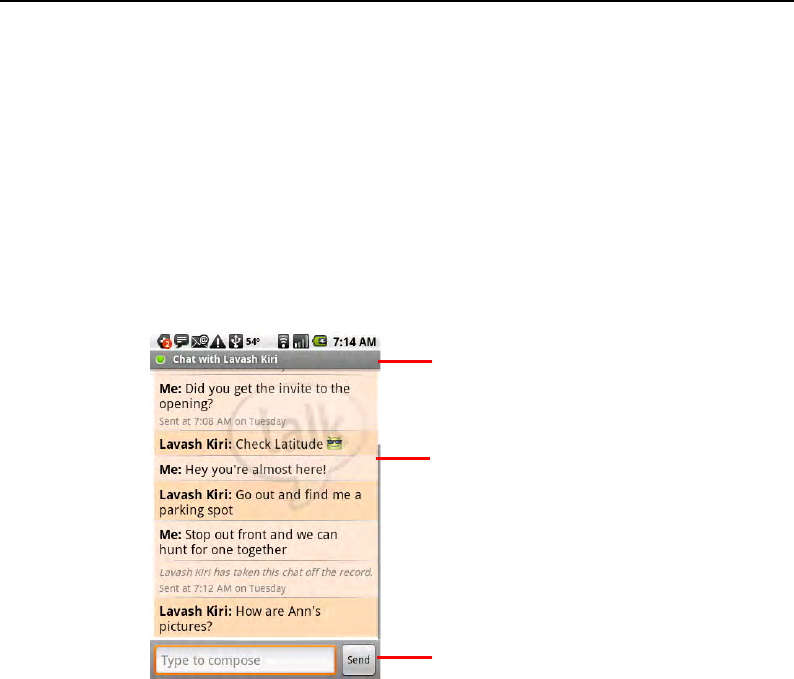
Google Talk 150
AUG-2.0.0-100 Android User’s Guide
Chatting with friends
To chat with a friend
1Touch a friend in your Friends list.
If you’re already chatting with someone, you can press MENU and touch
Friends list to invite another friend to chat.
The chat screen opens.
2Enter your message end touch Send.
The messages you exchange are interleaved on screen with information about
the chat, such as whether it’s on the record, the time a message was sent if
there’s no response after a short while, and so on.
You can enter an emoticon (or “smiley”) on the onscreen keyboard by touching
& holding the smiley key and then touching the emoticon you want. You can also
press MENU and touch More > Insert smiley to open a scrolling list of
emoticons, which you can enter by touching.
Your chat session remains open until you end it.
Friends you’re chatting with are displayed at the top of your Friends list, with the
most recent message displayed in a black-on-white balloon.
To accept an invitation to chat
When a friend opens Google Talk and sends you a message, you receive a
notification and their entry in the Friends list turns white and displays the message.
Who you’re chatting with and their online
status
Messages you exchange are interleaved with
information about the chat, such as whether
it’s on the record
Enter a message and touch Send

Google Talk 151
AUG-2.0.0-100 Android User’s Guide
STouch the friend in your Friends list.
OR
SOpen the Notifications panel and touch the chat notification.
To learn how to respond to notifications, see “Managing notifications” on
page 46.
A chat window opens where you can exchange messages with your friend.
To switch between active chats
You can switch between chats if you have more than one chat going.
SOn the Friends list, touch the name of the person you want to chat with.
OR
SOn a chat screen or the Friends list, press MENU and touch Switch chats
and then touch the friend you want to chat with.
To invite a friend to join a group chat
When you’re chatting, you can invite additional friends to join a group chat.
1On a chat screen, press MENU and touch Add to chat.
2Touch the name of the friend you want to invite.
The friend you invited and the current participants receive an invitation to a
group chat. Each one who accepts the invitation joins the group chat.
In a group chat, everyone can see everyone else’s messages.
Group chats appear at the top of your Friends list, with a group chat icon.
To chat on or off the record
Your Google Talk messages are stored, so you can review them later and even
search for them in the Chats folder in Gmail. But you can go off the record if
you’d rather not store the messages in a chat.
SOn a chat screen, press MENU and touch Chat off record.
If you want to resume saving the messages in the chat, press MENU and touch
Chat on record.
To end a chat
When you’re done chatting, you can end the chat so the friend is no longer at the
top of your Friends list and the chat is not displayed in the switch chats panel.

Google Talk 152
AUG-2.0.0-100 Android User’s Guide
When you end a chat, the text of the chat is not discarded: If you restart the chat,
the conversation is displayed in the new chat window, where you left off.
SIn your Friends list, touch & hold the friend you want to stop chatting with and
in the menu that opens, touch End chat.
OR
SWhile on a chat screen, press MENU and then touch End chat.
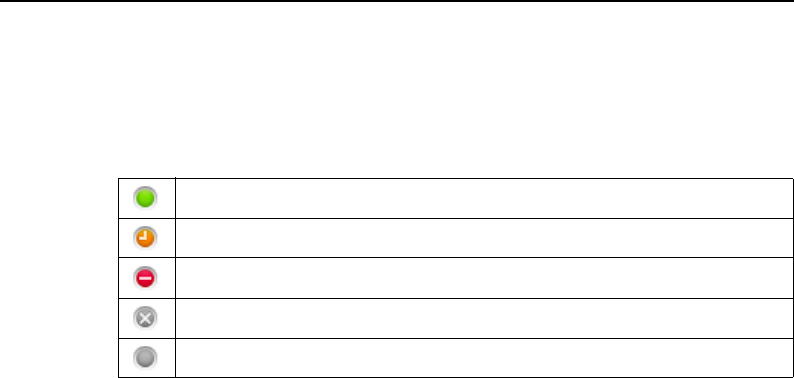
Google Talk 153
AUG-2.0.0-100 Android User’s Guide
Changing and monitoring online status
Icons in Google Talk, Gmail, Google Maps, and other applications indicate your and
your friends’ Google Talk status.
You can change your online status and status message. You can also change the
picture others see next to your name in their Friends lists and other locations.
To change your online status
1Touch the status icon at the top-right of your friends list.
2In the menu that opens, touch a status or a status-message combination.
In addition to the standard Available, Busy, and Invisible status settings, you can
also select a message that you’ve entered previously. Or touch Clear custom
messages erase them and start over.
Your status an any message appear in your friend’s Friends lists and in other
locations where your status or status message are displayed.
To change your status message
1Touch your current status message at the top of your Friends list.
2Enter a new status message.
Available: signed into Google Talk and available to chat
Away: signed into Google Talk but not active in a while
Busy: signed into Google Talk but too busy to chat
Signed out of Google Talk
Invisible: you’re signed into Google Talk but appear signed out to others

Google Talk 154
AUG-2.0.0-100 Android User’s Guide
To change your picture
1Touch your current picture at the top-left of your Friends list.
The Select picture screen opens with all the pictures on your SD card displayed
in a scrolling list of thumbnails.
2Touch the picture you want to use.
3Crop the picture.
Cropping pictures is described in “Working with pictures” on page 218.
4Touch Save.

Google Talk 155
AUG-2.0.0-100 Android User’s Guide
Managing your Friends list
Your Google Talk Friends list contains the friends you’ve invited or accepted
invitations from to become friends in Google Talk. Google Talk friends can invite
each other to chat in Google Talk and see each others’ online status, in Google Talk
and other applications, such as in Gmail and Maps.
The Google Talk Friends list is sorted by your friends’ online status: active chats,
online, busy, and offline. Within each status group, friends are listed alphabetically.
If your keyboard is open, you can type letters to view only friends with matching
names.
To add a friend to your Friends list
You can invite anyone with a Google Account to become your friend in Google
Talk, so you can chat with each other and view each others’ online status.
1In the Friends list, press MENU and touch Add friend.
2Enter your friend’s Gmail address and touch Send invitation.
You may need to press BACK to close the onscreen keyboard to see the Send
invitation button.
To view and accept an invitation to become a friend
When one of your friends invites you to become a friend in Google Talk, you
receive a notification in the status bar and the invitation appears in your Friends list.
1Touch the invitation in the Friends list.
2Touch Accept in the menu that opens.
Or touch Cancel if it’s an invitation from someone who is not a friend you
want to chat with and share your online status on Google Talk.
To view a list of pending invitations to friends
SIn the Friends list, press MENU and touch Invites.
All the friends you’ve extended invitations to become friends on Google Talk
appear in the list, until they accept or cancel your invitation.
To view all friends or only those most popular with you
By default, only the friends that you frequently chat with—the most popular—are
shown in the Friends list. But you can view all your friends instead.

Google Talk 156
AUG-2.0.0-100 Android User’s Guide
SIn the Friends list, press MENU and touch All friends.
Or to switch back to just the friends you’re most popular with, touch Most
popular in the menu.
To pin a friend
You can pin a friend to make sure they always appears in your Most popular friends
list.
1In the Friends list, touch & hold the friend’s name.
If you can’t see the friend, press MENU and touch All friends.
2Touch Pin friend in the menu that opens.
To unpin a friend, touch & hold the friend’s name in the Friends list and in the
menu that opens, touch Unpin friend.
To block a friend
You can block a friend from sending you messages. When blocked, your friend is
also removed from your Friends list.
1In the Friends list, Touch & hold the friend’s name.
If you can’t see the friend, press MENU and touch All friends.
2Touch Block friend in the menu that opens.
You can view a list of your blocked friends by opening your Friends list, pressing
MENU, and touching Blocked. You can unblock a friend by touching the
friends name in the blocked list and then touching OK in the dialog that asks you
to confirm you want to unblock the friend.

Google Talk 157
AUG-2.0.0-100 Android User’s Guide
Changing Google Talk settings
You can configure Google Talk to send you a notification with the contents of each
message you receive in a chat, and to also sound a ringtone or vibrate the phone.
You can also configure Google Talk to sign you in automatically when you turn on
your phone, instead of having to open Google Talk to receive chats and share your
online status, and you can set whether the mobile indicator is displayed next to
your name in other people’s Friends lists.
To configure notifications for new Google Talk messages
1In the Friends list, press MENU and then touch More > Settings.
2Check or uncheck IM notifications to set whether you receive a notification
in the status bar when a new chat arrives.
3Touch Select ringtone to open a list of the ringtones you can choose to
sound when you receive notification of a new chat.
4Check or uncheck Vibrate to set whether the phone vibrates when you
receive notification of a new chat.
To show or hide the mobile indicator to friends
1In the Friends list, press MENU and then touch More > Settings.
2Check or uncheck Mobile indicator.
When Mobile indicator is checked, your friends see an outline of an Android
next to your name in their Friends list, when you’re signed into Google Talk on
the phone.
To set whether you sign into Google Talk automatically
1In the Friends list, press MENU and then touch More > Settings.
2Check or uncheck Automatically sign-in.
When Automatically sign-in is checked, you are signed into Google Talk
when you turn on your phone, without having to open Google Talk.
Signing in and out of Google Talk is described in “Signing in and opening your
Friends list” on page 148.
Your friend is signed into Google Talk
on her phone.

Google Talk 158
AUG-2.0.0-100 Android User’s Guide

159
AUG-2.0.0-100 Android User’s Guide
Email
You use email to read and send email from email accounts other than
Gmail. Email includes a wizard that makes is easy to configure it for
several popular email service providers.
In this section
“Opening Email and reading your messages” on page 160
“Responding to a message” on page 163
“Composing and sending email” on page 164
“Adding and editing email accounts” on page 165
“Changing email account settings” on page 167
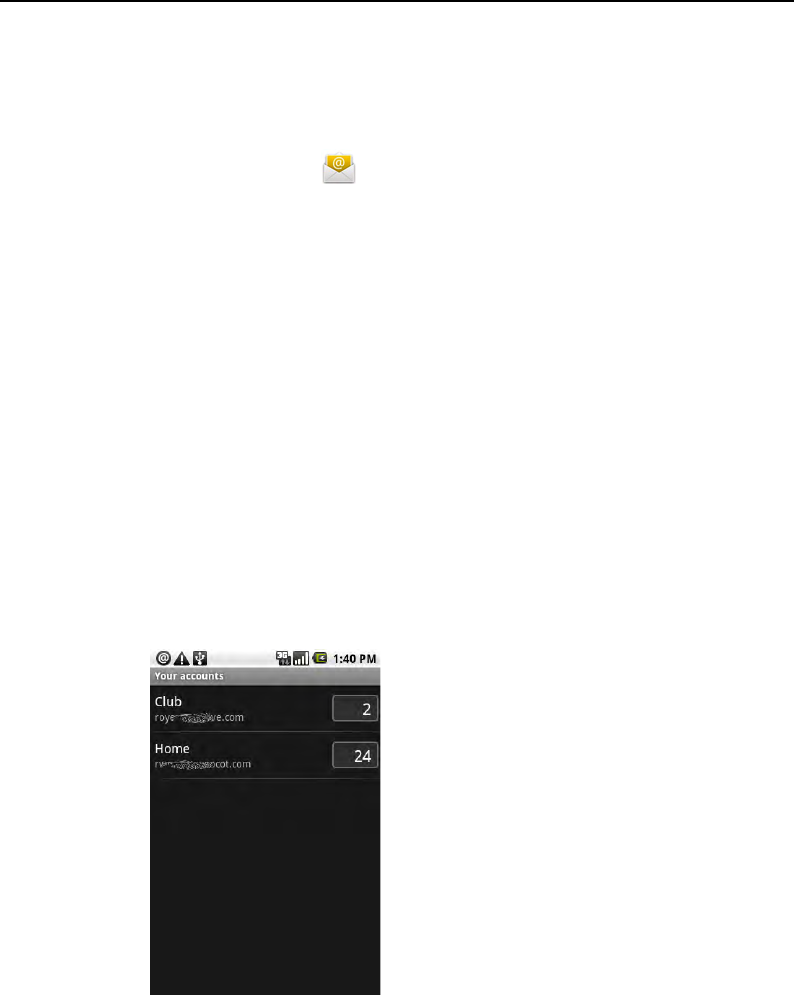
Email 160
AUG-2.0.0-100 Android User’s Guide
Opening Email and reading your messages
To open Email
STouch the Email icon on the Home screen or in the Applications tab.
See “Opening and switching applications” on page 40 to learn more about
opening and switching applications.
The first time you open Email, it offers a setup wizard to help you add an email
account, as described in “Adding and editing email accounts” on page 165.
Subsequently, Email opens to the last screen you were viewing or, if you have not
used Email in a while, it displays the contents of your Inbox in the mailboxes
window (if you have only one account) or the Accounts screen.
To open the Accounts screen
The Accounts screen lists your email accounts and how many unread messages each
has received. It’s also the quickest way to find and open the mailboxes screens for
your accounts.
SWhen viewing a message, press BACK to return to a mailboxes screen.
OR
SFrom a mailboxes screen, press MENU and touch Accounts.
Touch an account to open its
mailboxes screen.
The number of unread messages
in the account.
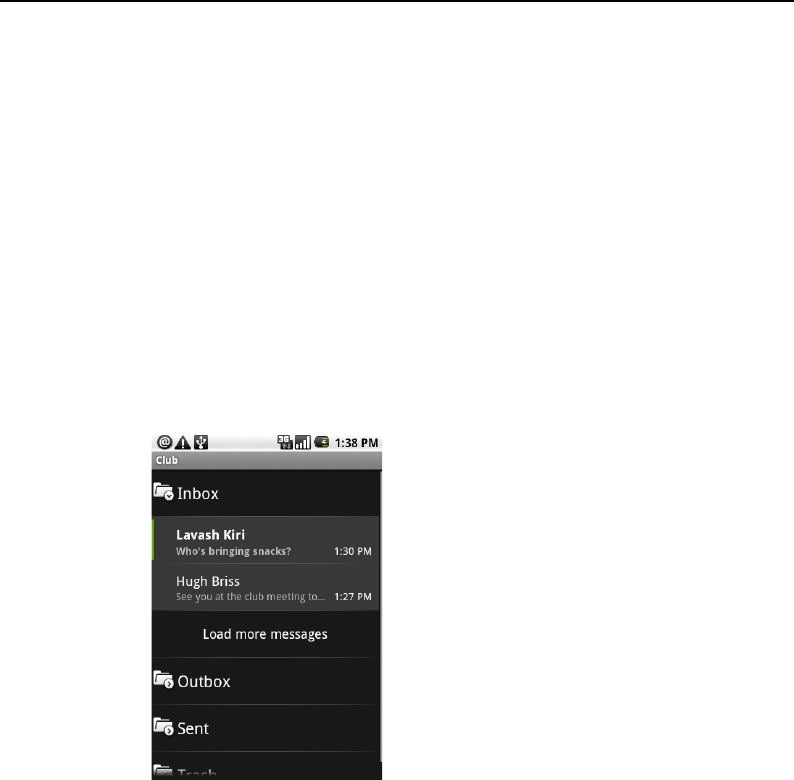
Email 161
AUG-2.0.0-100 Android User’s Guide
To open an account’s mailboxes screen
Each account’s mailboxes screen lists its mailboxes (or folders, depending on your
email service), with your received and sent email.
1Open the Accounts screen.
Each account has a separate set of mailboxes, such as an Inbox, Sent, Trash, and
other mailboxes.
2Touch the name of the account you want to work with.
The mailboxes screen opens with a scrolling list of the mailboxes in the account.
You can touch a mailbox to view a list of the messages it contains, or touch it
again to hide its contents.
Only a some of your account’s more recent email is downloaded to your phone,
but you can touch Load more messages to download earlier messages, in
batches.
The account name
A colored bar marks unread
messages
Touch a message to open it
Touch to load earlier
messages
Touch to view the contents
of a mailbox
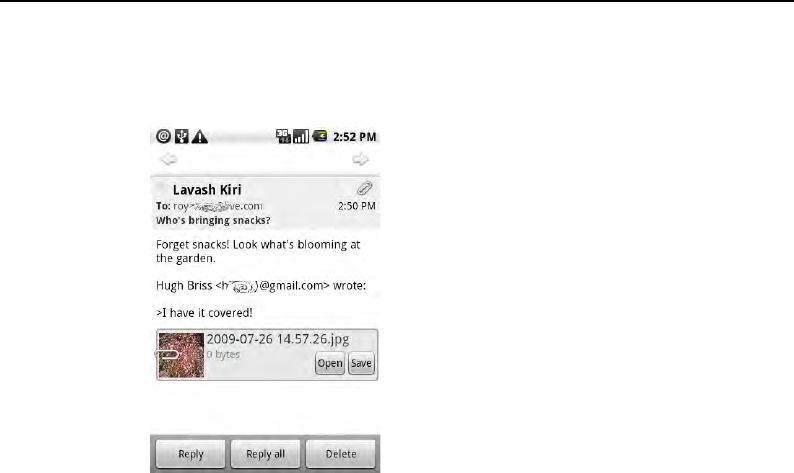
Email 162
AUG-2.0.0-100 Android User’s Guide
To read a message
1Open a mailbox and touch the message you want to read.
You can reply to, forward, delete, or take other actions on a message, as
described in “Responding to a message” on page 163.
2Touch & hold the name of the account you want to delete.
3Touch Delete in the menu.
4Touch OK in the dialog that asks you to confirm you want to delete the account.
All information about the account is deleted, as well as any local copies of email
you received or sent from the account, including unsent drafts.
Touch an arrow to read the next or
previous message in the mailbox
Sender’s Google Talk online status
View or save an attachment
Touch to reply to or delete the
message

Email 163
AUG-2.0.0-100 Android User’s Guide
Responding to a message
You can reply to or forward a message you receive. You can also delete messages
and manage them in other ways.
To reply to or forward a message
SWhen reading a message, touch Reply or Reply all.
OR
SPress MENU and touch Reply, Reply all, or Forward.
A compose message window opens with the addresses (when replying), subject, and
a copy of the message you’re responding to filled in.
You can now address, compose, and send this message as you would a new
message, as described in “Composing and sending email” on page 164.
To mark a message as unread
You can to return a read message to the unread state—for example, to remind
yourself to read it again later.
SWhen reading a message, press MENU and touch Mark as unread.
To delete a message
You can delete a message from its mailbox.
SWhen reading a message, touch Delete.
OR
SPress MENU and touch Delete.
For most kinds of accounts, deleted messages are moved to a Trash mailbox, so you
can retrieve them if you deleted them in error.

Email 164
AUG-2.0.0-100 Android User’s Guide
Composing and sending email
You can send email to your contacts or to other people or groups.
To compose and send a message
1Press MENU and touch Compose.
2Address the message.
As you enter text, matching addresses are offered from your Contacts. You can
touch a suggested address or enter a new one. Separate multiple addresses with
commas.
See “Contacts” on page 87 for more information.
3Press MENU and touch Add Cc/Bcc to address a copy or blind copy of the
message.
4Enter a subject for the message.
5Enter the text of the message.
For more information about entering and editing text, see “Using the onscreen
keyboard” on page 35 and “Editing text” on page 38.
6Press MENU and touch Attach to send a photo with the message.
7Touch Send.
If you’re not ready to send the message, touch Save as draft. (Touch a draft
message in your Drafts mailbox to resume working on it.) Your message is also
saved as a draft if you press Back before sending it.
You can also touch Discard to abandon the message, including any saved drafts.
If you aren’t connected to a network, for example, if you’re working in airplane
mode, the messages you send are stored in your account’s Outbox mailbox,
until you are connected to a network again.

Email 165
AUG-2.0.0-100 Android User’s Guide
Adding and editing email accounts
The first time you open Email, it prompts you to set up an email account.
Subsequently, you can configure Email to send and receive email from additional
email accounts.
The Email setup wizard can help you set up your account for many popular email
systems. If your service provider requires additional settings, or if your service
provider is unknown to Email, you can enter the necessary details manually.
To add an email account
1Open the Accounts screen.
2Press MENU and touch Add account.
In the Setup email screen, enter your email address and password.
If you’re adding a second or subsequent email address, you can also check the
option to use the new account to send all outgoing messages.
3Touch Next. Or touch Manual setup if you need to enter email account
settings the two-step wizard can’t configure for you.
If you touch Next, Email attempts to communicate with your email service
provider to validate your account for sending and receiving mail, using just your
email address and password.
Depending on service provider, it may ask you what kind of email account you
have. If you’re not sure, you can check the settings in the application you use to
send and receive email on your computer, or ask your email service provider.
If the wizard determines that your service provider requires other information
(or if you touched Manual setup), you’re prompted to enter your email
account details. Refer to the settings used by your computer-based email
application or your email service provider’s support resources.
4Enter a name for the account, confirm how you want your name to appear in
outgoing mail, and touch Done.
Email starts downloading your email and you can start using it to send and
receive email using the new account.
To change an account’s settings
You can change a number of settings for an account, including how often you check
for email, how you’re notified of new mail, and details about the servers it uses to
send and receive mail.

Email 166
AUG-2.0.0-100 Android User’s Guide
1In your account’s mailboxes screen, press MENU and touch Account
settings. Or press & hold an account’s name in the Accounts screen and in the
menu that opens, touch Account settings.
2Touch the name of the account you want to modify.
3Press MENU and touch Account settings.
For a descriptions of the settings you can change, see “Changing email account
settings” on page 167.
4When you’re done changing settings, press BACK.
To delete an email account
1Open the Accounts screen.
On some Email screens, you can press MENU and touch Accounts. On other
screens, you must press BACK until you return to a screen with Accounts in
its menu (or simply return to the Accounts screen).
2Touch & hold the account you want to delete.
3Touch Remove account in the menu that opens.
4Touch OK in the dialog that asks you to confirm that you want to delete the
account.

Email 167
AUG-2.0.0-100 Android User’s Guide
Changing email account settings
You can change the following settings for each email account, during or after when
you create the account. Creating an account and changing its settings are described
in “Adding and editing email accounts” on page 165.
Account name The name of the account as it appears in the Accounts and
mailboxes screens.
Yo u r n a m e Your name as it appears to others when they receive email from
you.
Email check frequency How often Email checks for new email sent to this
account.
Default account Use the this account’s outgoing email server for the email
you compose and send.
Email notifications Set whether you want to receive notifications when you
receive new email sent to this account.
Select ringtone Pick a ringtone to sound when you receive an email
notification for this account.
Vibrate Vibrate the phone when you receive an email notification for this
account.
Incoming settings Detailed settings for how you receive email for this
account. Refer to the settings used by your computer-based email application or
your email service provider’s support resources for details about these settings.
Outgoing settings Detailed settings for how you send email for this account.
Refer to the settings used by your computer-based email application or your email
service provider’s support resources for details about these settings.
Sync contacts For accounts that can sync contacts, check to sync contacts
from this account to your phone. See “Configuring account sync and display
options” on page 110 for more information.

Email 168
AUG-2.0.0-100 Android User’s Guide
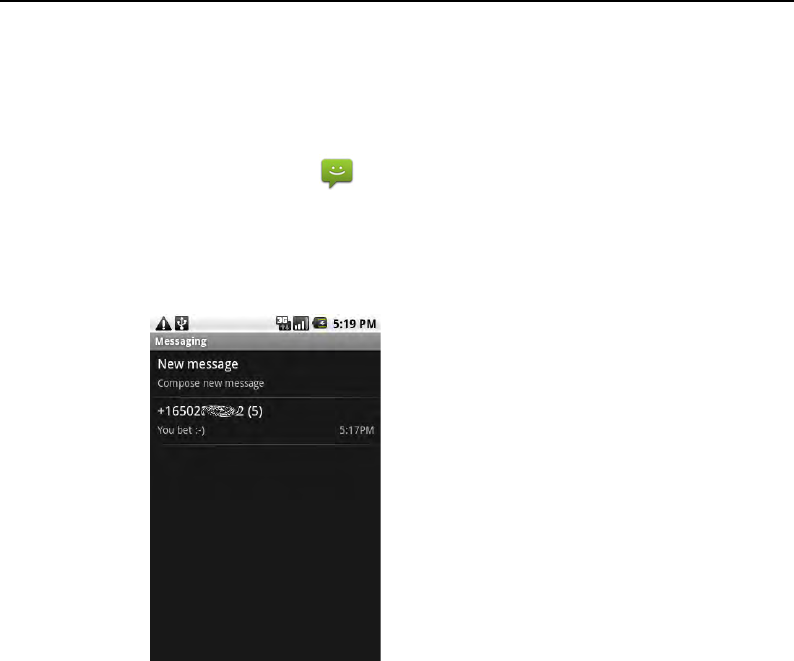
Messaging 170
AUG-2.0.0-100 Android User’s Guide
Opening Messaging
To open Messaging
STouch the Messaging icon on the Home screen or in the Applications tab.
See “Opening and switching applications” on page 40 to learn more about
opening and switching applications.
The Messaging window opens, where you can create a new message or open an
ongoing message thread.
STouch New message to start a new text or multimedia message.
STouch an existing message thread to open it.
Creating and responding to messages is described in “Exchanging messages” on
page 171.
To delete a message thread from the Messaging window
1Touch & hold the message thread.
2Touch Delete thread in the menu that opens.
You can also press MENU and touch Delete threads to delete all message
threads from the window.
Touch to send a new text of
multimedia message.
Touch to open an ongoing message
thread.

Messaging 171
AUG-2.0.0-100 Android User’s Guide
Exchanging messages
You can send text (SMS) messages of up to 160 characters to another mobile
phone. If you continue to type after the limit is reached, your message will be
delivered as a series of messages.
Multimedia (MMS) messages can contain text and a picture, a recorded voice, an
audio file, or a picture slideshow.
Messaging automatically converts a text message into a multimedia message if you
send it to an email address instead of a phone number, add a subject, or attach a
media file.
To send a text message
1On the Messaging screen, touch New message.
2Enter a mobile phone number in the To field.
As you enter the phone number, matching Contacts appear. You can touch a
recipient or continue entering a phone number.
3Touch the composition text box to start entering your message.
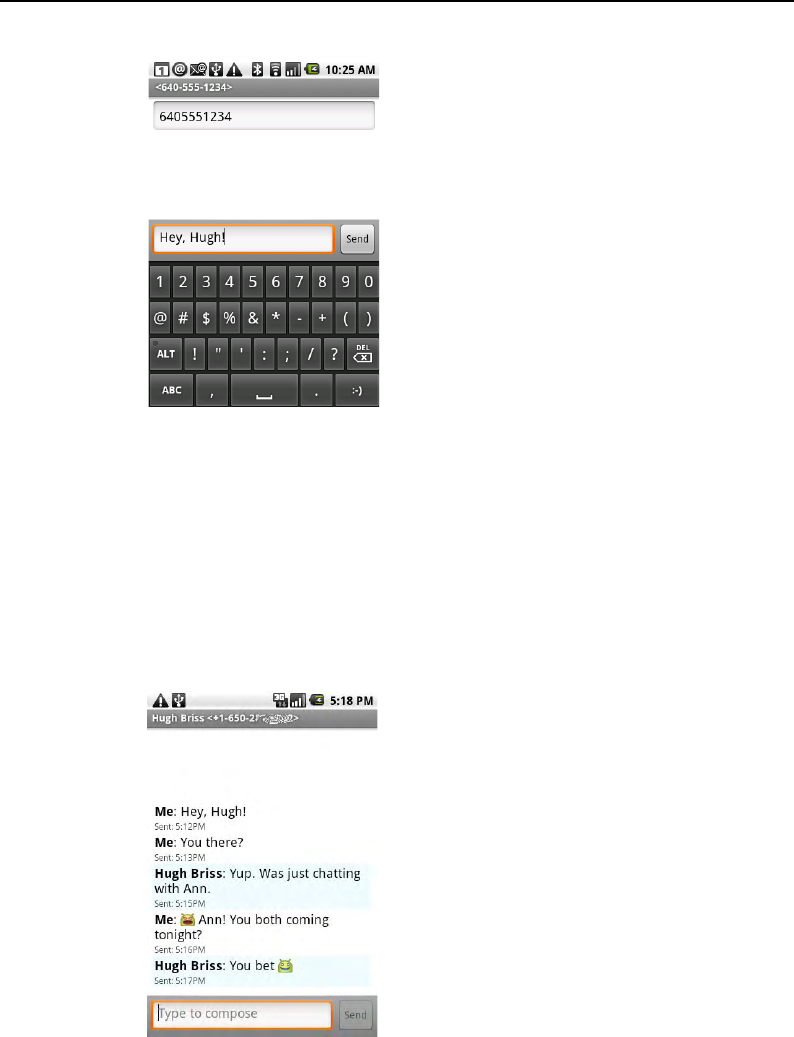
Messaging 172
AUG-2.0.0-100 Android User’s Guide
As you near the 160-character limit, a counter appears in the top right corner of
the text box to tell you how many characters are left. If you go over that limit, a
new message is created, which is joined with its predecessors when received.
If you press BACK while composing a message, it’s saved as a draft in your
Messaging window, where you can touch it to resume composing it.
4Touch Send.
The message window opens, with your message after your name. Responses
appear in the window. You view and send additional messages, creating a
message thread.
Enter a phone number.
Enter the message and touch Send.

Messaging 173
AUG-2.0.0-100 Android User’s Guide
To create and send a multimedia message
1On the Messaging screen, touch New message.
2Enter a mobile phone number or email address in the To field.
As you type, matching contacts appear. You can touch a contact or continue
typing.
3Touch the composition text box to start entering your message.
4Press MENU and touch Add subject to add a message subject.
5Press MENU and touch Attach to open a menu where you can touch the kind
of media file you want to attache to the message.
If you touch Pictures, you’re prompted to touch a picture to attach it.
If you touch Capture picture, Camera opens so you can take a picture and
attach it.
If you touch Videos, you’re prompted to touch a video to attach it.
If you touch Capture video, Camcorder opens so you can shoot a video and
attach it.
If you touch Audio, you’re prompted to touch a ringtone to attach it.
If you touch Record audio, a screen opens where you can record a spoken
message and attach it.
If you touch Slideshow, a screen opens where you can assemble photos into a
slideshow of up to ten slides, to attach to the message.
You can use the buttons in the compose message screen to preview or remove
the media attachment.
6Touch Send.
To respond to messages you receive
If you’re working in a message window, the messages you receive are displayed in it.
Otherwise, you receive a new message notification and a new message icon appears
in the status bar (see “Managing notifications” on page 46).
When you touch the new message notification, the message window opens, where
you can reply to the message, as you would in a thread you started.
If you have the Auto-retrieve setting unchecked, you must touch Download to
view the text and any media files attached to the message (see “Changing Messaging
settings” on page 175).

Messaging 174
AUG-2.0.0-100 Android User’s Guide
If the message contains a media file, touch Play to view, watch, or listen to it.
Touch & hold the media file to open a menu with an option for saving the message
on your SD card.
To view details about a message
1Touch & hold a message in a message window.
2Touch View message details in the menu that opens.

Messaging 175
AUG-2.0.0-100 Android User’s Guide
Changing Messaging settings
You can change a number of Messaging settings.
STo change Messaging settings, open a the Messaging window, press MENU, and
touch Settings.
Storage settings
Delete old messages Check to delete older messages in a thread when the
Text message limit or Multimedia message limit is reached. Uncheck to
keep all messages.
Text message limit Touch to set the number of messages to save per thread
of text messages. When the limit is reached, older messages are deleted if Delete
old messages is checked.
Multimedia message limit Touch to set the number of messages to save
per thread of multimedia messages. When the limit is reached, older messages are
deleted if Delete old messages is checked.
Text message (SMS) settings
Delivery reports Check to receive delivery reports for the messages you
send.
Manage SIM card messages Touch to open a window where you can work
with messages store on your SIM card, for example, if you used the SIM card in
another kind of phone where you exchanged text messages.<<not for CDMA>>
Multimedia message (MMS) settings
Delivery reports Check to receive a report on the messages you send.
Read reports Check to receive reports when your messages are read or
deleted.
Auto-retrieve Uncheck to download only the heading of multimedia messages,
which you can then touch to open a menu to download the whole message. This is
useful for controlling how much data you download, for example, when connected
to a slow data network.

Messaging 176
AUG-2.0.0-100 Android User’s Guide
Roaming auto-retrieve Uncheck to download only the header of multimedia
messages when connected to other carrier’s data networks. This is useful for avoid
unexpected charges, if you chose a contract that has limits on data roaming.
Notification settings
Notifications Check to receive a notification whenever you receive a new
message. See “Managing notifications” on page 46.
Select ringtone Opens a dialog where you can select the ringtone to sound
when you receive new message notifications.
Vibrate Check to vibrate the phone when you receive a new message
notification.

177
AUG-2.0.0-100 Android User’s Guide
Browser
You use Browser to view webpages and to search for information on
the web.
In this section
“Opening Browser” on page 178
“Navigating within a webpage” on page 181
“Navigating among webpages” on page 183
“Working with multiple Browser windows” on page 185
“Downloading files” on page 187
“Working with bookmarks” on page 188
“Changing Browser settings” on page 190
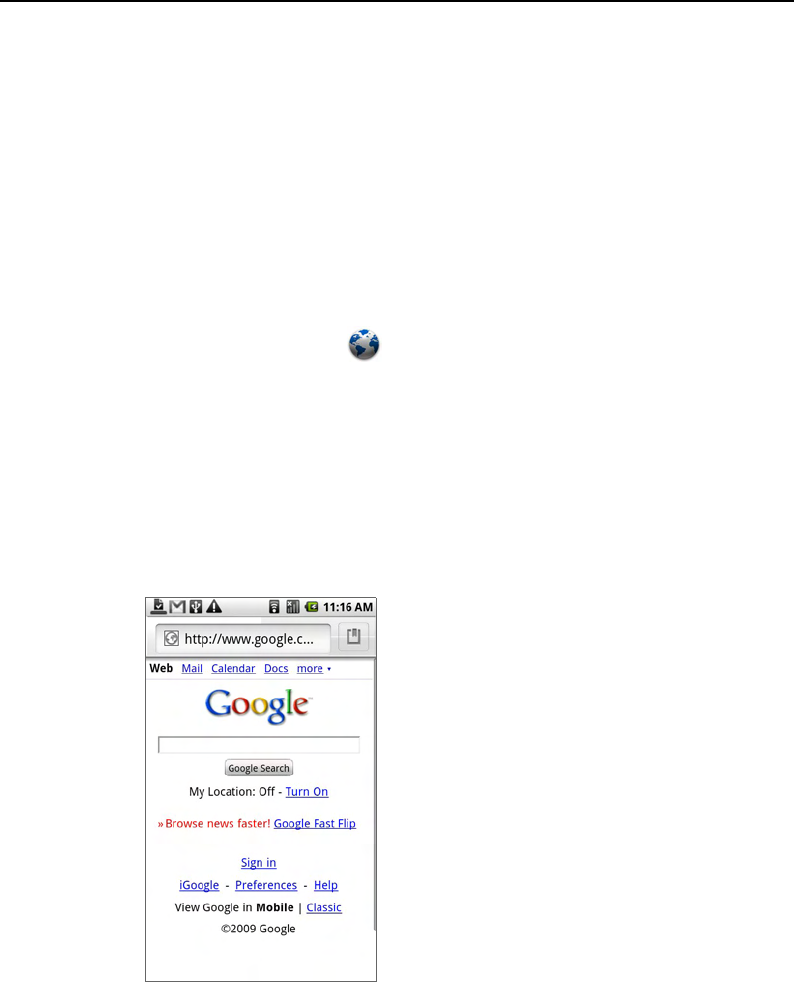
Browser 178
AUG-2.0.0-100 Android User’s Guide
Opening Browser
Open Browser to start surfing the web.
Some web sites have two versions: full-size for computer-based web browsers and
another for mobile devices. They may also allow you to switch back and forth. Full-
size sites are typically harder to navigate on a mobile browser than sites designed
for use on handheld devices. Mobile sites may also scroll the URL bar off the top of
the screen, but you can just drag the page down to see it again.
To open Browser
STouch the Browser icon on the Home screen or in the Applications tab.
See “Opening and switching applications” on page 40 to learn more about
opening and switching applications.
Browser also opens when you touch a web link, for example, in an email or text
message.
When you open Browser, it displays the last webpage your were viewing, or if
you have not used Browser in a while, it opens your home page.
The URL of the current page is displayed at the top of the window (unless a
mobile site deliberately scrolls it off the top of the screen).
The address (URL) of the
current page.
Some sites scroll the URL bar
off the top of the screen, but
you can drag the page down
or press MENU to see it
again.
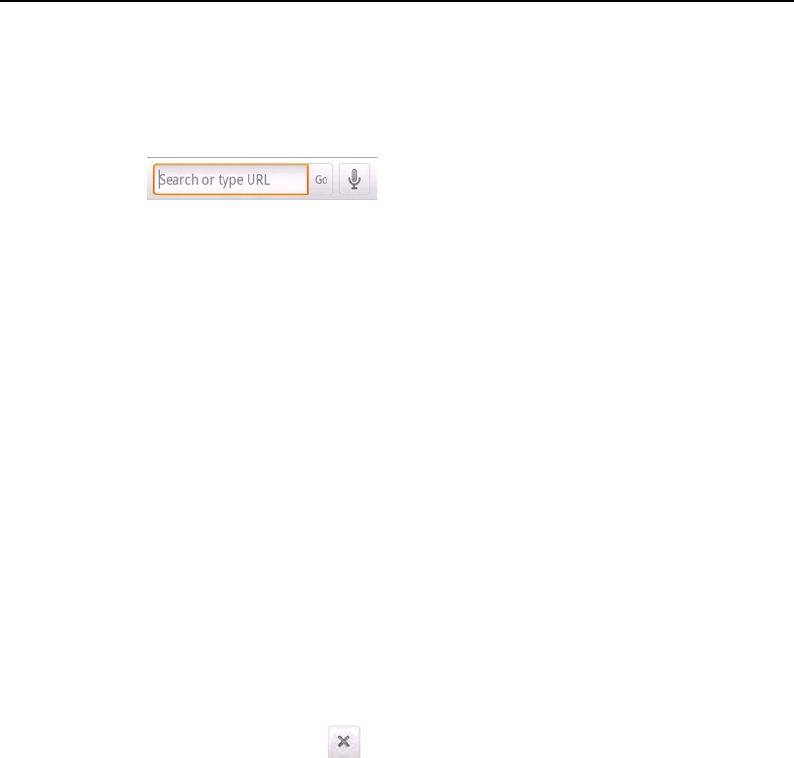
Browser 179
AUG-2.0.0-100 Android User’s Guide
To g o t o a w e b p a g e
1Touch the URL box at the top of the Browser screen.
The box is highlighted and a Go button appears to its right.
2Enter the address (URL) of the webpage.
As you enter the address, your web search engine makes suggestions of
webpages and queries in a list (to learn more about searching, see “Searching
your phone and the web” on page 48).
Or touch the microphone to search by voice.
3Touch a suggestion or enter an address and touch Go.
If you touch a suggested page or enter an address and touch Go, that webpage
opens.
If you touch a suggested query, your web search engine opens with the results.
To refresh the current page
SPress MENU and touch Refresh.
The webpage is reloaded, updating any content that has changed.
To stop opening a page
If a web page is taking a long time to display, or if you simply change your mind,
you can stop a page from opening.
STouch the cancel icon to the right of the URL.
OR
SPress MENU and touch Stop.
To get more information about the current page
SPress MENU and touch More > Page info.
A dialog opens with the page’s title and full address (URL).
To set your home page
Your home page opens when you open a new Browser window, and when you start
Browser after restarting your phone or after not using it for a while.

Browser 180
AUG-2.0.0-100 Android User’s Guide
1On a Browser screen, press MENU and touch More > Settings > Set home
page.
2Enter the address (URL) of the page and touch OK
You may find is more convenient to copy the URL from the page you want and
then paste it in the dialog (see “Editing text” on page 38).
Leave the field blank if you prefer to open new Browser windows without
opening a webpage by default. This can make new Browser windows open more
quickly.

Browser 181
AUG-2.0.0-100 Android User’s Guide
Navigating within a webpage
Webpages that are optimized for mobile devices typically open at a size appropriate
for your phone. Often, you can’t zoom or even scroll their contents.
Web pages that aren’t designed specifically for mobile devices typically open in
overview mode: the page is zoomed out so you can get the big picture (you use
settings to change how pages open, as described in “Changing Browser settings” on
page 190).
To scroll a webpage
SSlide your finger on the screen.
OR
SRoll the TRACKBALL in any direction.
Rolling the TRACKBALL selects items on the page in the direction you roll,
scrolling selected items into view if necessary. Pressing the TRACKBALL has
the same effect as touching the selected item (opening a link, selecting a text
field, and so on).
The TRACKBALL is particularly useful for selecting items that are close
together, such as text fields and other controls in forms, or closely adjacent links
on a webpage.
To zoom in or out on a webpage
You may not be able to zoom in or out on webpages designed for mobile devices.
1Slide your finger slightly on the screen to reveal the zoom controls.
2Touch the plus or minus side of the zoom control to zoom in or
out.
To quickly zoom into a section of a webpage
You may not be able to zoom in or out on webpages designed for mobile devices.
SDouble-tap on the section of the webpage you want to view.
The webpage zooms in and wraps the text in that section to fit the width of the
screen, so you can more comfortably read all the text in that section by scrolling
up and down.
If you adjust your zoom level in this view, Browser remembers your preference
while you stay on that page.
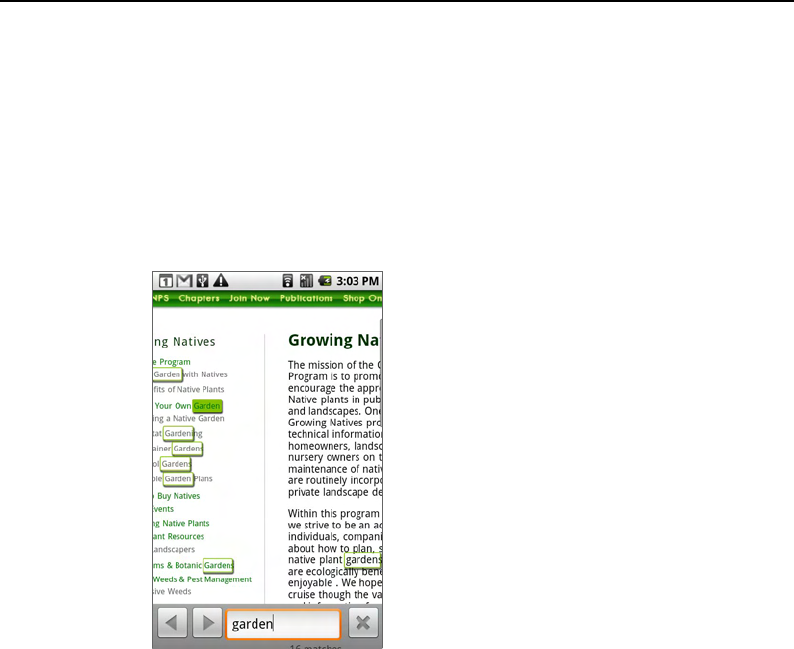
Browser 182
AUG-2.0.0-100 Android User’s Guide
SWhen you want to return to page overview, double-tap again.
To find text on a webpage
1Press MENU and then touch More > Find on page.
2Enter the text you’re looking for.
As you type, the first word with matching characters is highlighted on the
screen, and subsequent matches are boxed.
3Touch the left or right arrow to scroll to and highlight the previous or next
matching word.
The first matching word is highlighted
Subsequent matches are boxed
Touch to go to the previous or next
matching word

Browser 183
AUG-2.0.0-100 Android User’s Guide
Navigating among webpages
You can open links on a webpage, navigate back and forward, and review your
browsing history, just as in any web browser. You can also take advantage of some
shortcuts for working with links and other kinds of information.
To open a link
STouch a link to open it.
Links you touch are highlighted in orange briefly, until the webpage they refer to
opens in the window.
The TRACKBALL is useful for selecting links that are close together on the
screen. Press the TRACKBALL to open a selected link.
To go back and forward among the pages you’ve opened
SPress the BACK button.
OR
SPress MENU and touch Forward.
To view your Browser history
As you browse the web, Browser keeps track of the pages you visit, to help you find
your way back later. (“Changing Browser settings” on page 190 describes the setting
that clears your history.)
1Touch the bookmarks icon at the top-right of the screen.
Working with bookmarks is described in “Working with bookmarks” on
page 188.
2Touch the History tab.
The pages you’ve visited are grouped chronologically: today, yesterday, and so
on. Bookmarked pages have a gold star.
3Touch a time period to view the pages you visited.
4Touch a page in the history to reopen it.

Browser 184
AUG-2.0.0-100 Android User’s Guide
To view your most frequently visited pages
1Touch the bookmarks icon at the top-right of the screen.
Working with bookmarks is described in “Working with bookmarks” on
page 188.
2Touch the Most visited tab.
The pages you’ve visited most frequently are listed in order. Bookmarked pages
have a gold star.
You can press MENU and touch List view to view the pages in a list.
3Touch a page to reopen it.
To follow shortcuts for links, phone numbers, and addresses
Browser can recognize links as well as some phone numbers, addresses, and
similar information, as information you may wish to act on directly, rather than
(for example) copying and pasting into another application (as described in
“Editing text” on page 38).
STouch & hold a link to open a menu with shortcuts for opening, bookmarking,
saving, and sending the link via email.
STouch a phone number to open the Phone application with the number entered.
For more information, see “Placing and ending calls” on page 72
STouch a street address to open it in Maps.
For more information, see “Maps” on page 193.
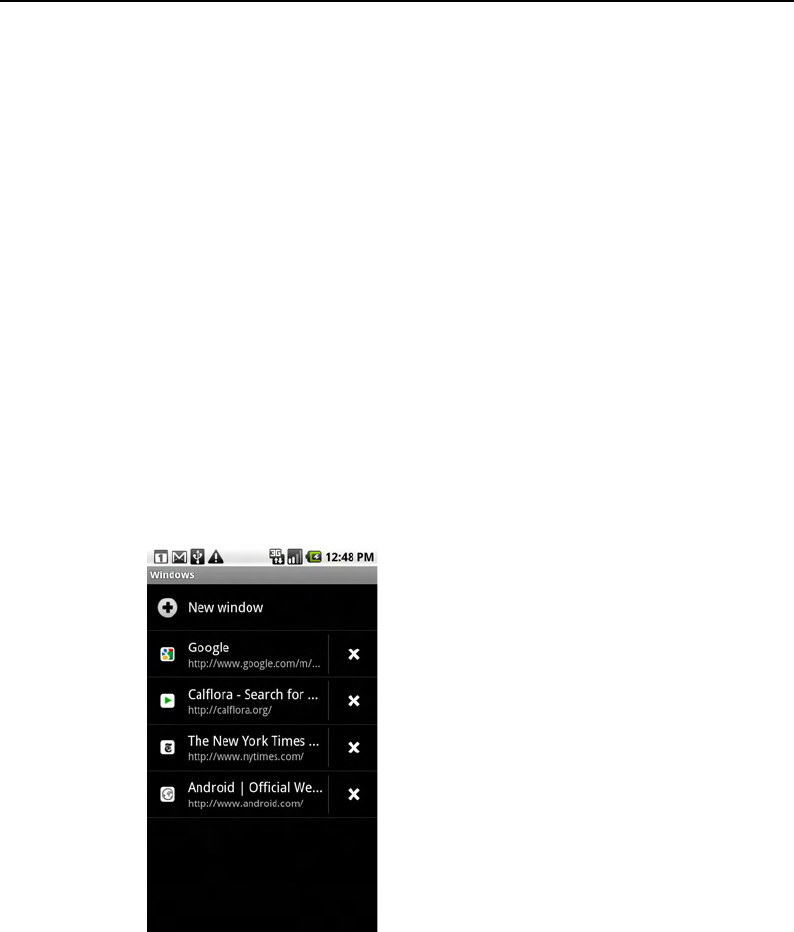
Browser 185
AUG-2.0.0-100 Android User’s Guide
Working with multiple Browser windows
You can open up to eight browser windows at once and switch among them.
To open a new Browser windows
SPress MENU and touch New Window.
OR
SPress MENU and touch Windows and in the screen that opens, touch New
window.
New windows open with your home page. You can set whether they open in
front or in back of existing windows (see “Changing Browser settings” on
page 190).
To switch Browser windows
1Press MENU and touch Windows.
Your open windows are displayed.
2Touch the window you want to open.
Touch to open a new window.
Touch a thumbnail to open its
window.
Touch to close a window.

Browser 186
AUG-2.0.0-100 Android User’s Guide
To close a Browser window
1Press MENU and touch Windows.
Each open window is displayed in a scrolling list of thumbnails.
2Touch the close box on the window you want to close.

Browser 187
AUG-2.0.0-100 Android User’s Guide
Downloading files
You can download files, webpages, and even applications from webpages. The files
you download are stored on your SD card (see “Connecting to a computer via
USB” on page 66 to learn more about SD cards).
To allow installing applications from the web or email
By default, your phone is configured to prevent you from installing applications you
download from the web or receive in email.
Warning! Applications downloaded from the web can be from unknown sources. To protect
your phone and personal data, download applications only from trusted sources,
such as Android Market.
1Press HOME, then press MENU and touch Settings > Applications.
2Check Unknown sources.
3Touch OK in the confirmation dialog.
To download a file
Different webpages offer different mechanisms for downloading pictures,
documents, applications, and other files.
STouch & hold an image or a link to a file or to another webpage and in the
menus that opens, touch Save.
If the file is in a format supported by an application on the phone, it is downloaded
to your SD card.
To cancel a download
If you change your mind about downloading a file, or start downloading one by
accident, you can cancel the download in progress.
1Press MENU and touch More > Downloads.
2Press MENU again and touch Cancel all downloads.
To view the files you’ve downloaded
SPress MENU and touch More > Downloads.
The files you’ve downloaded are listed in order. You can touch one to open it.
You can clear the list by pressing MENU and touching Clear list.

Browser 188
AUG-2.0.0-100 Android User’s Guide
Working with bookmarks
You can bookmark any number of webpages so you can quickly go to them later.
To bookmark a webpage
1Open the webpage you want to bookmark.
2Touch the bookmark icon at the top of the screen.
Or press MENU and touch Bookmarks.
3Touch Add at the top of the Bookmarks screen.
4Edit the name and the address if needed and touch OK.
The bookmark is added to the top of the your list of bookmarks.
To open a bookmark
1Touch the bookmark icon at the top of the screen.
Or press MENU and touch Bookmarks.
A window opens with a list of your bookmarks. Bookmarks are displayed in
thumbnail view by default, but you can press MENU and touch List view.
2Touch the bookmark you want to open.
The bookmark opens in the current window. If you prefer to open the
bookmark in a new window, touch & hold the bookmark and touch Open in
new window in the menu.
To edit a bookmark
1Touch the bookmark icon at the top of the screen.
Or press MENU and touch Bookmarks.
2Touch & hold the bookmark you want to edit.
3Touch Edit bookmark in the menu
4Edit the name or address in the dialog.
5Touch OK.

Browser 189
AUG-2.0.0-100 Android User’s Guide
To share a bookmark
1Touch the bookmark icon at the top of the screen.
Or press MENU and touch Bookmarks.
2Touch & hold the bookmark you want to share.
3Touch Share link in the menu
4Touch the application you want to use to send the bookmark.
The application opens with the bookmark’s address as the subject. For more
information about addressing and sending the message, see the section about
using the application you chose.
To add a bookmark shortcut to the Home screen
You can add a shortcut to your phone’s Home screen that when you touch it, opens
one of your bookmarks in a Browser window.
1Touch & hold an empty spot on your phone’s Home screen.
2Touch Shortcut.
3Touch Bookmark.
4Touch the bookmark you want to add.
The bookmark icon is added to the Home screen.
To delete a bookmark
1Touch the bookmark icon at the top of the screen.
Or press MENU and touch Bookmarks.
2Touch & hold the bookmark you want to delete.
3Touch Delete bookmark in the menu
4Touch OK in the confirmation dialog.

Browser 190
AUG-2.0.0-100 Android User’s Guide
Changing Browser settings
You can configure a number of Browser settings, including several you can use to
manage your privacy.
STo open the Browser settings screen, press MENU and touch More >
Settings.
Page content settings
Te x t s i ze Opens a dialog where you increase or decrease the size of text
Browser uses when displaying webpages.
Default zoom Opens a dialog where you can increase or decrease the
magnification level Browser uses when first opening a webpage.
Open pages in overview Uncheck to open webpages displaying their top-
right corners at 100% size. Check to open webpages zoomed out, in an overview.
Te x t e n c o d i n g Opens a dialog where you can change the character-encoding
standard Browser uses when displaying text on a webpage.
Block pop-up windows Check to prevent websites from opening windows
without your requesting it.
Load images Uncheck to omit images when Browser displays a webpage. This
speeds webpage display, which can be useful when you have a slow connection, but
many websites make little sense with text alone.
Auto-fit pages Check to have Browser optimize the presentation text and
other elements of webpages to fit your phone’s screen. Uncheck to view pages as
designed for a computer screen.
Landscape-only display Check to display pages on in the wider, landscape
orientation on your screen, regardless of how you are holding the phone.
Enable JavaScript Uncheck to prevent JavaScript from running on webpages.
Many webpages only function correctly if you allow them to run JavaScript features
on your phone.
Enable plug-ins Uncheck to disable plug-ins from webpages.
Open in background Check to open new windows in the background when
you touch & hold a link and touch Open in new window. This is useful when

Browser 191
AUG-2.0.0-100 Android User’s Guide
working with windows that take a long time to download and display. You can press
MENU, touch Windows, and then touch the new window to view it. Uncheck if
you prefer new windows you open in this way, to open in place of the current
window. (See “To switch Browser windows” on page 185.)
Set home page Opens a dialog where you can enter the URL of a page you
want to open whenever you open a new Browser window. If you prefer to open
new Browser windows more quickly, by not opening any page by default, you can
leave the dialog blank.
Privacy settings
Clear cache The browser stores the text and images of the webpages you visit
so they open more quickly when you revisit them. You can touch Clear cache to
delete these temporary files.
Clear history The browser keeps track of the webpages you visit, so you can
quickly find them and open them again later (see “To view your Browser history”
on page 183). Touch Clear history to delete this record.
Accept cookies Many webpages store, read, and update files called cookies on
your phone, for your convenience. For example, cookies can make it so you don’t
have to log in each time you open a page, they can remember your preferences, and
so on. Uncheck to prevent webpages from storing cookies on your phone.
Clear all cookie data Touch to delete all cookies from your phone.
Remember form data Browser can remember what you enter in forms
(your name, address, other information you enter frequently), and automatically
enter that text in subsequent forms. This can greatly speed up filling out forms for
fields you enter frequently. Uncheck to disable this feature.
Clear form data Touch to delete all the information the Browser remembers
about what you’ve entered in forms.
Enable location Check to permit websites with location-specific content to
ask you if you want to share your location, using your phone’s location information.
To provide a website with your location, you must also have location sharing
enabled in the Settings application (see “Privacy settings” on page 269).
Clear location access Opens a dialog where you can clear the permissions
you’ve granted to websites in the past, to access your location. If those websites
want permission to access your location again, you must grant it again.

Browser 192
AUG-2.0.0-100 Android User’s Guide
Security settings
Remember passwords Browser can remember your passwords for some
webpages that require you to log in, to make it quicker to log into those pages on
repeat visits. Uncheck to prevent Browser from storing passwords.
Clear passwords Touch to delete any passwords Browser may have stored.
Show security warnings Uncheck to prevent Browser from warning you
about websites with common security problems, such as outdated or invalid
certificates.
Advanced settings
Website settings Opens a screen where you can view advanced settings for
particular websites.
Reset to default Touch to delete all Browser data, including your browsing
history, cookies, passwords, bookmarks, and restore all the Browser settings to
their original values.

193
AUG-2.0.0-100 Android User’s Guide
Maps
Use maps to find your current location, to view real-time traffic
conditions, get detailed directions by foot, public transportation, or
car.
You can search on a map to locate places of interest or an address, on
a street map or a satellite image. You can view a some locations as if
you were strolling down that street.
If you join Google Latitude, you can view your friends’ locations on
your maps and share your location and other information with them
in other ways.
Maps does not have information about every location.
In this section
“Opening Maps and viewing your location” on page 194
“Changing map layers” on page 197
“Searching for locations and places” on page 200
“Getting directions” on page 201
“Finding your friends with Google Latitude” on page 202

Maps 194
AUG-2.0.0-100 Android User’s Guide
Opening Maps and viewing your location
Open Maps to view your location. But first turn on location services to use
information about your location when navigating and searching in Maps.
To use location services with Maps
You must have location services turned on to view your location in Maps and to use
your location to find local resources.
1Press HOME, press MENU, and touch Settings > Location & security.
2Check the My Location options you want to use.
Check Use wireless networks to allow the phone to determine your
approximate location using Wi-Fi and mobile networks.
Check Use GPS satellites to allow your phone to determine your location to
street-level accuracy (GPS works best when you have a clear view of the sky).
3Press HOME, press MENU, and touch Settings > Privacy.
Check Share with Google to use your location when you search.
To open Maps and find your location
1Touch the Maps icon on the Home screen or in the Applications tab.
See “Opening and switching applications” on page 40 to learn more about
opening and switching applications.
2Press MENU and touch My location.
The map centers on a blue dot that indicates your location. A blue circle around
the dot indicates that your actual location is within the circle.
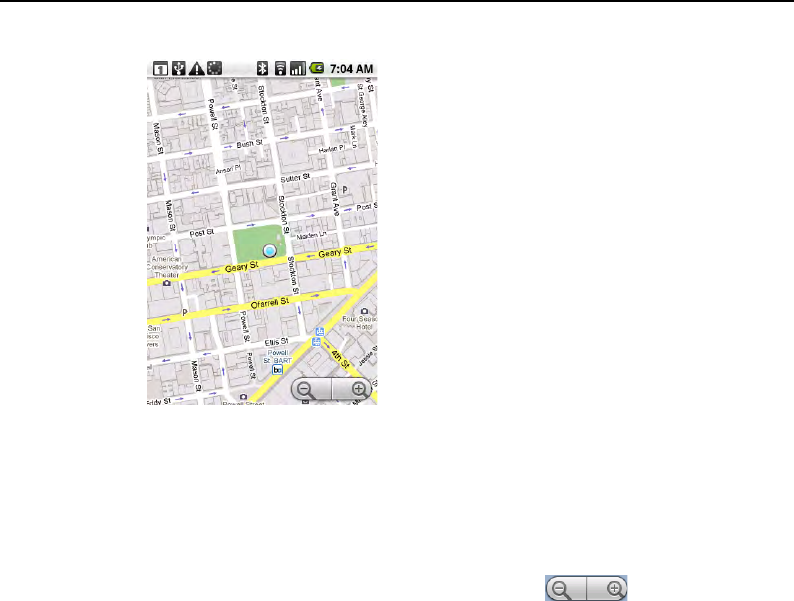
Maps 195
AUG-2.0.0-100 Android User’s Guide
To move the map
SDrag the map with your finger.
To zoom in and out of a map
STouch the plus or minus side of zoom controller .
OR
SDouble-tap a location on the map to zoom into that location.
Not all magnification levels are available for all locations.
To get an address and additional information for a location
STouch & hold a location on the map.
A balloon opens over the location, with the address and a thumbnail from street
view (if available).
Drag the map to move in any
direction
Your location
Zoom in and out
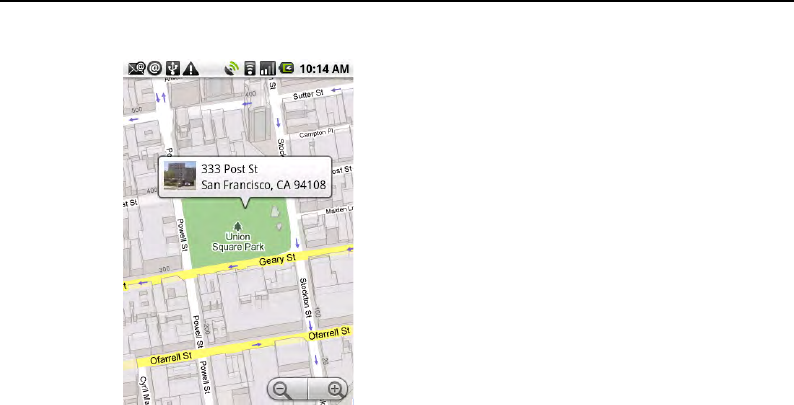
Maps 196
AUG-2.0.0-100 Android User’s Guide
Touch the balloon to open a screen with tools for learning more about the location
(these tools are described in this section and on the http://maps.google.com web
site).
To clear the map
After you get directions or search on a map (as described in the other parts of this
section), you can clear away the various markers such activities draw on the map.
SWhen viewing a map, press MENU and touch More > Clear map.
Touch & hold a location to
open a balloon with its address.
Touch the balloon to open a
screen with tools for learning
more about the location.

Maps 197
AUG-2.0.0-100 Android User’s Guide
Changing map layers
Initially, Google Maps opens with a street map. But you can also view a satellite
image of a location, check on traffic, and even look at a location as if you were
sanding on the street. You can also view maps you’ve created in Google Maps on the
web. These and many other layers are available in Google Maps.
To view map, satellite, or traffic layers
SPress MENU, touch Layers, and touch Traffic, Satellite, Latitude, or
another layer.
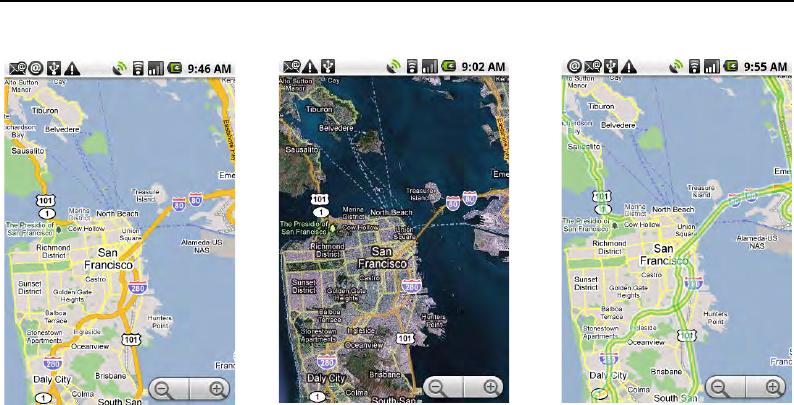
Maps 198
AUG-2.0.0-100 Android User’s Guide
Map mode is the default view. It displays a street map complete with names of
streets, rivers, lakes, mountains, parks, boundaries, and other features.
Satellite mode uses the same satellite data as Google Earth. Satellite images are
not real-time. Google Earth acquires the best imagery available, most of which is
approximately one to three years old.
Traffic mode offers real-time traffic conditions, displayed over roads as color-
coded lines, from green through black.
For more information on Latitude, see “Finding your friends with Google
Latitude” on page 202.
For more information on the other features of Google Maps, visit Google Maps
on the web.
Not all locations have information to support all map modes or all zoom levels.
Visit Google Maps on the web to learn more about map modes.
To open Street View for a location
Street View offers street-level images of a location, which you can navigate, zoom
into, and so on. Street View is available only for selected areas.
1Touch & hold a location on a map to open a balloon with the address and a
street view thumbnail.
2Touch the balloon and in the screen that opens, touch Street view.
Map mode Satellite mode Traffic mode
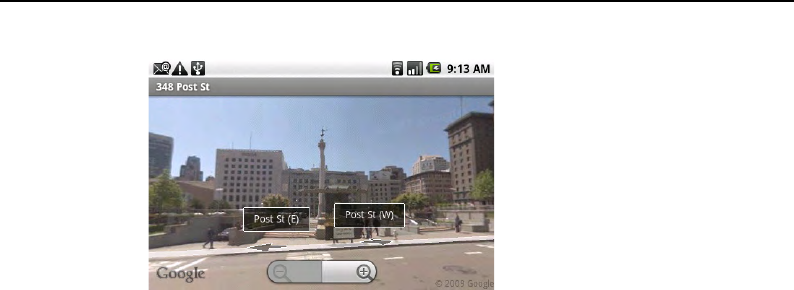
Maps 199
AUG-2.0.0-100 Android User’s Guide
To navigate in Street View
SDrag the image in any direction to pan up and down or to look in other
directions.
SZoom into the direction you’re looking.
SPress MENU and touch Step forward or Step backward to move up and
down the street. Or just touch a navigation arrow in the image.
SPress MENU and touch Compass mode to use the phone itself to navigate
Street View: tilt, pan, or turn your phone to change your view. Touch Compass
mode again to end it.
SPress MENU and touch Report image to open a web-based form for
reporting to Google about images with inappropriate content or privacy
concerns.
SPress MENU and touch Go to map to leave Street View.
Touch the view to display
navigation tools.
Touch the arrows to shift the
view up or down the street.
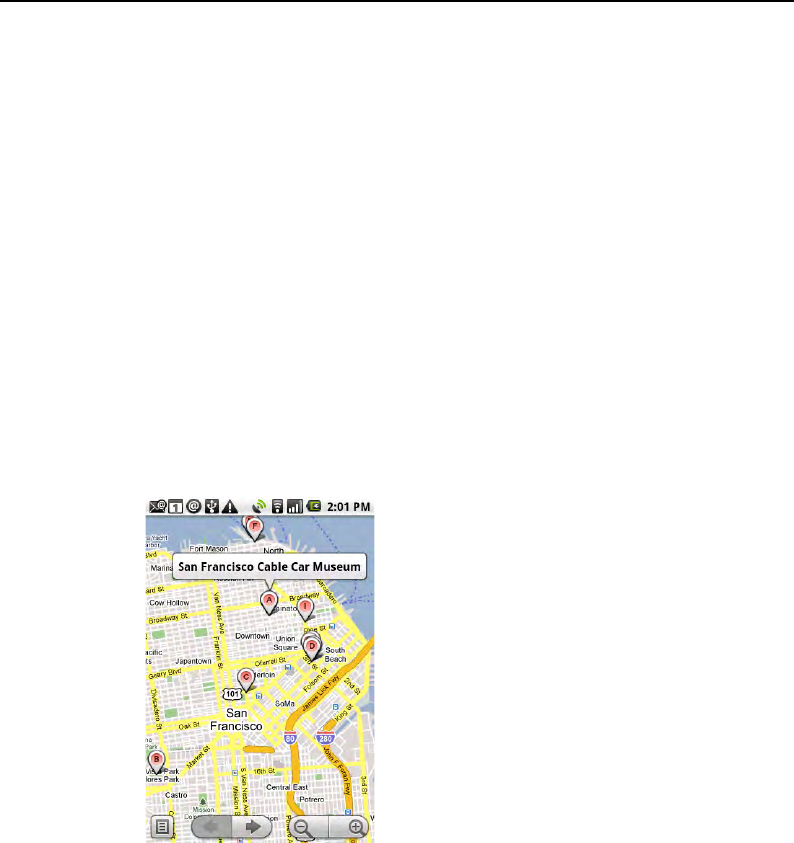
Maps 200
AUG-2.0.0-100 Android User’s Guide
Searching for locations and places
You can search for a location and view it on a map. You can also search for places on
the map you’re viewing.
To search for a location
1While viewing a map, press MENU and touch Search. Or press the SEARCH
button.
2Enter the place you’re looking for in the search box. You can enter an address, a
city, or type of business or establishment (for example, “museums in San
Francisco”).
As you enter information, previous searches for appear in a list below the search
box. You can touch one to search again.
3Touch the search icon.
Markers with letter labels indicate search matches on the map.
You can touch a marker to open a balloon with a label. Touch the balloon to
open a screen with more information about the location, as well as options for
obtaining directions.
Touch a marker to open a balloon with
more information.
Touch a balloon to open a screen with
more information about the location
Touch to select the next or previous
marker on the map and view its label.
Touch to open a list of all the results on
the map.
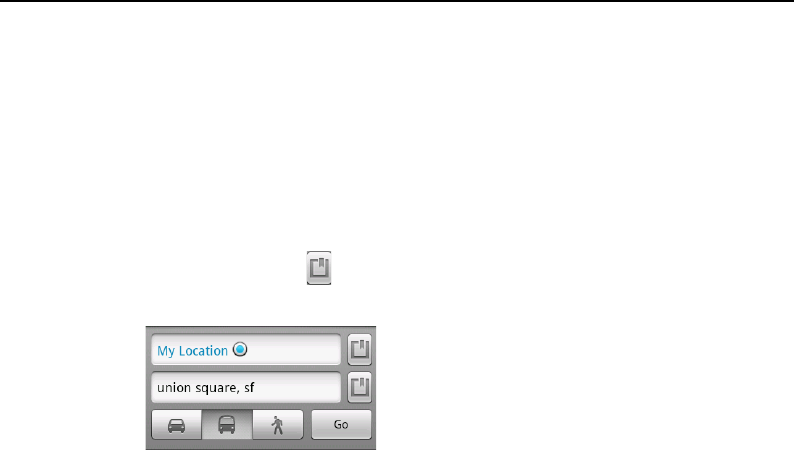
Maps 201
AUG-2.0.0-100 Android User’s Guide
Getting directions
Maps can provide directions for travel by foot, public transportation, or car.
To get directions
1While viewing a map, press MENU and touch Directions.
Enter a starting point in the first text box and your destination in the second
text box. Or touch to open a menu with options for selecting an address
form your Contacts or a point you touch on a map.
You can reverse direction by pressing MENU and touching Reverse start &
end.
2Touch the icon for car, public transit, or walking directions.
3Touch Go.
The directions to your destination appears in a list.
When you’re done, you can clear the map (press MENU and touch More >
Clear map). Your destination is saved.
Enter starting and ending locations.
Select a mode of transport.
Touch Go.

Maps 202
AUG-2.0.0-100 Android User’s Guide
Finding your friends with Google Latitude
Google Latitude lets you and your friends view each others’ locations on maps and
share status messages with each other. In Latitude you can also send messages and
emails, make phone calls, and get directions to your friends’ locations.
Your location is not shared automatically. You must join Latitude and then invite
your friends to view your location, or accept invitations from your friends.
To join Latitude
SWhile viewing a map, press MENU and touch Join Latitude.
The first time you join Latitude, you’re prompted to accept or reject the Google
privacy policy.
Once you’re joined Latitude, the menu item changes to Latitude.
To open Latitude
After you join Latitude, you can open it to find your friends and view their
updates.
SWhile viewing a map, press MENU and touch Latitude.
To invite friends to share their locations
After you join Latitude, you can start sharing your location with your friends. Only
friends that you have explicitly invited or accepted can see your location.
1Open Latitude, press MENU, and touch Add friends.
2Touch Select from Contacts or Add via email address in the menu that
opens.
If you touched Select from Contacts, a scrolling list of all your contacts
opens. You can check as many Contacts as you want to invite.
If you touched Add via email address, you can enter one or more email
addresses (separated by commas) for the friends you want to invite.
3Touch Add friends at the bottom of the screen.
If your friends already use Latitude, they receive an email request and a
notification on Latitude. If they have not yet joined Latitude, they receive an
email request that invites them to sign in to Latitude with their Google Account.

Maps 203
AUG-2.0.0-100 Android User’s Guide
To respond to an invitation
When a friend invites you to share your location in Latitude, you can respond with:
Accept and share back You and your friend can see each other’s locations
Accept, but hide my location You can see your friend's location, but they
can’t see yours.
Don’t accept. No location information is shared between you and your friend.
To view your friends’ locations
You can view your friends’ locations on a map or in a list.
When you open Maps, it shows your friends’ locations. Each friend is represented
by a photo icon with an arrow pointing at their approximate location. If a friend has
chosen to share city-level locations, their icon will not have an arrow and it appears
in the middle of the city.
If your friends use Google Talk, their online status (available, busy, and so on) is
indicated by a circular icon below their pictures. For more information, see
“Changing and monitoring online status” on page 153.
To see your friend’s profile and connect, touch the photo. Your friend’s name
appears in a balloon. Touch the balloon to open a screen with details about your
friend and many connection options.
When you open Latitude you see a list of your Latitude friends, with a summary of
their last known locations, status, and so on. Touch a friend in the list to open a
screen with details about the friend and many connection options.
To connect with and manage connections with your friends
Touch a friend’s contact details balloon in map view or touch a friend in list view to
open the friend’s profile. In the profile screen, you can communicate with your
friend and set privacy options.
Show on map Shows the friend’s location on the map.
Chat using Google Talk Opens a Google Talk chat window with that friend.
Send email Opens Gmail with a message addressed to the friend.
Directions Get directions to the friend’s location.

Maps 204
AUG-2.0.0-100 Android User’s Guide
Hide from this friend Stop sharing your location with this friend in Latitude,
in a list or on a map. To share your location with this friend again, touch Unhide
from this friend.
Share only city level location Share only the city you are in, not your
street-level location. Your friend sees your photo icon in the middle of the city you
are in. To share more precise location again, touch Best available location.
Remove Remove the friend from your list and stop sharing locations with him or
her altogether.
To control what you share
You have control over how and when you can be found by your friends. Only the
last location sent to Latitude is stored with your Google Account. If you turn off
Latitude or are hiding, no location is stored.
SOpen Latitude, touch your own name, and touch Edit privacy settings.
You can set the following privacy options.
Detect your location Let Latitude detect and update your location as you
move. The update frequency is determined by several factors, such as your phone’s
battery charge level and how recently your location has changed.
Set your location Set the location shared with others as an address you enter
or from Contacts, pick a spot on a map, or resume having Latitude share your actual
location.
Hide your location Hide your location from all your friends.
Turn off Latitude. Disable Latitude and stop sharing your location or status.
You can always join Latitude again.

205
AUG-2.0.0-100 Android User’s Guide
Camera
Camera is a combination camera and camcorder you use to shoot
and share pictures and videos.
“Your phone and accessories” on page 19 includes details about
preparing the camera before you use it (for example, peeling off any
protective film that covers the lens during shipping) and other camera
features.
Pictures and videos are stored on the phone’s SD card, so you must
install one to use Camera (see “Your phone and accessories” on
page 19). You can copy your pictures and videos from the SD card to
a computer, for backup and other purposes, as described in
“Connecting to a computer via USB” on page 66.
In this section
“Opening Camera and taking pictures” on page 206
“Reviewing your pictures” on page 209
“Reviewing your videos” on page 210
“Changing Camera settings” on page 211
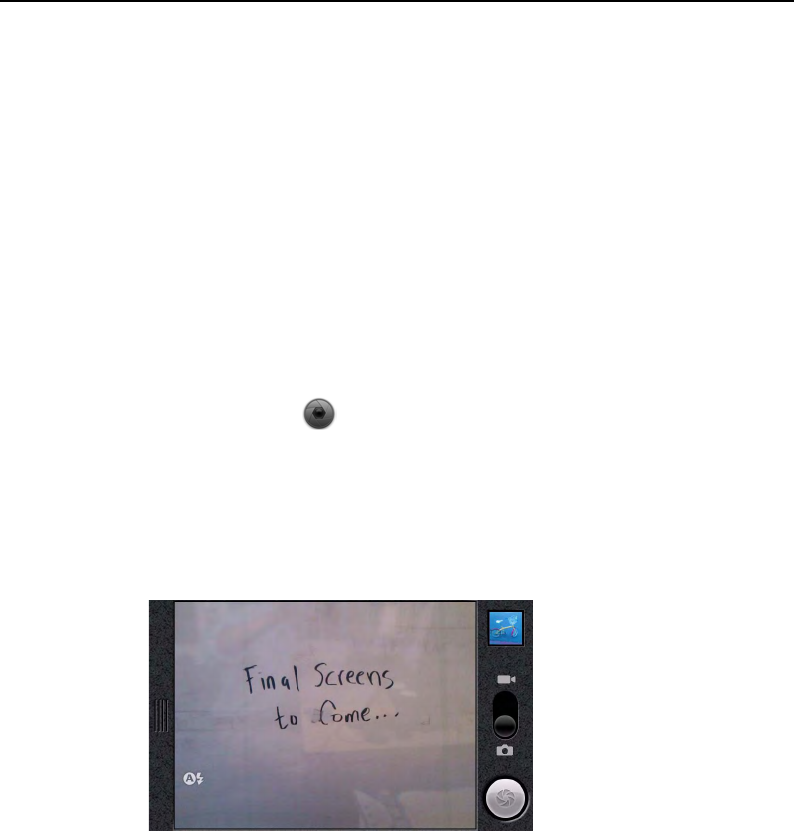
Camera 206
AUG-2.0.0-100 Android User’s Guide
Opening Camera and taking pictures
Take pictures and shoot videos with Camera.
Camera’s many settings are described in “Changing Camera settings” on page 211.
You can also view your pictures with the Gallery application, as described in
“Gallery” on page 215.
Important Be sure to clean the protective lens cover with a microfiber cloth before taking pic-
tures. Blurry pictures with a “halo” effect emanating bright areas are the hallmark of
a lens cover with smudges from fingers or other sources. See “Your phone and
accessories” on page 19 for more about the camera lens.
To open Camera
STouch the Camera icon on the Home screen or in the Applications tab.
OR
SPress the CAMERA button.<<cut for phones without button.>>
See “Opening and switching applications” on page 40 to learn more about
opening and switching applications.
Camera opens in landscape mode, ready to take a picture or shoot a video.
To take a picture
<<Need to adjust for phones with no Camera button>>
Touch to view your pictures or
videos
Drag up to shoot videos, drag
down to take photos
Touch to take a picture or
shoot a video
Touch to change settings

Camera 207
AUG-2.0.0-100 Android User’s Guide
1If necessary, drag the control to the camera position.
2If you want to control your exposure manually, touch the slider to open the
camera settings.
The preview image changes as you change the settings.
See “Changing Camera settings” on page 211
3Frame your subject on screen.
You can also zoom in by touching the screen and then touching the zoom in and
out controls <<confirm for devices>>.
4Partially press the CAMERA button to focus.
5Fully press the CAMERA button or touch the onscreen shutter button.
The camera’s autofocus feature brings the image into focus. When the image is
in focus, the focus indicators (in each corner) turn green and the camera takes a
picture.
The picture you just took is displayed for a moment. Then you can take another
picture or preview your pictures, as described in “Reviewing your pictures” on
page 209.
To take pictures with digital zoom
STouch the screen to open the zoom control and then touch the plus or minus
buttons to zoom in and out gradually.
SDouble-tap the screen to zoom in 4X. Double-tap again to zoom out to 1X.

Camera 208
AUG-2.0.0-100 Android User’s Guide
To shoot a video
1If necessary, drag the control to the video position.
2If you want to control your exposure manually, touch the slider to open the
camcorder settings.
See “Changing Camera settings” on page 211
3Point the lens to frame the scene where you want to start.
4Fully press the CAMERA button or touch the onscreen shutter button.
The camera starts shooting the video. The time remaining to shoot counts
down at the left; when less than a minute is left, the countdown turns red.
5Fully press the CAMERA button or touch the onscreen shutter button again to
stop shooting.
You can shoot another video or preview your videos (as described in “Reviewing
your videos” on page 210).
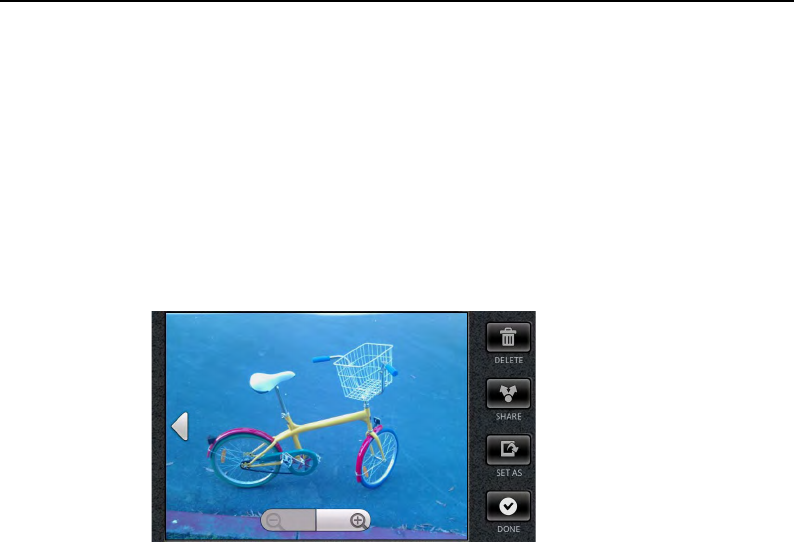
Camera 209
AUG-2.0.0-100 Android User’s Guide
Reviewing your pictures
You can review the pictures you’ve taken in Camera.
To review your pictures
1If necessary, drag the control to the photograph position.
2Touch the thumbnail image at the top right of the Camera screen.
The picture review screen opens, displaying your most recent picture.
3Touch the picture to see the navigation and zoom controls.
4Touch a navigation arrow to view the next or previous picture.
5Touch Done to resume taking pictures.
You can use the other buttons on the picture review screen and press MENU to
access several other features for editing, sharing, viewing, and using pictures in other
ways. These are detailed in “Working with pictures” on page 218.
Touch the image to see the
navigation and zoom controls
Touch a left of right arrow to
view another picture
Touch to return to the screen
for taking pictures
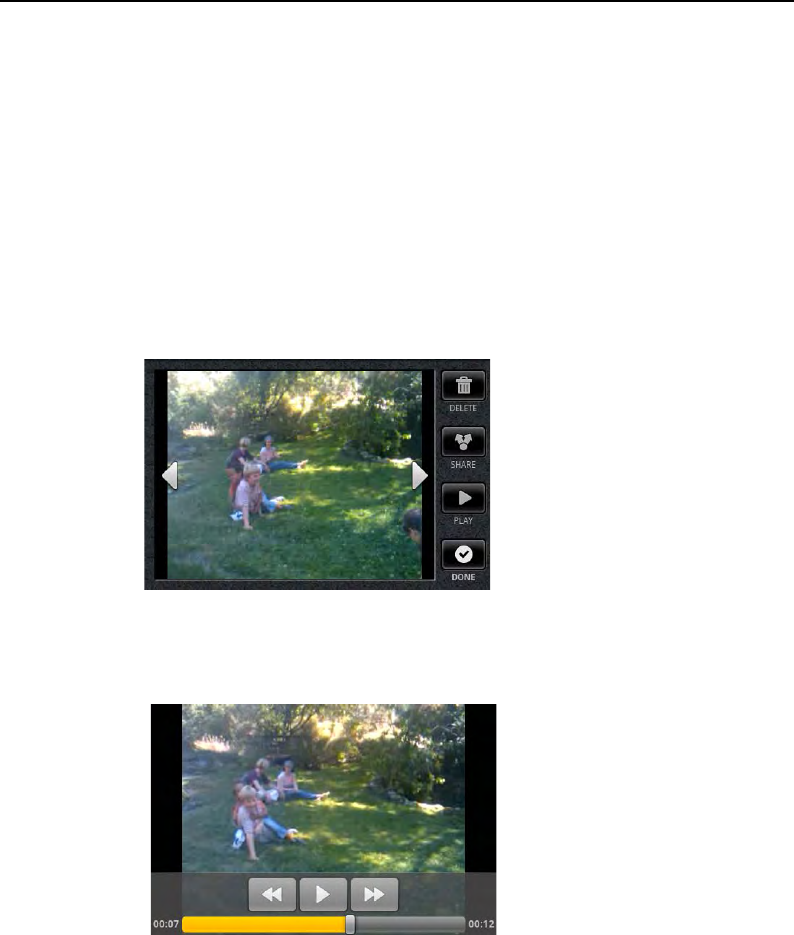
Camera 210
AUG-2.0.0-100 Android User’s Guide
Reviewing your videos
You can review the videos you’ve shot with Camera. You can also view a slideshow
of your pictures, share them with friends, and delete shots (see “Gallery” on
page 215 for more about playback).
To review your videos
1If necessary, drag the control to the video position.
2Touch the thumbnail image at the top right of the screen.
A still from the start of your most recent video is displayed.
3Touch a navigation button to open the video you want to play.
4Touch the Play button.
You can use the other buttons on the video review screen and press MENU to
access several other features for viewing and sharing your videos. These features are
detailed in “Gallery” on page 215.
Touch the still to see the
navigation controls
Touch a left of right arrow to
view another video
Touch to play the video
Touch to return to the screen
for shooting videos
Touch to skip forward or back
Touch to pause and resume play

Camera 211
AUG-2.0.0-100 Android User’s Guide
Changing Camera settings
Camera has automatic settings you can use to take quick point-and-shoot
photographs and videos. But Camera also offers a number of ways to control your
exposures, including controlling the focus, turning the flash on and off, adjusting the
white balance, or taking advantage of combinations of exposure settings for specific
scenes. You can even shoot negatives and other special effects.
Camera also includes a series of other settings for controlling picture quality, video
length, whether to store the location where you take your pictures, and so on.
To change Camera settings
1Open the Camera screen for taking pictures or shooting videos and touch the
settings tab. Or press MENU and touch Settings.
The settings open over the screen.
2Touch the setting category you want to control and then touch the setting you
want.
Camera settings are detailed in “Changing Camera settings” on page 211
If you select a scene mode, you can’t adjust some of the other settings until you
return scene mode to the Auto setting.
3Press Back to close the settings menus.
Icons along the left side of the screen indicate the current settings.
4Take the pictures you want using your settings.
5When you’re done, open Camera settings again and restore the settings you
change back to Auto.
Camera settings
When you change some Camera settings, the current settings are indicated by a
column of icons along the left side of the screen.
Flash mode Touch to set whether the camera relies on its light meter to
decide if a flash is necessary or to turn it on or off for all shots.
Automatic
On
Off
Scene mode See “Scene modes” on page 212.
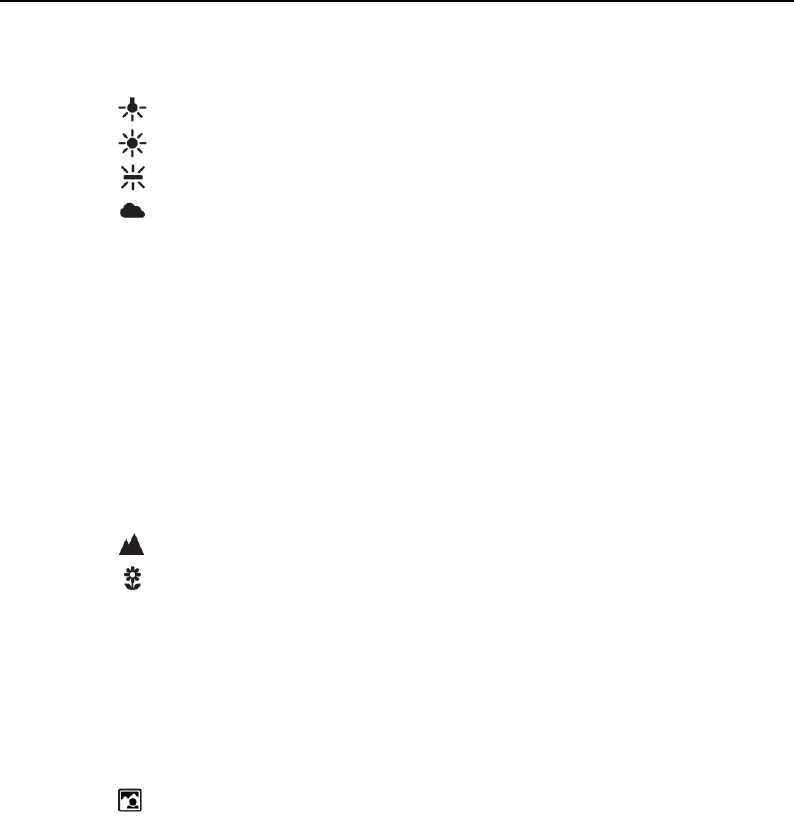
Camera 212
AUG-2.0.0-100 Android User’s Guide
White balance Touch to select how the camera adjusts colors in different
kinds of light, to achieve the most natural-looking colors for your shots.
Incandescent
Daylight
Fluorescent
Cloudy
Color effect Touch to select a special effect for your shots, such as
monochrome, sepia tone, negative, and others.
Store location Check to include the location of each picture you take, using
the phone’s GPS.
Picture size Touch to set the size (in pixels) of the pictures you take.
Picture quality Touch to set the quality of the pictures you take.
Focus mode Touch to set Camera to use its autofocus feature (Auto), to more
quickly take pictures focused at infinity (Infinity), or for close-ups (Macro).
Infinity
Macro
Scene modes
Scene modes are combinations of shutter speed, white balance, flash, and related
settings, optimized for specific shooting conditions. When you select a scene mode,
you can’t adjust other Camera exposure settings until you select the Auto scene
mode again. An icon in the preview pane reminds you that you have selected a
scene mode.
Scene mode selected
Auto No scene mode selected.
Action Use for short exposures to reduce blur for fast-moving action.
Portrait Use to capture the details of a subject.
Landscape Use when all subjects are in the distance.
Night Use for a long exposure without flash.

Camera 213
AUG-2.0.0-100 Android User’s Guide
Night Portrait Use for a long exposure, with flash to illuminate the subject,
but without sacrificing darker background detail.
Theatre Use for a short exposure to reduce blur, with spot metering that
assumes well-lit subjects on a stage, and no flash.
Beach Use for taking pictures at the beach.
Snow Use for taking pictures in the snow.
Sunset Use for scenes with orange skies and darker foregrounds.
Steady photo Use to keep exposure times shorter to reduce blur from
unsteady hands.
Camcorder settings
Video quality Opens a dialog where you can set the video quality appropriate
for sending to your friends via the Messaging or other application, or for viewing on
a computer.
Video duration Opens a dialog where you can set the maximum length of your
videos.

Camera 214
AUG-2.0.0-100 Android User’s Guide

215
AUG-2.0.0-100 Android User’s Guide
Gallery
Use Gallery to view photos and play back videos. For photos, you can
also perform basic editing tasks, set them as your wallpaper or
contact picture, and so on. You can also share your pictures and
videos with friends, via email or messaging, or on the Picasa and
YouTube web sites.
In this section
“Opening Gallery and viewing your albums” on page 216
“Working with pictures” on page 218
“Working with videos” on page 221
“Changing Gallery settings” on page 223
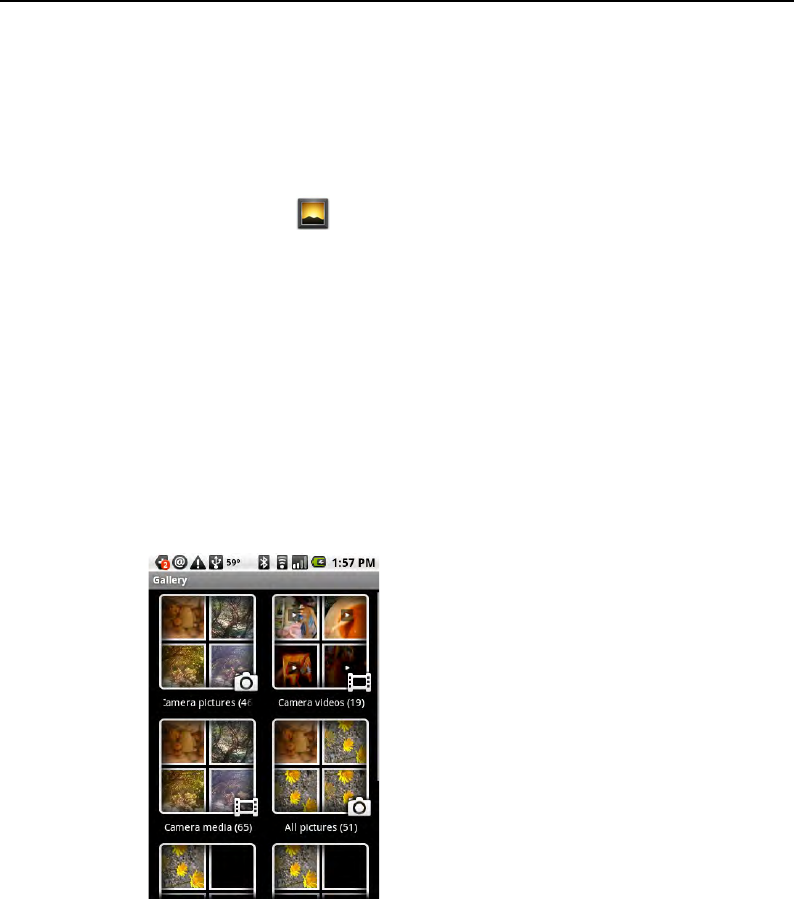
Gallery 216
AUG-2.0.0-100 Android User’s Guide
Opening Gallery and viewing your albums
Open Gallery to view albums of your pictures and videos.
To open Gallery and view your albums
STouch the Gallery icon on the Home screen or in the Applications tab.
OR
SOpen Gallery from Camera by pressing MENU and touching Gallery.
See “Opening and switching applications” on page 40 to learn more about
opening and switching applications.
Gallery presents the pictures and videos on your SD card in albums. The first
two are for the pictures and videos you took with Camera. Others include all
pictures or videos found on the SD card and, if you created directories with
pictures or videos on the SD card, albums named for those directories.
If you have a great many pictures or videos on your SD card, it may take Gallery
a few moments when you open it to discover them and organize them into
albums.
STouch an album to open it and view its contents.
Touch a an album to open it.

Gallery 217
AUG-2.0.0-100 Android User’s Guide
STouch a picture or video in a gallery to open it.
Working with the pictures you open is described in “Working with pictures” on
page 218.
Working with the videos you open is described in “Working with videos” on
page 221.
You can change settings for the size and order of the pictures and images in
albums, as described in “Changing Gallery settings” on page 223.
Touch a picture to open it.
Touch a video to open it.
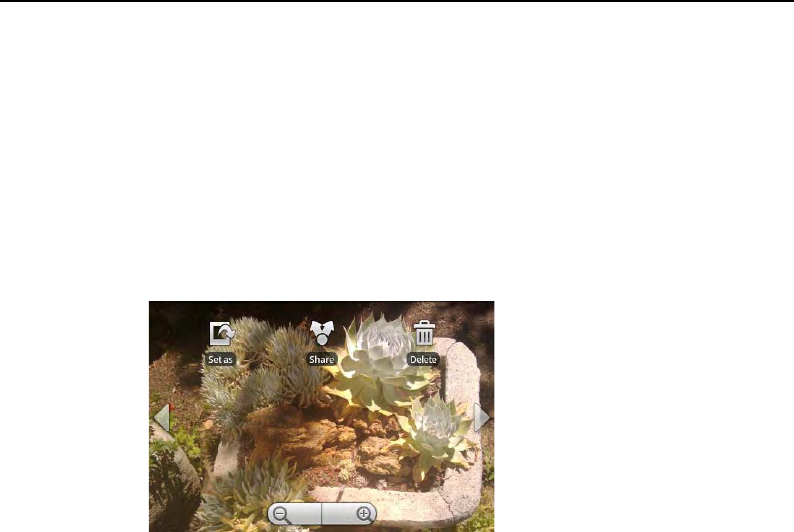
Gallery 218
AUG-2.0.0-100 Android User’s Guide
Working with pictures
Use Gallery to view pictures, edit them, and share them with friends.
To view and browse pictures
SOpen a Gallery album and touch a picture.
Opening albums is described in “Opening Gallery and viewing your albums” on
page 216.
STurn the phone to view the picture in upright (portrait) or sideways (landscape)
orientation.
The picture is displayed (but not saved) in the new orientation.
STouch the picture to view the navigation, zoom, and other controls.
STouch the magnifiers to zoom in our out. Or just double-tap the screen.
SDrag the picture to view parts that are not in view.
STouch the left or right arrows to browse to the previous or next picture.
To watch a slideshow of your pictures
SWhen viewing a picture, press MENU and touch Slideshow.
You can control the pace and other slideshow settings as described in “Changing
Gallery settings” on page 223.
To rotate a picture
1When viewing a picture, press MENU and touch Rotate.
2Touch Rotate left or Rotate right.
The picture is saved with the new orientation.
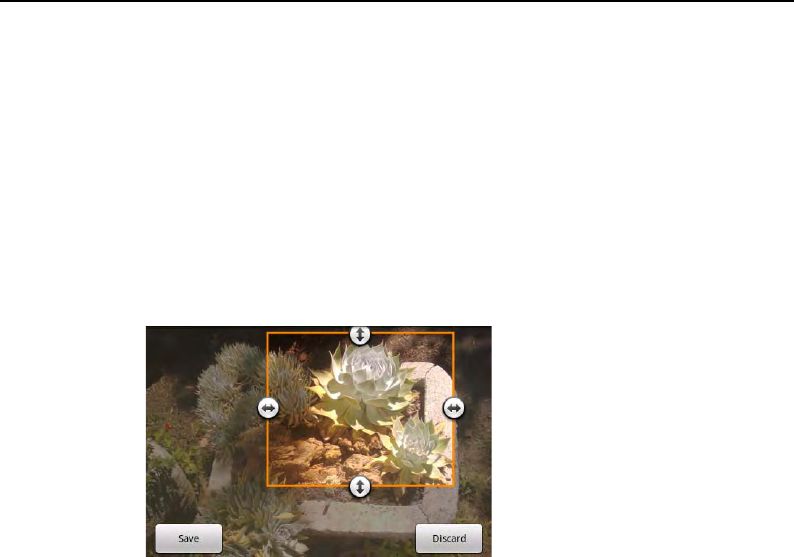
Gallery 219
AUG-2.0.0-100 Android User’s Guide
To crop a picture
You can ave a zoomed-in portion of a picture by cropping it.
1When viewing a picture, press MENU and touch Crop.
The cropping rectangle appears on top of the picture.
2Use the cropping tool to select the portion of the picture you want to crop.
Drag from the inside of the cropping tool to move it.
Drag an edge of the cropping tool to resize it to any proportion.
Drag a corner of the cropping tool to resize it with fixed proportions.
3Touch Save to save a copy of the picture as you cropped it.
The original uncropped version remains on your SD card.
To use a picture as a contact icon or as Home screen wallpaper
1When viewing a picture, touch the picture to view the controls and touch the
Set as icon. Or press MENU and touch More > Set as.
2Touch Contact icon or Wallpaper.
If you touch Contact, you’re asked to select the contact you want to use the
picture for and then crop the picture.
If you touch Wallpaper, you’re prompted to crop the picture.
To get details about a picture
SWhen viewing a picture, press MENU and touch More > Details.
Drag from inside the cropping
tool to move it
Drag a corner or edge to
resize the cropping tool and
zoom in or out
When you’re done, touch Save

Gallery 220
AUG-2.0.0-100 Android User’s Guide
To view the location of a picture in Google Maps
If you have configured Camera to save location data with your pictures (see
“Changing Camera settings” on page 211), you can view the location where you
took the picture in Google Maps.
SWhen viewing a picture, press MENU and touch More > Show on Maps.
Google Maps opens, centered on the location stored in the picture.
To share a picture by sending it to friends
1When viewing a picture, touch the picture to view the controls and touch the
Share icon. Or press MENU and touch Share.
2Touch Email, Gmail, or Messaging in the menu.
The application you picked opens with the picture attached to a new message.
For more information about addressing and sending the message, see the
section on that application.
To share a picture by uploading it to Picasa
You can upload pictures to the Picasa account that is associated with your
Google Account.
1When viewing a picture, touch the picture to view the controls and touch the
Share icon. Or press MENU and touch Share.
2Touch Picasa in the menu.
3Enter a caption for the picture.
4Pick or add an album for the picture.
5Touch Upload.
The picture is uploaded to Picasa. When it’s done, you can view it at the Picasa
web site (http://picasaweb.google.com).
To delete a picture
SWhen viewing a picture, touch the picture to view the controls and touch the
Delete icon. Or press MENU and touch Delete.
A dialog asks you to confirm you want to delete the picture (unless you
configured Gallery to delete without asking, as described in “Changing Gallery
settings” on page 223).
You can also delete multiple pictures in an album by pressing MENU, touching
Multiselect, checking the pictures you want to delete, and touching Delete.

Gallery 221
AUG-2.0.0-100 Android User’s Guide
Working with videos
Use Gallery to play videos and share them with friends.
To play videos
SOpen a Gallery album and touch a video.
The video plays, with the orientation (portrait or landscape) you shot it in.
Opening albums is described in “Opening Gallery and viewing your albums” on
page 216.
STouch the video to view the playback controls.
To share a picture by sending it to friends
You can send any video that is 3MB or smaller: approximately 1 minute of high-
quality video or 2 minutes of low-quality video (see “Changing Camera settings” on
page 211).
1When viewing an album, touch & hold the video you want to send.
Touch Share.
2Touch Bluetooth, email, Gmail, or Messaging.
The options in the menu depend on your phone’s applications, Bluetooth
settings, and so on.
The application you picked opens with the video attached to a new message. For
more information about addressing and sending the message, see the section on
that application.
Touch the video to view the
playback controls for pausing,
resuming, and skipping
backwards and forwards

Gallery 222
AUG-2.0.0-100 Android User’s Guide
To share videos on YouTube
You can share your videos by uploading them to YouTube. Before you do this, you
must create a YouTube account and sign into it on your phone.
You can upload any video that is 3MB or smaller: approximately 1 minute of high-
quality video or 2 minutes of low-quality video (see “Changing Camera settings” on
page 211).
1When viewing an album, touch & hold the video you want to send.
Touch Share.
2Touch YouTube.
3Enter a title, description, and tags for your video.
4Check Public if you want to share the video with everyone.
5Touch Upload.
To delete a video
1When viewing an album, touch & hold the video you want to delete.
2Touch Delete.
A dialog asks you to confirm you want to delete the video (unless you
configured Gallery to delete without asking, as described in “Changing Gallery
settings” on page 223).
You can also delete multiple videos in an album by pressing MENU, touching
Multiselect, checking the videos you want to delete, and touching Delete.

Gallery 223
AUG-2.0.0-100 Android User’s Guide
Changing Gallery settings
You can change a number of settings for how Gallery displays pictures and videos,
how it presents slideshows, and other settings.
STo change Gallery settings, press MENU, and touch Settings (or More >
Settings, depending on the Gallery screen).
General settings
Display size Opens a dialog where you can set the display size of pictures and
videos.
Sort order Opens a dialog where you can set whether pictures in albums are
sorted newest-first or oldest-first.
Confirm deletions Check to open a confirmation dialog when you delete a
picture or video. Uncheck to delete without asking.
Slideshow settings
Slideshow interval Opens a dialog where you can set how many seconds to
display each picture in a slideshow.
Slideshow transition Opens a dialog where you can pick the transition
animation between pictures in a slideshow.
Repeat slideshow Check to repeat slideshows until you touch the screen.
Shuffle slides Check to display pictures in random order during a slideshow.
Uncheck to display them in their order in their album.

Gallery 224
AUG-2.0.0-100 Android User’s Guide
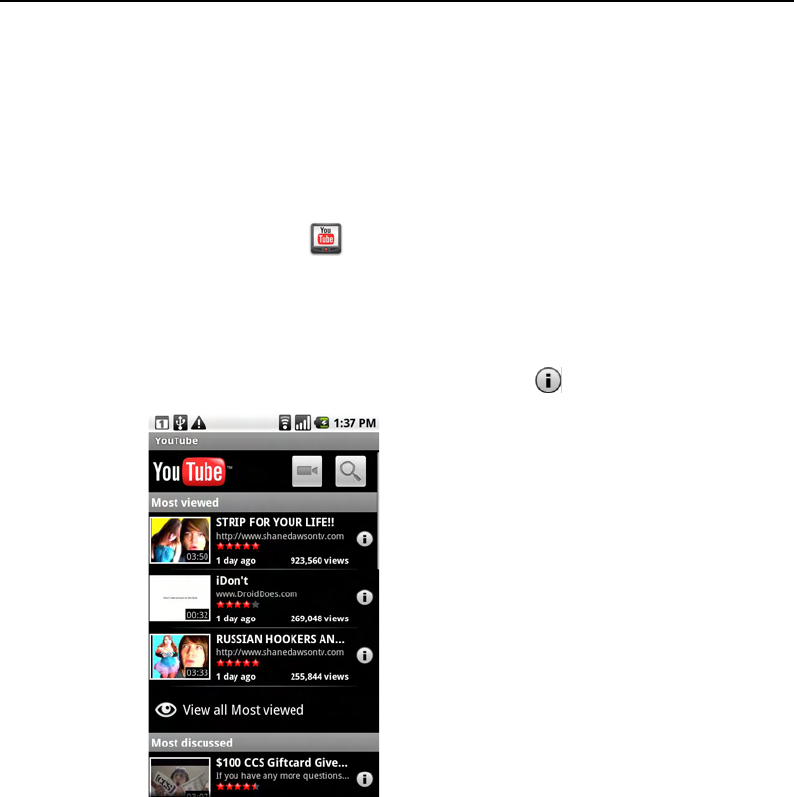
YouTube 226
AUG-2.0.0-100 Android User’s Guide
Opening YouTube and watching videos
You can browse, search for, view, upload, and rank videos on YouTube on your
phone with the YouTube application.
To open YouTube
STouch the YouTube icon on the Home screen or in the Applications tab.
See “Opening and switching applications” on page 40 to learn more about
opening and switching applications.
YouTube presents the videos grouped into categories, such as Most viewed,
Most discussed, Most recent, and Top rated.
You can touch a video to watch it, or touch the icon to learn more about it.
To watch and interact with YouTube videos
SOn a YouTube screen, touch a video to play it.
Touch to shoot and share a video
Touch to search for a video (you can
even search by voice)
Videos are grouped into categories.
Touch a video to play it.
Touch to learn more about the video
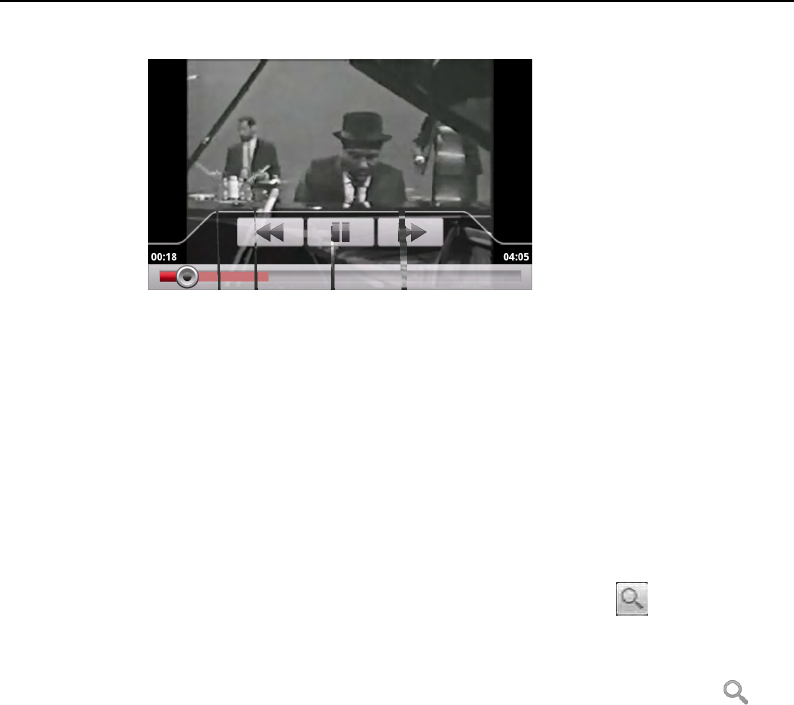
YouTube 227
AUG-2.0.0-100 Android User’s Guide
STouch the video to view the playback controls.
You can pause, skip forward or backwards, or drag the slider to the point in the
video you want to watch, with the playback controls.
SPress BACK to stop playback and return to the videos list.
SPress MENU to rank, comment on, share, flag as inappropriate, and to interact
with the video in other ways.
For details about these features, visit the YouTube web site.
To search for videos
1At the top of the main YouTube screen, touch the search icon.
2Enter the text you want to search for, or touch the microphone to search by
voice.
3Touch a suggestion below the search box or touch the magnifying glass icon.
4Scroll through the search results and touch a video to watch it.
To share your videos on YouTube
You shoot and share a video via YouTube. Before you do this, you must create a
YouTube account and sign into it on your phone.
You can also share the videos you shot with the Camera application by uploading
them to YouTube (see “Working with videos” on page 221).
Touch the screen to view
the playback controls.

YouTube 228
AUG-2.0.0-100 Android User’s Guide
1At the top of the main YouTube screen, touch the camera icon.
2If you want to control your exposure manually, touch the slider to open the
camcorder settings.
See “Changing Camera settings” on page 211
3Point the lens to frame the scene where you want to start.
4Fully press the CAMERA button or touch the onscreen shutter button.
<<Watch devices without button.>>The camera starts shooting the video. The
time remaining to shoot counts down at the left; when less than a minute is left,
the countdown turns red.
5Fully press the CAMERA button or touch the onscreen shutter button again to
stop shooting.
You can reshoot the video or preview it (as described in “Reviewing your
videos” on page 210).
6Touch OK.
You return to YouTube’s Upload details screen.
7Enter a title, description, and tags for your video.
8Check Public if you want to share the video with everyone.
9Touch Upload.

229
AUG-2.0.0-100 Android User’s Guide
Music
Use Music to organize and listen to music and other audio files you
transfer to your SD card from your computer.
In this section
“Transferring music files to your phone” on page 230
“Opening Music and working with your library” on page 231
“Playing music” on page 233
“Working with playlists” on page 236

Music 230
AUG-2.0.0-100 Android User’s Guide
Transferring music files to your phone
Music plays audio files stored on your phone’s SD card, so before you open Music,
you must copy audio files from your computer onto the SD card.
Music supports a wide variety of audio file formats, so it can play music you have
purchased from iTunes and other online stores as well as music you have copied
from your CD collection, an so on.
Music supports audio files in the numerous formats, including MP3, M4A (iTunes
application AAC, DRM-free), AMR, WMA (8), MIDI, WAV, and OGG Vorbis.
To copy music files onto the phone’s SD card
1Connect your phone to your computer with a USB cable and mount the SD
card.
For details, see “Connecting to a computer via USB” on page 66.
2Use the computer to create a music folder at the top level of the SD card.
You can give the folder any name you want.
3Use the computer to copy music and other audio files into the folder you
created on the SD card.
You can use subfolders on the SD card to organize your music files.
If the music files have accompanying artwork in JPEG format, rename the art file
albumart.jpg and include it in the same folder as the music files.
4If you have created any playlists, create a subfolder for them in your music folder
on the SD card and copy the playlists into it.
5Unmount the SD card from the computer and disconnect the phone.
Be sure to follow your computer’s instructions and those “Connecting to a
computer via USB” on page 66, to avoid damaging files on your SD card.
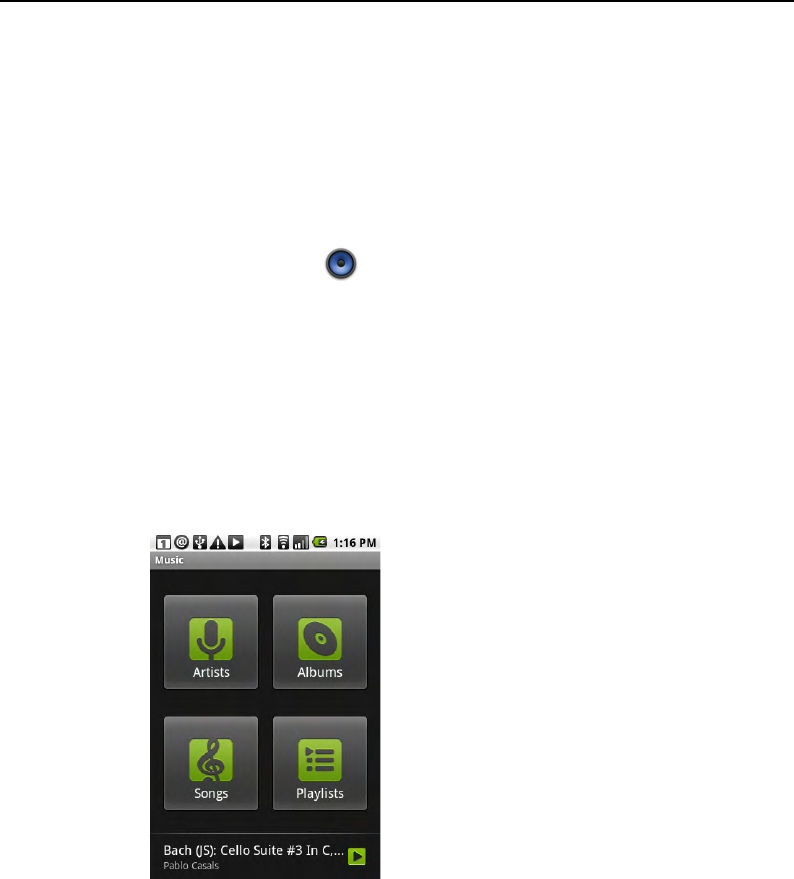
Music 231
AUG-2.0.0-100 Android User’s Guide
Opening Music and working with your library
Once you’ve copied some music onto your SD card (as described in “Transferring
music files to your phone” on page 230), you can open Music and see your library of
music files, sort in several ways.
To open Music and view your music library
STouch the Music icon on the Home screen or in the Applications tab.
See “Opening and switching applications” on page 40 to learn more about
opening and switching applications.
When you first open Music after copying music files to your SD card, Music
searches the SD card for music files and builds a catalog of your music, based on
information about each file stored in the file itself. This can take a minute or
two, depending on how may files you copied onto the SD card since you last
opened Music.
Then the Music library screen opens, with icons you can touch to view your
music library organized by Artists, Albums, Songs, or Playlists.
You can return to the main library screen form most other screens in the Music
application by pressing MENU and touching Library.
When your keyboard is open, you type characters to limit the songs in the
current library to those that match.
Touch an icon to view your library in
one of four ways
Touch the summary of the currently
playing (or paused) track to open the
Playback screen

Music 232
AUG-2.0.0-100 Android User’s Guide
To search for music in your library
1Open the main library screen and press the SEARCH button.
2Start typing the name of the artist, album, or track you’re looking for.
Matching songs are displayed in the list below the search box.
3Touch a matching song to play it. Or touch a matching album or artist to view a
list or associated songs.
To delete a song from the SD card
You can delete music from the storage card.
STouch & hold a song in a library list and in the menu that opens, touch Delete.
OR
SOn the Playback screen, press MENU and touch Delete.
You can also delete music files from the SD card, when your phone is connected to
a computer, as described in “Transferring music files to your phone” on page 230.
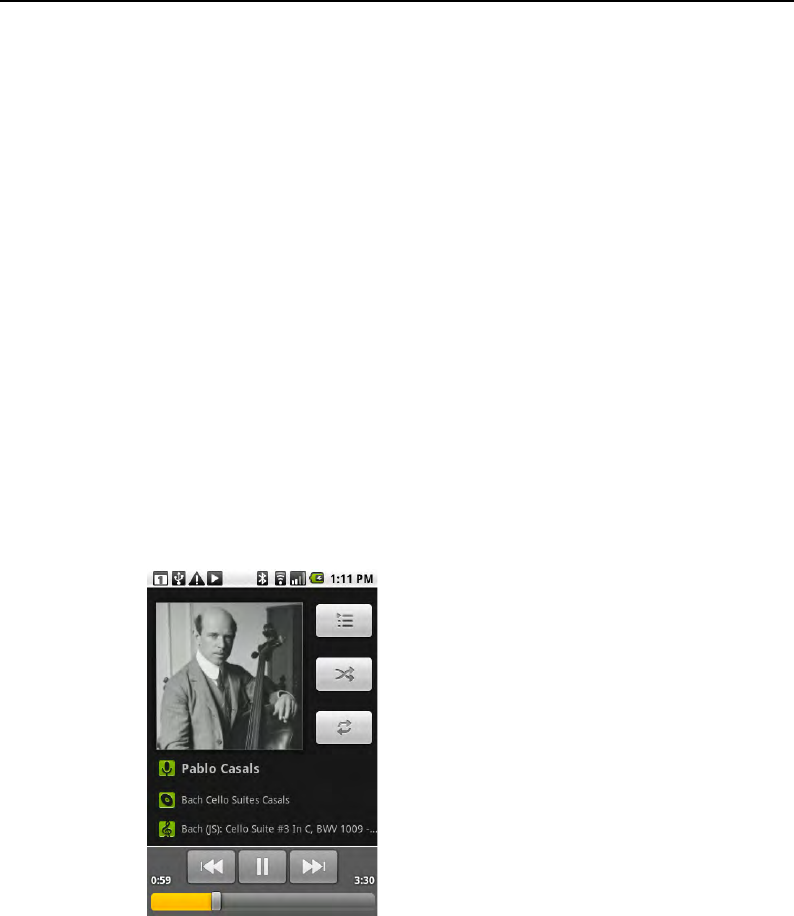
Music 233
AUG-2.0.0-100 Android User’s Guide
Playing music
Once you’ve copies music files onto your SD card found the tracks you want to
listen to in your music library, you can play them.
You can listen to music using the phone’s built-in speaker, using a wired headset, or
using a wireless Bluetooth stereo headset that supports the A2DP profile (see
“Your phone and accessories” on page 19 and “Connecting to Bluetooth devices”
on page 63 for details).
To p l ay m u s i c
STouch a song in your library to listen to it.
OR
SWhen viewing a list of tracks in an album, press MENU and touch Play all.
The Playback screen opens and the song you touched or the first song in the
album or other playlist starts to play. Each track in the current playlist plays in
order, until you reach the end of the playlist (unless you choose a repeat
option). Otherwise, playback only stops if you stop it, even when you switch
applications or the screen lock turns on, or if you receive a phone call.
You can return to the Playback screen from most other screens in the Music
application by pressing MENU and touching Playback.
You can return to the Playback screen from any other application by opening the
Notifications panel and touching the ongoing music notification (see “Managing
notifications” on page 46).
Touch to open the current playlist
Touch to shuffle the current playlist
Touch to repeat the playlist; touch again to repeat
the current track
Touch and hold to search for information
Use these buttons to skip tracks and to pause and
resume playback
Drag to listen to another section of the track
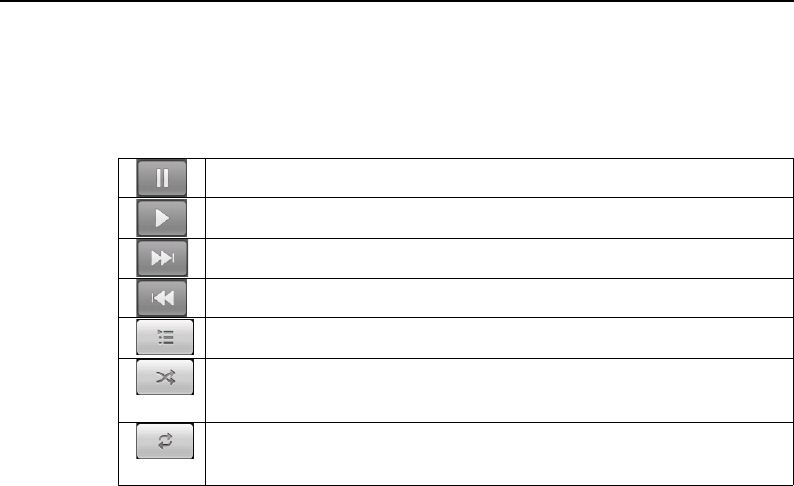
Music 234
AUG-2.0.0-100 Android User’s Guide
To control playback
The Playback screen offers several icons you can touch to control the playback of
songs, albums, and playlists:
To control playback volume
In addition to the techniques for setting media volume described in “Sound &
display settings” on page 262, you can control the volume of music in the Music
application.
SPress your phone’s VOLUME UP or VOLUME DOWN button.
A panel opens to show the current media volume; the indicator moves as you
adjust the volume.
Some headsets include their own volume controls or ways to pause and resume
playback or to switch tracks.
To play all your tracks in a shuffle
In addition to playing the current playlist in a shuffle, you can play all the tracks on
your SD card in random order.
SIn the Playback or a library screen, press MENU and touch Party shuffle.
Press Menu and touch Party shuffle off to stop it.
To use a song as a ringtone
You can use a song as your phone ringtone, in place of one of the ringtones that
comes with the phone.
Touch to pause playback.
Touch to resume playback
Touch to skip to the next track in the album, playlist, or shuffle
Touch to skip to the previous track in the album, playlist, or shuffle
Touch to open the current playlist
Touch to play the current playlist in shuffle mode (tracks are played in
random order)
Touch to toggle repeat mode: Don’t repeat, Repeat the playlist, and
Repeat the current track

Music 235
AUG-2.0.0-100 Android User’s Guide
STouch & hold a song in a library list and in the menu that opens, touch Use as
phone ringtone.
OR
SOn the Playback screen, press MENU and touch Use as ringtone.
For details about using the Settings application to view and set the phone’s ringtone,
see“Sound & display settings” on page 262.

Music 236
AUG-2.0.0-100 Android User’s Guide
Working with playlists
You can create playlists to organize your music files into sets of songs, which you
can play in the order you set or in a shuffle.
To create a playlist
1When viewing a list of songs in the library, touch & hold the first song you want
to add to new playlist.
2Touch Add to playlist.
3Touch New.
4Enter a name and touch Save.
The new playlist is added to the playlist library.
You can also add the song playing in the Playback screen as the first song in a
playlist by pressing MENU and touching Add to playlist. Or touch Save as
playlist to save all the songs in an album you’re playing as a playlist.
You can convert an album into a a
To add a song to a playlist
1When viewing a list of tracks in the library, touch & hold a song you want to add
to a playlist.
2Touch Add to playlist.
3Touch the name of the playlist you want to add the song to.
The song is added to the playlist.
You can also add the song playing in the Playback screen to a playlist by pressing
MENU and touching Add to playlist.
To rearrange songs in a playlist
1Open a playlist.
You can open a playlist by touching one in the playlist library. You can also open
the currently playing playlist by touching the playlist icon in the Playback window.
2Drag a song up or down, to change its order in the playlist.
You can also use this technique to change the order of songs in an album.

Music 237
AUG-2.0.0-100 Android User’s Guide
To remove a song from a playlist
1Open a playlist.
2Touch & hold a song and then touch Remove from playlist. Or press
MENU and touch Clear playlist to remove all the songs from the playlist.
The song isn’t deleted from the SD card or other playlists, just removed the
playlist you’re working with.
To rename or delete a playlist
1Open the playlist library.
2Touch & hold a playlist and in the menu that opens, touch Rename or Delete.
You can’t delete or rename the Recently Added playlist.
No songs are harmed by deleting a playlist.
To create playlists on your computer
You can create playlists on your computer for use in Music. Music can work with
playlists in the file formats: M3U, WPL, and PLS. You copy playlists onto your SD
card in the same way as you copy music, as described in “Transferring music files to
your phone” on page 230. The best practice is to create a subfolder within your
music folder for playlists.
If you don’t have a dedicated application on your computer that can create playlists,
you can create a playlist in a text editor, using the following guidelines:
GEnter each music file name you want to include in the playlist on its own line
GUse music file names as displayed on your computer (Music will ignore all but
the track names when displaying the playlist).
GSave the file with the .m3u extension

Music 238
AUG-2.0.0-100 Android User’s Guide

239
AUG-2.0.0-100 Android User’s Guide
Alarm Clock
You can use your phone as an alarm clock. You can set one-time
alarms or alarms that play on weekdays, every day, or other times.
You can use one of your music tracks as a ringtone or use one of the
alarm ringtones that comes with your phone.
In this section
“Setting an Alarm” on page 240
“Customizing Alarm Clock” on page 242
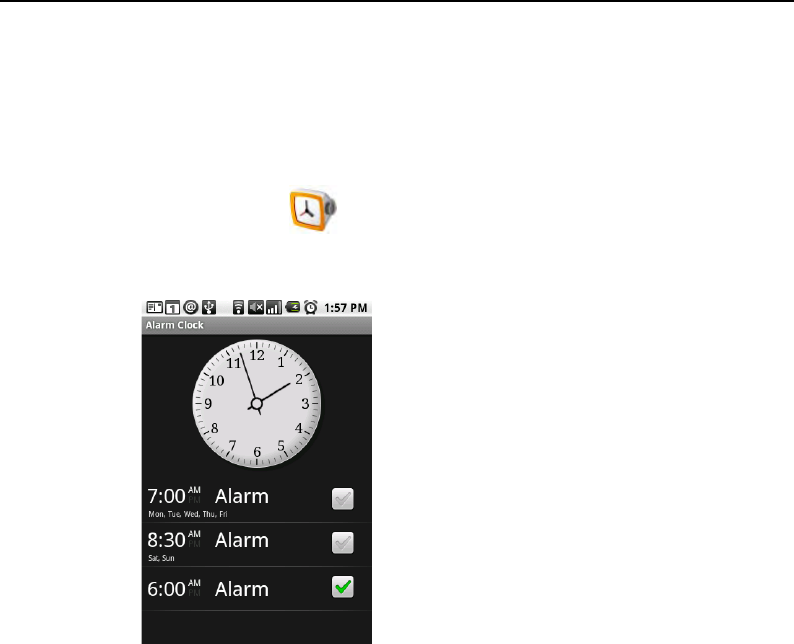
Alarm Clock 240
AUG-2.0.0-100 Android User’s Guide
Setting an Alarm
You can set an alarm by modifying an existing one, or by adding a new one.
To set an alarm
1Touch the Alarm icon on the Home screen or in the Applications tab.
See “Opening and switching applications” on page 40 to learn more about
opening and switching applications.
2Touch an existing alarm to change its time and other attributes. Or press
MENU and touch Add alarm to add a new one.
Touch the clock face to
change it
Check an alarm to turn it on
Touch an alarm to open a
screen where you can set its
time and other attributes
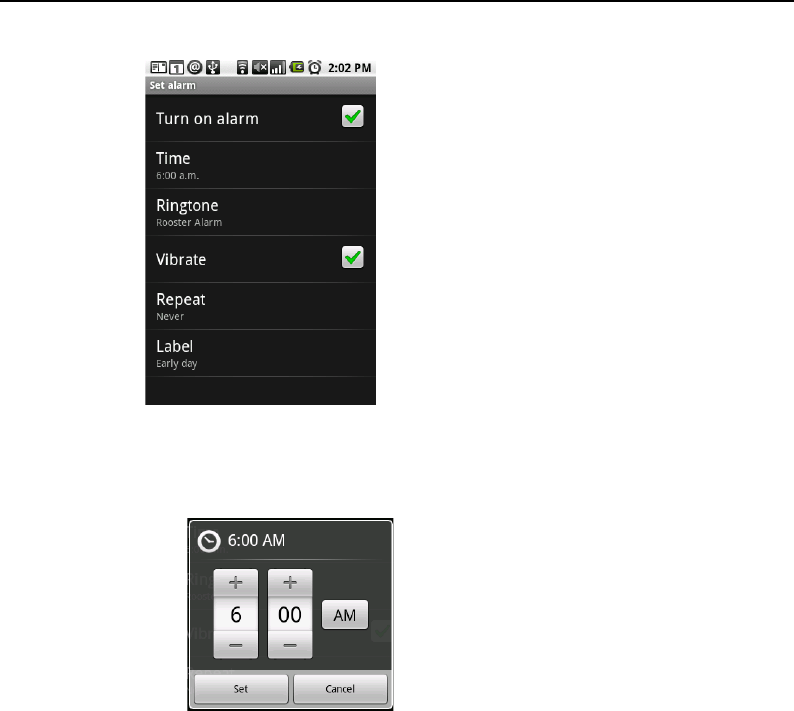
Alarm Clock 241
AUG-2.0.0-100 Android User’s Guide
3Touch Time to set the time of the alarm.
You can change the time by touching the + and - buttons and AM or PM. Or
touch a time to type the time you want.
4Touch Ringtone to pick a ringtone for the alarm.
The ringtone plays briefly when you select it.
5Touch Vibrate to configure the alarm to vibrate the phone, in addition to
playing the ringtone.
6Touch Repeat to set the days when you want the alarm to sound.
If you don’t set a day, the alarm will sound only once.
7Touch Label to type a name for the alarm.
8When you’re done, press BACK.
When the time you set arrives, the alarm sounds.
Touch to set a later
time
Touch to type the
time
Touch to set an
earlier time
Touch Set when
you’re done
Touch to change from AM to
PM
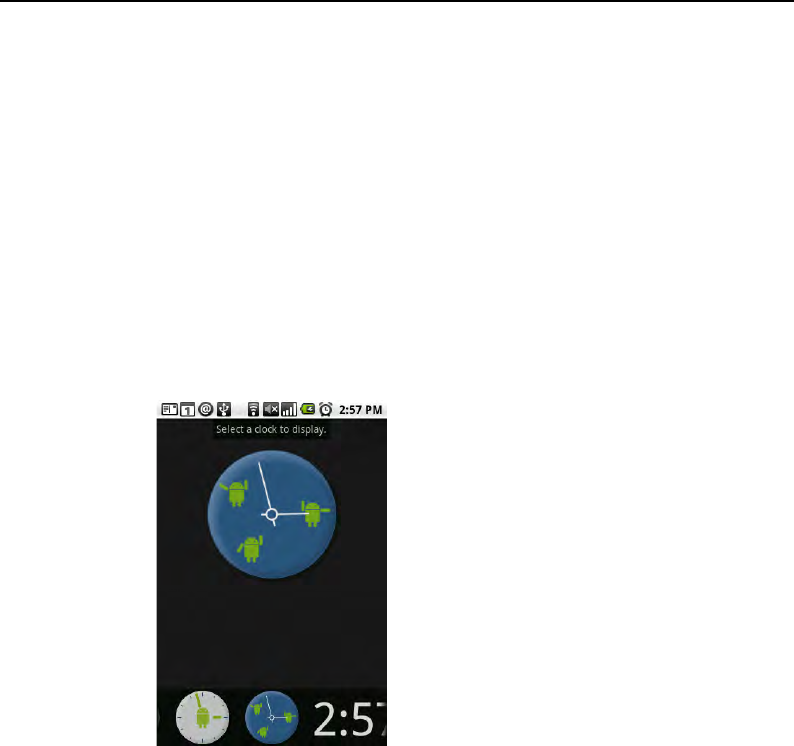
Alarm Clock 242
AUG-2.0.0-100 Android User’s Guide
Customizing Alarm Clock
You can change the face of the alarm clock or hide the face entirely. You can also set
whether the alarm sounds when the phone is in silent mode.
You can change how times are displayed in Alarm Clock in the Settings applications.
See “Date & time settings” on page 276.
To change the face of the alarm clock
1Touch the clock face.
2Slide the small faces to the left or right until the face you want is displayed.
3Touch the face you want.
To hide the alarm clock face entirely
SPress MENU and touch Hide clock.
To play alarms even when the phone is in Silent mode
SPress MENU, touch Settings, and check Alarm in silent mode.
Or uncheck this option to honor silent mode. For more information on silent
mode, see “Sound & display settings” on page 262.
Scroll the faces to the left or
right to find the one you
want
Touch the face you want
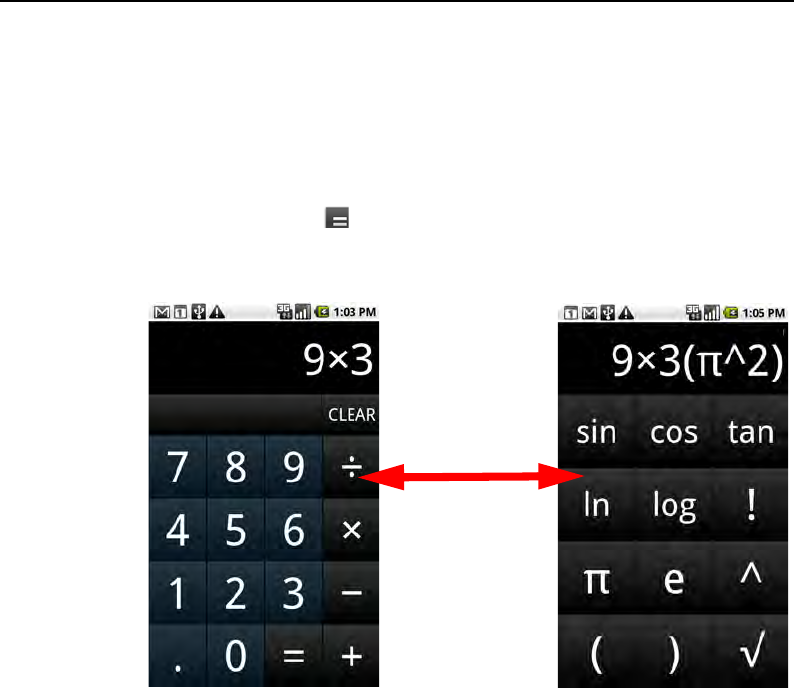
Calculator 244
AUG-2.0.0-100 Android User’s Guide
Using the Calculator
Use Calculator to figure math problems.
To open and use the Calculator
STouch the Calculator icon on the Home screen or in the Applications tab.
See “Opening and switching applications” on page 40 to learn more about
opening and switching applications.
SEnter numbers and arithmetic operators on the basic screen.
SDrag the basic screen to the left to open the advanced screen.
STouch and hold the Calculator’s display to open a menu where you can copy
what you’ve entered and access other tools.
STouch Clear to delete the last number or operator you entered. Touch & hold
Clear to delete everything in the display.
To access your history of operations
SRoll the TRACKBALL up or down to view your previous operations.
Previous operations are entered in the display, where you can use them.
SClear your history by pressing MENU and touching Clear history.
Drag to switch
between basic and
advanced screens.

245
AUG-2.0.0-100 Android User’s Guide
Market
Android Market provides direct access to useful applications and fun
games, which you can download and install on your phone.
In this section
“Opening Android Market and finding applications” on page 246
“Downloading and installing applications” on page 249
“Managing your downloads” on page 251
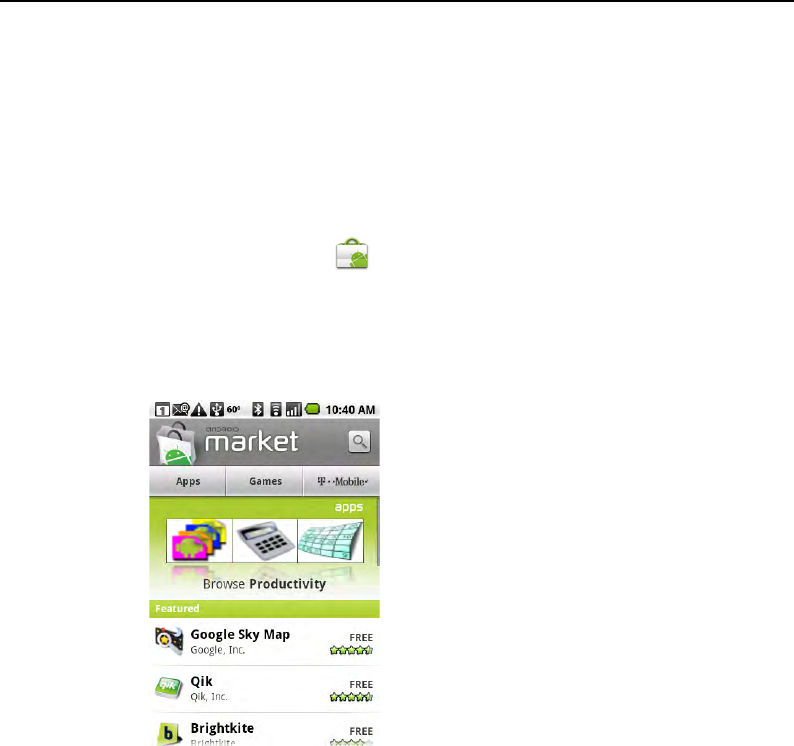
Market 246
AUG-2.0.0-100 Android User’s Guide
Opening Android Market and finding
applications
You can open Android Market to browse and search for free and paid applications.
To open Android Market
STouch the Market icon on the Home screen or in the Applications tab.
See “Opening and switching applications” on page 40 to learn more about
opening and switching applications.
When you open Android Market for the first time, you must read and accept
the terms of service to continue.
To get help with Android Market
The Android Market Help webpages are available from all Android Market screens.
SPress MENU and touch Help.
The Browser application opens to the Android Market help page, with links to
many help topics. (For more on using the Browser, see“Browser” on page 177.)
To browse for applications
You can browse applications by category and sort them in different ways.
Touch to search Market
Touch a category to open
it
Touch a featured
application to open
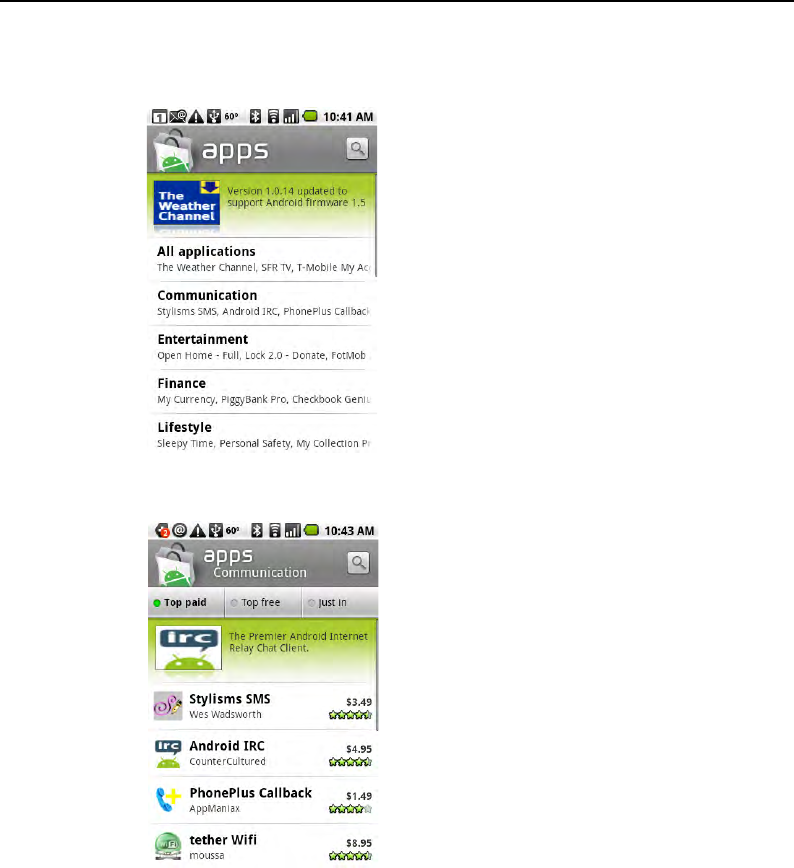
Market 247
AUG-2.0.0-100 Android User’s Guide
1On the Android Market home page, touch a top-level category, such as Apps or
Games.
2Scroll to view subcategories and the touch the one you want to explore.
3Touch Top paid, Top free, or Just in to further sort the subcategory.
To open a screen with details about an application
SAt any time when browsing Android Market, touch an application to open its
details screen.
Application details screens include a description, ratings, comments, and related
information about the application. You can install the application from this
Touch a subcategory to view
its list of applications
Touch a tab to view top paid, top
free, or recent applications in this
subcategory
Touch an application to open its
details screen.

Market 248
AUG-2.0.0-100 Android User’s Guide
screen (see “Downloading and installing applications” on page 249). You can also
rate, uninstall, and perform other actions on the application (see “Managing
your downloads” on page 251).
To search for applications
1Touch the search icon at the top-right of the screen or press the SEARCH
button.
2Enter what you want to search for and touch search icon again.
Enter all or part of the text in an application’s name, description, or the
developer’s name you want to search for.
3Touch a search result to open that application’s details screen.
The details screen describes the application and includes buttons for
downloading the application and performing other tasks (see “Downloading and
installing applications” on page 249 and “Managing your downloads” on
page 251).
To return to the Android Market home screen
You can return to the home screen from most other screens in Android Market.
STouch the Market icon at the top-left of the screen.
OR
SPress MENU and touch Home.
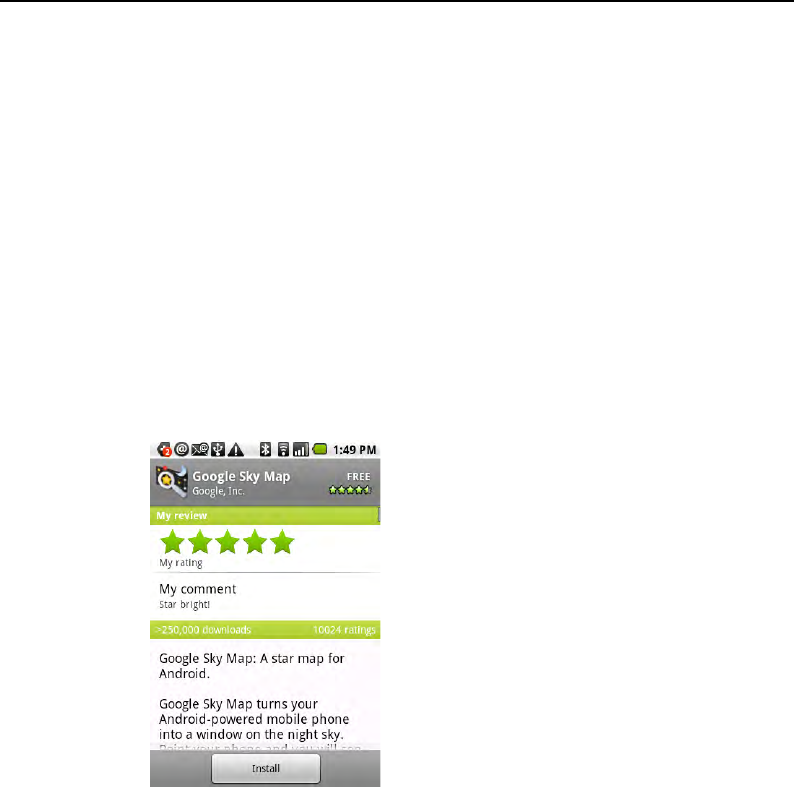
Market 249
AUG-2.0.0-100 Android User’s Guide
Downloading and installing applications
When you find an application you want, you can install it on your phone.
To download and install an application
Before you can download a paid application, you must set up a billing arrangement,
as described in “To create a Google Checkout account” on page 250.
1Find the application you want and open its details screen.
See “Opening Android Market and finding applications” on page 246.
In the item details screen, you can read more about the application, including its
cost, overall rating, and comments by users. If you scroll down to the About
the developer section, you can view more applications by this developer, visit
the developer’s web site, or send the developer an email message.
2Press MENU and touch Security to preview the functions and data the
application can access on your phone if you install it.
If you’re not comfortable with the access the application requires, don’t
continue.
3Touch Install (for free applications) or Buy (for paid applications).
If the application requires access to your data or control of any functions on
your phone, Market tells you what the application can access.
Scroll an application’s details screen to learn
more about the application, the developer,
and what others think o fit.
Touch to download and install the
application (if it’s a paid application, the
button is labeled Buy)

Market 250
AUG-2.0.0-100 Android User’s Guide
Warning! Read this screen carefully! Be especially cautious with applications that have access
to many functions or a significant amount of your data. Once you touch OK on this
screen, you are responsible for the results of using this item on your phone.
4Touch OK if you agree to the application’s access requirements.
If you selected a paid application, you’re redirected to a Google Checkout
screen to pay for the application before it’s downloaded to your phone.
If you selected a free application (or after you touched Buy now in Google
Checkout), you receive a series of notifications as the application is downloaded
and then installed on your phone (see “Managing notifications” on page 46).
When the application is installed, you can touch the notification to open the
application, or open it by touching its icon in the Applications tab (see “Opening
and switching applications” on page 40).
You have 24 hours to try out an application and if you decide you don’t want it,
uninstall it for a refund. See “To request a refund for an application” on
page 251.
If you have another Android phone, you can download a paid application to that
phone using the same Android Market account, at no additional charge.
To create a Google Checkout account
You must have a Google Checkout account associated with your Google Account
to purchase items from Android Market (of course, this is not necessary for free
items).
SUse your computer’s web browser to visit http://checkout.google.com, to
establish a Google Checkout account.
OR
SThe first time you buy an item from Android Market, you’re prompted to set up
a Google Checkout account, by entering your billing information.
Warning! Once you’ve used Google Checkout once to purchase an application from Android
Market, the phone remembers your password, so you don’t need to enter it the
next time. For this reason, you should secure your phone to prevent others from
using it without your permission. For details, see “Locking your screen” on page 51.

Market 251
AUG-2.0.0-100 Android User’s Guide
Managing your downloads
Once you’ve downloaded and installed an application, you can rate it, view it in a list
with your other downloaded applications, and so on.
To view your downloaded applications
You can view a list of the applications you’ve downloaded from Android Market, and
use the list for a number of purposes.
SOn the Android Market home screen, press MENU and touch Downloads.
In the list of the free and paid applications that opens, you can touch one to rate
it, uninstall it, request a refund, and so on.
To uninstall an application
1On the Android Market home screen, press MENU and touch Downloads.
2Touch the application you want to uninstall.
The details screen for the application opens.
3Touch Uninstall.
4Touch OK in the confirmation dialog.
5Touch the explanation that best matches why you’re uninstalling and touch OK.
The application is uninstalled. You can install the application again at any time—
without charge if it was a paid application.
To request a refund for an application
If you are not satisfied with an application, you can ask for a refund within 24 hours
of the purchase. Your credit card will not be charged and the application is
uninstalled from your phone.
If you change your mind, you can install the application again, but you can’t request
a refund a second time.

Market 252
AUG-2.0.0-100 Android User’s Guide
1On the Android Market home screen, press MENU and touch Downloads.
2Touch the application you want to uninstall for a refund.
The details screen for the application opens.
3Touch Uninstall & refund.
Your application is uninstalled and the charge is cancelled.
4Touch the explanation that best matches why you’re uninstalling and touch OK.
To set whether you’re notified about updated applications
1On the Android Market home screen, press MENU and touch Downloads.
2Press MENU and touch Notifications.
3Select the option to be notified of updates to the applications you’ve
downloaded, or not.
4Touch OK.
To rate an application
You can award an application from one to five stars and share what you think about
an application with other shoppers.
1Open the details screen for an application.
You can do this by browsing or searching for the application and then touching
it, or if you’ve downloaded the application, by touching it in the list of your
downloaded applications.
2Touch the stars under My review.
3Touch the number of stars you want to award the application and touch OK.
4Back on the details screen, touch Post a comment if you want to share a
comment about the application.
To flag inappropriate applications
If you discover an application with graphically violent, sexual, or otherwise hateful
or offensive content, you can report it to the Android Market team.

Market 253
AUG-2.0.0-100 Android User’s Guide
1Open the details screen for an application.
You can do this by browsing or searching for the application and then touching
it, or if you’ve downloaded the application, by touching it in the list of your
downloaded applications.
2Scroll to the bottom of the details screen and touch Flag as inappropriate.
3Touch the reason you find the application objectionable.
4Touch Submit.
Your comments are sent to the Android Market team.

Market 254
AUG-2.0.0-100 Android User’s Guide

255
AUG-2.0.0-100 Android User’s Guide
Settings
You use the Settings application to configure how your phone looks,
sounds, communicates, and operates in many other ways.
Many applications also have their own settings; see the sections about
those applications to learn more.
In this section
“Opening Settings” on page 256
“Wireless & networks” on page 257
“Call settings” on page 260
“Sound & display settings” on page 262
“Location & security settings” on page 264
“Applications settings” on page 266
“Accounts & sync settings” on page 268
“Privacy settings” on page 269
“SD card & phone storage settings” on page 270
“Search settings” on page 271
“Language & keyboard settings” on page 272
“Accessibility settings” on page 274
“Text-to-speech settings” on page 275
“Date & time settings” on page 276
“About phone” on page 277

Settings 256
AUG-2.0.0-100 Android User’s Guide
Opening Settings
The Settings application contains most of the tools for customizing and configuring
your phone.
To open Settings
SPress HOME, press MENU, and touch Settings.
OR
STouch the Settings icon on the Home screen or in the Applications tab.
See “Opening and switching applications” on page 40 to learn more about
opening and switching applications.
All the settings in the Settings application are detailed in this section.

Settings 257
AUG-2.0.0-100 Android User’s Guide
Wireless & networks
Use Wireless & network settings to configure and manage connections to networks
and devices via Wi-Fi, Bluetooth, and mobile networks. You also use Wireless
controls to configure connections between your phone and virtual private networks
(VPNs) and for turning off all radios with airplane mode.
Wireless controls screen
Wi-Fi Check to turn on Wi-Fi so you can connect to Wi-Fi networks.
Wi-Fi settings See “Wi-Fi settings screen” on page 257.
Bluetooth Check to turn on Bluetooth so you can connect to Bluetooth
devices.
Bluetooth settings See “Bluetooth settings screen” on page 258.
VPN settings See “VPN settings screen” on page 258.
Mobile networks See “Mobile networks settings screen” on page 259.
Airplane mode Check to turn off all wireless radios, to comply with
regulations on airplanes and other locations.
Wi-Fi settings screen
In addition to these settings, you can press Menu on this screen and touch
Advanced configure the settings described in “Advanced Wi-Fi settings screen” on
page 258.
Wi-Fi Check to turn on Wi-Fi so you can connect to Wi-Fi networks.
Network notification Check to receive an alert when an open Wi-Fi
network becomes available.
Wi-Fi networks Displays a list of Wi-Fi networks you’ve previously configured
and those detected when the phone last scanned for Wi-Fi networks. For details,
see “Connecting to Wi-Fi networks” on page 60.
Add Wi-Fi network Opens a dialog where you can add a Wi-Fi network by
entering its SSID (the name it broadcasts) and security type. See “Connecting to
Wi-Fi networks” on page 60.

Settings 258
AUG-2.0.0-100 Android User’s Guide
Advanced Wi-Fi settings screen
Regulatory domain Opens a dialog where you can override your phone’s
default settings for the number of Wi-Fi channels, which is regulated differently in
different locations.
Wi-Fi sleep policy Opens a dialog where you can set whether and when the
Wi-Fi radio disconnects. Disabling sleep uses more battery power.
MAC address The MAC address of your phone when connecting to Wi-Fi
networks.
IP settings If you check Use static IP, you can use the settings in this section
to enter an IP address and other network settings for you phone manually, rather
than using the DHCP protocol to obtain network settings from the W-Fi network
itself.
Bluetooth settings screen
Bluetooth Check to turn on Bluetooth so you can connect to Bluetooth
devices.
Device name Opens a dialog where you can give your phone a name that is
visible on some Bluetooth devices when you pair them. The current name is
displayed.
Discoverable Check to make your phone discoverable by other Bluetooth
devices for 120 seconds.
Scan for devices Touch to search for and display information about nearby
Bluetooth devices.
Bluetooth devices Displays a list of Bluetooth devices you’ve previously
configured and those detected when the phone last scanned for Bluetooth devices.
For details, see “Connecting to Bluetooth devices” on page 63.
VPN settings screen
Add VPN Opens a screen that prompts you to select the type VPN you want to
add, which then prompts you for VPN configuration details. See “Connecting to
virtual private networks” on page 68.

Settings 259
AUG-2.0.0-100 Android User’s Guide
VPNs The list of VPNs you’ve previously configured. For details, see “Connecting
to virtual private networks” on page 68.
Mobile networks settings screen
<<This screen has different features, depending on the device. These options are
for GSM phones. CDMA has only Data roaming and “System select” which needs
editing.>>
Data roaming Uncheck to prevent your phone from transmitting data on
mobile networks via other carriers’ networks, when you leave an area with your
own carrier’s mobile networks. See “To disable data when roaming” on page 58.
Use only 2G networks
Check to obtain slightly better battery life, by preventing your phone from
connecting to higher-speed networks. See “To limit your data connection to 2G
networks” on page 59.
Network operators Opens a screen that searches for and then displays
mobile networks that are compatible with your phone. Consult your carrier to
understand the billing implications of selecting a another carrier.
Access Point Names Opens the APNs screen, where you can select mobile
access point configurations or press Menu to add a new one. Use the tools on this
screen under the direction of your carrier.

Settings 260
AUG-2.0.0-100 Android User’s Guide
Call settings
Use Call settings to configure phone call settings, such as call forwarding and call
waiting or other special features offered by your carrier. You can also use Call
settings to configure the phone so it can place outgoing calls to a fixed set of phone
numbers.
Call settings screen
Fixed Dialing Numbers <<Confirm against device>>See “Fixed Dialing
Numbers screen” on page 260.
Voicemail service Opens a dialog where you can enter the phone number you
want to use for listening to and managing your voicemail.<<Confirm against
device.>>
Voicemail settings Opens a screen where you can configure your selected
voicemail service.
Additional settings
<<These depend on your carrier. CDMA appears to add Auto Retry, TTY mode,
Hearing aids, DTMF Tones, Voice Privacy. They need to be sentence style.>>
Call forwarding Opens a screen where you can configure details for how your
phone forwards calls when you’re on the phone, when you don’t answer, and so on.
Caller ID Opens a dialog with where you can set whether your phone number
is displayed to the people you call.
Call waiting Check to see and be able to respond to calls you receive when
already on a call, as described in “Placing and receiving calls” on page 71.
Fixed Dialing Numbers screen
<<Confirm against device>>You can use the settings on this screen to configure
your phone so it can place outgoing calls to only the FDN numbers you save on the
phone’s SIM.
Enable FDN Opens a dialog that asks you to enter your PIN2 and then places
the phone in FDN mode. Changes to Disable FDN when FDN is enabled.

Settings 261
AUG-2.0.0-100 Android User’s Guide
Change PIN2 Opens a series of dialogs that prompt you to enter your current
PIN2 and then enter and confirm a new PIN2.
FDN list Opens a screen that lists any FDNs saved on your SIM. Press MENU
and touch Add contact to add an FDN number to your SIM; press MENU on
that screen to import a number from your Contacts for use as an FDN, or to delete
a number from the FDN list.

Settings 262
AUG-2.0.0-100 Android User’s Guide
Sound & display settings
Use the Sound & display settings to configure many aspects of call and notification
ringtones, music and other audio, as well as the brightness and other screen
settings.
Sound & display settings screen
Silent mode Check to silence all sounds (including call and notification
ringtones) except the audio from music, movies, and other media and any alarms
you have set (you must silence media and alarms in their own applications).
Ringer volume Opens a dialog where you can drag a slider to set the volume
of ringtones that sound when you receive a phone call or notification. You can
uncheck the option to use the same volume for both calls and notifications, to
reveal a slider you can drag to set the notification ringtone volume separately.
Media volume Opens a dialog where you can drag a slider to set the volume
for music, video soundtracks, and other media.
Phone ringtone Opens a dialog where you can pick the ringtone to sound
when you receive a phone call. You can touch a ringtone to listen to it. See “To use
a song as a ringtone” on page 234 to learn how to add your own music to this list.
Phone vibrate Check to vibrate the phone when you receive an incoming call,
independent of your ringtone or volume settings.
Notification ringtone Opens a dialog where you can pick the ringtone to
sound when you receive a phone call. You can touch a ringtone to listen to it.
Audible touch tones Check to hear tones when you use Phone to dial a
number (see “Placing and ending calls” on page 72).
Audible selection Check to play a sound when you touch buttons, icons, and
other onscreen items that react to your touch.
Haptic feedback Check to vibrate the phone briefly when you touch softkeys
and perform other actions with the phone.
SD card notifications Check to play a sound when you receive SD card
notifications.

Settings 263
AUG-2.0.0-100 Android User’s Guide
Emergency tone Opens a dialog where you can configure how the phone
reacts when you place an emergency call.<<Confirm with device.>>
Orientation Check to switch the screen to landscape mode or portrait mode
automatically, when you turn the phone sideways or upright.
Animation Check to enjoy animated transitions when navigating from screen to
screen.
Brightness Check to open a dialog with a slider for adjusting the screen
brightness. For the best battery performance, use the dimmest comfortable
brightness.
Screen timeout Opens a dialog where you can set how long to wait after you
last touch the screen or press a button before the screen darkens. For the best
battery performance, use the shortest convenient timeout Avoid the Never
timeout setting: it can drain your battery quickly and risks leaving a permanent
image on your screen.

Settings 264
AUG-2.0.0-100 Android User’s Guide
Location & security settings
Use the Security & location settings to set your preferences for using and sharing
your location when your search for information and use location-aware applications,
such as Maps, and to configure settings that help secure your phone and its data.
Use wireless networks Check to use information from Wi-Fi and mobile
networks to determine your approximate location, for use in Maps, when you
search, and so on. When you check this option, you’re asked if you consent to
sharing your location anonymously with Google’s location service.
Use GPS satellites Check to use your phone’s global positioning system
(GPS) satellite receiver to pinpoint your location to within an accuracy as close as
several meters (“street level”). Actual GPS accuracy is dependent on a clear view of
the sky and other factors.
Set unlock pattern Opens a set of screens that guide you through the
process of drawing a screen unlock pattern, as described in “Locking your screen”
on page 51.
Require pattern Uncheck to stop requiring an unlock pattern to unlock your
screen. You must draw your current pattern when you uncheck this option.
Use visible pattern Check to draw lines between the unlock pattern you
draw.
Use tactile feedback Check to vibrate the phone briefly as you touch each
dot when you draw an unlock pattern.
Set up SIM card lock <<Not for CDMA>>Opens a screen where you can
configure the phone to require entering the SIM PIN to use the phone, and where
you can change the SIM PIN.
Visible passwords Check to briefly show each character of passwords as you
enter them, so you can more easily check what you enter.
Use secure credentials Check to allow applications to access your phone’s
encrypted store of secure certificates and related passwords and other credentials.
You use the credential storage to establish some kinds of VPN connections (see
“Connecting to virtual private networks” on page 68). This setting is dimmed if you
have not yet set a password for the credential storage.

Settings 265
AUG-2.0.0-100 Android User’s Guide
Set password Opens a dialog where you can set or change the password for
your secure credential storage. Your password must have at least 8 letters or
numbers and may not contain spaces or other special characters.
Clear storage Deletes all secure certificates and related credentials and erases
the secure storage’s own password, after asking you to confirm you want to do this.

Settings 266
AUG-2.0.0-100 Android User’s Guide
Applications settings
Use the Applications settings to view details about the applications installed on
your phone, to manage their data and force them to stop, and to set whether you
want to permit installation of applications you obtain web sites and email.
Applications settings screen
Unknown sources Check to permit installation of applications you obtain
from web sites, email, or other locations other than Android Market.
Warning! To protect your phone and personal data, download applications only from trusted
sources, such as Android Market.
Quick launch If you phone has a physical keyboard, opens the Quick launch
screen, which lists keys you can press in combination with your keyboard’s Search
key as a shortcut for launching applications. Touch a letter to open a screen where
you can assign an application to open when you press Search and that letter at the
same time.
Manage applications Opens a list of all the applications and other software
installed on your phone, along with its size. By default, only downloaded
applications are shown and they are sorted in alphabetical order. Press MENU and
touch Filter to change the list to show all applications, only running applications, or
just downloaded applications. Press MENU and touch Sort by size to display
applications in size order. Touch an application to open its Application info screen
(see “Application info screen” on page 266).
Running services Opens a list of services: applications or parts of applications
that provide services to other applications or that run even when their main
application isn’t. Examples include the Android onscreen keyboard and the small
portion of Google Talk that always listens for incoming messages. Above each
service, one or more gray bars show what processes the running service needs and
how much memory they’re using (and how much you’d recover if you stopped the
service). Depending on the service, when you touch it in the list it either opens a
dialog you can use to stop it or it opens its Settings screen.
Development See “Development screen” on page 267.
Application info screen
The Application info screen for each application lists its name and version, along
with many details about the application. Depending on the application and where it

Settings 267
AUG-2.0.0-100 Android User’s Guide
came from, it may also include buttons for managing the application’s data, forcing
the application to stop, and for uninstalling the application. It also lists details about
the kinds of information about your phone and your data the application has access
to.
Storage Details about the amount of phone storage used by the application. If
you installed the application from Android Market or another source, includes and
Uninstall button you can use to remove the application and all of its data and
settings from the phone. (See “Market” on page 245 for more information on
uninstalling and reinstalling applications.)
Cache If the application stores data in a temporary area of the phone's memory,
lists how much information is stored and includes a button for clearing it.
Launch by default If you have configured an application to launch certain file
types by default, you can clear that setting here.
Controls Use the Force stop button to stop an application that is
misbehaving. The application is stopped without confirmation.
Permissions Lists the kinds of information about your phone and data the
application has access to.
Development screen
The Development screen contains settings that are useful for developing Android
applications. For more information, including documentation of the Android APIs
and development tools, see the Android developer web site (http://
developer.android.com).
USB debugging Check to permit debugging tools on computer to
communicate with your phone via a USB connection.
Stay awake Check to prevent the screen from dimming and locking, when the
phone is connected to a charger or to a USB device that provides power. Avoid
using this setting with a static image on the phone for long periods or time, or you
risk marking the screen with that image.
Allow mock locations Check to permit a development tool on a computer
to control the where the phone believes it is located, rather than using the phone’s
own internal tools for this purpose.

Settings 268
AUG-2.0.0-100 Android User’s Guide
Accounts & sync settings
Use the Accounts & sync settings to add, remove, and manage your Google and
other supported accounts. You also use these settings to control how and whether
all applications send, receive, and sync data on their own schedules, and whether all
applications can synchronize user data automatically.
Gmail, Calendar, and other applications may also have their own settings to control
how they synchronize data: see the sections on those applications for details.
Accounts & sync settings screen
Background data Check to permit applications to synchronize data in the
background, whether or not you are actively working in them. Unchecking this
setting can save battery power and lowers (but does not eliminate) data use.
Auto-sync
Check to permit applications to synchronize data on their own schedule. If you
uncheck this setting, you must touch an account in the list on this screen, press
Menu, and touch Sync now to synchronize data for that account. Synchronizing
data automatically (and this checkbox) is disabled if Background data is
unchecked.
Manage accounts
The remainder of this screen lists the Google and other accounts you’ve added to
the phone. Adding accounts is described in “Accounts” on page 105.
If you touch an account in this screen, its account screen opens.
Account screen
This screen is different, depending on the kind of account.
For Google accounts, it lists the kinds of data you can synchronize to the phone,
with check boxes so you can turn synchronizing on and off for each kind. You can
also press Menu and touch Sync now to synchronize data. Touch the Remove
account button to remove the account along with all its data (contacts, mail,
settings, and so on). You can’t remove the first Google Account you added to your
phone except by resetting your phone to factory defaults and erasing all your user
data (see “Privacy settings” on page 269).

Settings 269
AUG-2.0.0-100 Android User’s Guide
Privacy settings
Use the Privacy settings to manage your personal information.
Use My Location Check to include your position when using Google search
and other Google services. When you check this option, you’re asked if you
consent to allowing Google to use your location when providing these services.
Back up my settings Check to back up your phone’s settings to Google
servers, with your Google Account. If you replace your phone, the settings you’ve
backed up are restored onto the new phone when you sign in with your Google
Account. If you check this option, a wide variety of settings are backed up, including
your Wi-Fi passwords, bookmarks, a list of the applications you’ve installed, the
words you’ve added dictionary used by the onscreen keyboard, and a most of the
settings you configure with the Settings application. If you uncheck this option, you
stop backing up your settings and any existing backups are deleted from Google
servers.
Factory data reset Erases all your personal data from internal phone storage,
including information about your Google Account, any other accounts, your system
and application settings, and any downloaded applications. Resetting the phone does
not erase any system software updates you’ve downloaded or any files on your SD
card (such as music or photos). If you reset the phone in this way, you’re prompted
to reenter the same kind of information as when you first started Android (see
“Launching Android the first time” on page 26).

Settings 270
AUG-2.0.0-100 Android User’s Guide
SD card & phone storage settings
Use the SD card & phone storage settings to monitor the used and available space
on your phone and on your SD card, to manage your SD card, and if necessary, to
reset the phone, erasing all of your personal information.
SD card & phone storage screen
SD card, Total space and Available space Lists the amount of space on
any SD card installed in your phone and the amount you have used to store pictures
or videos you’ve taken, music you’ve installed, and other files. For more
information, see “Connecting to a computer via USB” on page 66 and “Your phone
and accessories” on page 19, as well as the sections for the applications that store
media and other files on the SD card.
Unmount SD card Unmounts the SD card from your phone, so you can safely
remove it when the phone is on or to format the card. This setting is dimmed if
there is no SD card installed, if you have already unmounted it, or if you have
mounted the SD card on your computer (see “Connecting to a computer via USB”
on page 66).
Format SD card Permanently erases everything on an SD card and prepares it
for use with your phone. You must unmount an SD card before you can format it.
Internal phone storage, Available space The amount of internal phone
storage used by the operating system, its components, applications (including those
you downloaded), and their permanent and temporary data.

Settings 271
AUG-2.0.0-100 Android User’s Guide
Search settings
Use Search settings to configure Google search, Quick Search Box, and what data
on the phone you want to include in searches. For more information, see “Searching
your phone and the web” on page 48.
Search settings screen
Google search settings Opens a screen where you can set your preferences
for whether Google search on the web makes suggestions below Quick Search Box
and whether the suggestions take into account your previous searches. Also offers
the ability to open the Google web search history settings page in Browser.
Searchable items Opens a screen where you can check or uncheck the kinds
of data you want to include in phone searches.
Clear search shortcuts Erases the list of search results that you touched
below Quick Search Box.

Settings 272
AUG-2.0.0-100 Android User’s Guide
Language & keyboard settings
Use the Language & keyboard settings to pick which language you prefer for the
text on your phone, and for configuring the onscreen keyboard, including words
you’ve added to its dictionary.
Language & keyboard screen
Select locale Opens the Locale screen, where you can select the language you
want for the text on your phone.
Android keyboard For phones with physical keyboards, uncheck to disable
the onscreen keyboard.
Android keyboard See “Android keyboard settings screen” on page 272.
Device keyboard See “Device keyboard settings screen” on page 273. This
setting is only available if your phone has a physical keyboard.
User dictionary Opens a list of the words you’ve added to the dictionary, as
described in “Using the onscreen keyboard” on page 35. Touch a word to edit or
delete it. Press MENU and touch Add to add a word.
Android keyboard settings screen
The Android keyboard settings apply to the onscreen keyboard that is included with
your phone. The correction and capitalization features affect only the English
version of the keyboard.
Vibrate on keypress Check to vibrate the phone briefly each time you touch
a key on the onscreen keyboard.
Sound on keypress Check to play a brief sound each time you touch a key on
the onscreen keyboard.
Auto-capitalization Check to have the onscreen keyboard automatically
capitalize the first letter of the first word after a period, the first word in a text
field, and each word in name fields.
Quick fixes Check to automatically correct some common misspellings as you
type.

Settings 273
AUG-2.0.0-100 Android User’s Guide
Show suggestions Check to show suggested words in a strip above the
onscreen keyboard as you type (see “Using the onscreen keyboard” on page 35).
Auto-complete Check to cause the onscreen keyboard to enter the suggested
word (highlighted in orange in the strip above the keyboard) when you enter a
space or punctuation, if the onscreen keyboard is highly confident that the
suggested word is likely what you intend to type (see “Using the onscreen
keyboard” on page 35).
Device keyboard settings screen
This settings screen is only available if your phone has a physical keyboard.
Auto-replace Check to correct misspelled words as you type.
Auto-cap Check to capitalize the first letter of the first word in sentences.
Auto-punctuate Check to insert a period ( . ) if you press the Space key twice
in a row.

Settings 274
AUG-2.0.0-100 Android User’s Guide
Accessibility settings
Use the Accessibility settings to configure any accessibility plug-ins you have
installed on your phone.
Accessibility Check to enable any installed accessibility plug-ins.
KickBack Check to vibrate the phone briefly as feedback as you navigate the
phone’s user interface, press buttons, and so on.
TalkBack Check to cause an installed speech synthesizer to speak the labels or
names of items as you navigate the phone’s user interface.
SoundBack Check to play a sound as you navigate the phone’s user interface.

Settings 275
AUG-2.0.0-100 Android User’s Guide
Text-to-speech settings
You use the Text-to-speech settings to configure the Android text-to-speech
synthesizer, for applications that can take advantage of it (such as TalkBack,
described in “Accessibility settings” on page 274).
Text-to-speech settings screen
Only the Install voice data setting is available if you don’t have speech
synthesizer data installed.
Listen to an example Plays a brief sample of the speech synthesizer, using
your current settings.
Install voice data If your phone does not have speech synthesizer data
installed, connects to Android Market and guides you through the process of
downloading and installing the data. This setting is not available if the data is
installed.
Always use my settings Check to use the settings on this screen in place of
speech synthesizer settings available in other applications.
Speech rate Opens a dialog where you can select how quickly you want the
synthesizer to speak.
Language Opens a dialog where you can select the language of the text you
want the synthesizer to read, so it is pronounced correctly. This is particularly
useful in combination with the Always use my settings setting, to ensure that text in
a variety of applications is spoken correctly.

Settings 276
AUG-2.0.0-100 Android User’s Guide
Date & time settings
Use Date & time settings to set your preferences for how dates are displayed. You
can also use these settings to set your own time and time zone, rather than
obtaining the current time from the mobile network.
Automatic Uncheck to set the date, time, and time zone on the phone
manually, rather than obtaining the current time from the mobile network.
Set date If Automatic is unchecked, opens a dialog where you can manually
set the phone’s date.
Select time zone If Automatic is unchecked, opens a dialog where you can
set the phone’s time zone.
Set time If Automatic is unchecked, opens a dialog where you can set the
phone’s time.
Use 24-hour format Check to display the time using 24-hour time format, for
example: 13:00, rather than 1:00 pm.
Select date format Opens a dialog where you can select which format you
prefer for displaying dates.

Settings 277
AUG-2.0.0-100 Android User’s Guide
About phone
The About phone settings include a wealth of information about your phone.
About phone screen
System updates Opens a window that reports on the availability of any
Android system software updates.
Status Opens the Status screen with a long list of information about your
battery, mobile network connection, and other details.
Battery use Opens a list of the applications and operating system components
you have used since you last connected the phone to a power source, sorted by the
amount of power they have used. You can touch an application in the list to view
details about its power use and, if available, touch a button to open a settings or
information screen for that component or application.
Legal information Opens a screen where you can obtain legal information
about the software included with your phone.
System tutorial Opens the screen that offers to introduce you to some of
your phone’s features, as described in “Launching Android the first time” on
page 26.
Version information Lists details about the model numbers and versions of
your phone’s hardware and operating system software. This information is useful if
you need to work with your carrier’s support team.

Settings 278
AUG-2.0.0-100 Android User’s Guide

279
AUG-2.0.0-100 Android User’s Guide
Specifications
<<This chapter to be completed by the phone manufacturer.>>

Specifications 280
AUG-2.0.0-100 Android User’s Guide





